Identification 3795
Here is a beautiful
superimposed rifle/carbine with locks by Jules Rosseel, barrels by Jean
Falla and engravings by V. Doyen. Gun butt of all beauty. It’s from 1955.
Jules Rosseel, an
armourer established at rue Bayfils, 1 in Tilff, was registered at the Liège
proofhouse from 1932 to 1956. It is already mentioned on the website
littlegun.be.
The barrels (one or
both) are the work of the well-known gunner Jean Falla (trade mark on the
photo after that of the engraver). See on littlegun.be.
There is, however, a
“serious” problem with this rifle, in that we see the Greek letter "mu" for
1955, but also the letter "c underlined" for 1968.
One of the caliber is
not clear (we consider the .22 Savage but without guarantee.
222 may/probably be a
manufacturing number.
The other punches are
classic.
GP with the help of HPH, PHL, MD, AD and AB and the whole team.
Identification 3798
Here is a very
classic Royal Irish Constabulary revolver, with safety on the left, that a
member of the team quickly and certainly with good reason attributed to
Nicolas Simonis : we find it on
a copy of S&W mentioned on the site :
"As for the caliber,
the Italian 10.4 seems unlikely for this type of weapon. Why not a more
classic 442 Webley since the 44 Russian (bullet: 10,9mm) room "comfortably"
and the 442's ball displays 11,07mm? continues the member.
Markings
D under star (on
barrel, barrel and frame): countermark of a controller, in use between 1877
and 1968;
V crowned on the
frame and barrel (right side): see the table below;
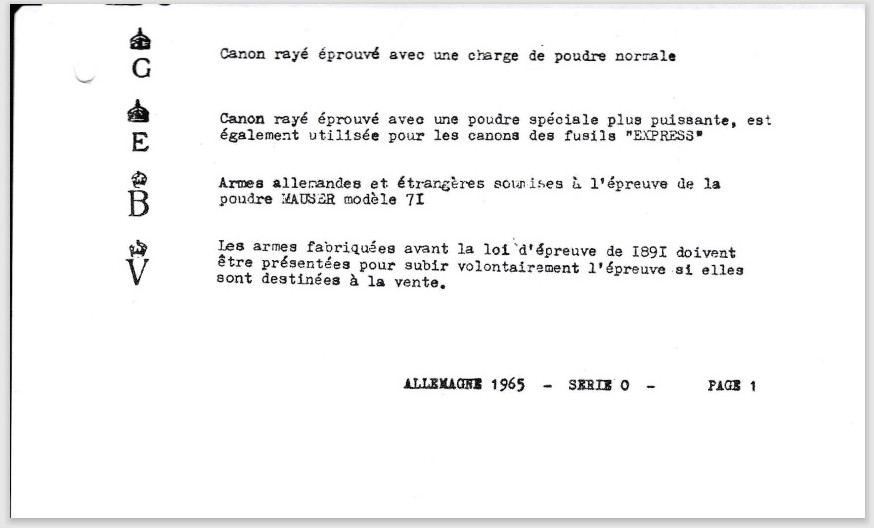
ELG on oval star, on
the barrel: accepted by the Liège proofhouse, in use between 1846 and 1893
NS under the left
plaque: initials of Nicolas Simonis.
The fact that this
revolver was sold in Germany also explains the presence of safety, the
Germans being fond of this “accessory” that can also be found on statutory
revolvers.
GP with the
help of Chris and HPH.
Identification 3799
Here is a so-called
"reinforced" revolver in calibre 8 mm Lebel sold by Manufrance.
Another revolver of
this type (but less beautiful...) has already been the subject of an article
on the site: see
http://www.littlegun.info/arme%20francaise/saint%20etienne/a%20manufrance%20revolver%20renforce%20gb.htm
As one team member
explains, it was developed from the BullDogs architecture to fit the
standard 8mm92 smokeless powder ammunition. These revolvers were produced
during the first quarter of the 20th century.
We see on the specimen
that occupies us now the same hallmarks of Liège R crowned (rifled barrel),
in use between 1894 and 1968 and the G under a star, countermark of a
controller of the proofhouse of Liège, in use between 1877 and 1968.
Here too, the ELG
acceptance stamp on a star in a crowned oval is missing!
There is not even a
Liège hallmark on the barrel, but the hallmark of the French Manufacture.
At first, I thought
the barrels were made in France. But the same member of the team confirms to
me that the barrel is indeed Belgian: “Manuf." used to order unmarked
weapons to stamp them in Saint-Etienne... »
GP with the
help of Chris.
Identification 3800
Voici un
très classique fusil de chasse à deux canons, crosse anglaise et chiens
extérieurs de la Fabrique d’Armes de Liège déjà évoquée sur le site :
www.littlegun.be/arme%20belge/artisans%20identifies%20e%20f/a%20fab%20armes%20liege%20fr.htm
Ce n’est
certainement pas la meilleure qualité de leur production, mais il est vrai
que ce fusil est plus que centenaire. La FAL a en effet été inscrite au Banc
d’Epreuves de Liège de 1900 à 1920.
Je n’ai
pas retrouvé la date de dépôt de la marque FAL surmontée du cheval Bayard et
des Quatre Fils Aymon ni de l’autre marque FAL dans un blason ornementé.
Les
marquages
ELG sur
étoile dans ovale couronné : acceptation, en usage de 1893 à 1968 ;
16 C dans
losange vertical : calibre, en usage de 1898 à 1924 ;
EL :
épreuve provisoire, en usage depuis 1858 ;
Perron :
inspection par le Banc d’Epreuves de Liège ;
M et q
sous étoile : contremarques de contrôleurs, en usage de 1877 à 1968
17.0 sur
17.0 : canon choké – mais il doit y avoir une erreur puisque le nombre est
le même, en usage de 1910 à 1924 ; cela nous permet de préciser que le fusil
a été présenté au BE de Liège entre 1910 et 1920 ;
ACL dans
un cercle : marque du canonnier Lochet-Habran.
GP
Identification 3801
Voici un
très classique petit revolver puppy à détente repliable et sécurité type
Mauser à gauche en calibre 320 de la maison Henrion, Dassy et Heuschen,
société en nom collectif, rue Chéri 22 à Liège, inscrite au Banc d’Epreuves
de 1910 à 1921. Elle est largement évoquée sur le site et dans la collection
exceptionnelle.
Les
marquages
ELG sur
étoile dans ovale couronné : acceptation, en usage de 1893 à 1968 ;
R
couronné : canon rayé, en usage de 1894 à 1968 ;
K sous
étoile : contremarque d’un contrôleur en usage de 11877 à 1968 ;
C
couronné : non identifié ; peut-être un poinçon allemand ?
GP
avec l’aide de HPH
Identification 3812
Here is a very classic
revolver pinfire made in Liège, as thousands were made, and this until the
First World War (the ammunition being plentiful and cheap...).
In any case, this
specimen is after July 11, 1893, as attested by the ELG stamp on a star in a
crowned oval.
We can even add six
months to it, since we also see the crowned R (striped canon), which was
introduced on January 30, 1894.
The crowned y is the
letter from a controller (after January 27, 1877).
The initials
EF could be related to
Emile Fraipont:
http://littlegun.be/arme%20belge/artisans%20identifies%20e%20f/a%20fraipont%20gb.htm
As for the inscription
on the barrel, mystery and gumball. One member sees Gilliquet in it, but I
find it very difficult to admit it.
GP with the
help of HPH, Chris and MD.
Identification 3813
Here is a flintlock rifle that looks very much like the Dutch rifle Mod.
1815.
However, there are doubts: the back sight
is
not usual, and the length of the barrel does not match: it measures 103 cm,
while the barrel of the Model 1 measures 111.1 cm. (I also found 111.8) and
the Model 2 108.4 cm.
The total length of the specimen presented is 144 cm, but I could not find
the respective total lengths of Models 1 and 2. A well-placed source
explained to me that the shortest model was intended for the first row of
soldiers, the longest for the second row... so the difference is about 3
cm... understand who will.
The following site gives a whole series of manufacturers
In my humble opinion, it could be a production by J. Devillers since we find
(especially) the initials JD. It was ordered in September 1814, so that this
rifle may have survived the Battle of Waterloo... You can still dream... but
you have to take into account the shorter barrel (at least 5 cm) and the
back sight...
GP with the help of MW.
Identification 3818
Here is a beautiful
shotgun juxtaposed with locks by Alphonse Forgeron dating from 1930, Barrels made in England, beautiful
engravings unfortunately not signed.
The chambers,
originally in calibre 12/65, were later lengthened to 70 mm (it seems
without going back to the proofhouse).
The punches
AC or FC spangled:
countermark of a controller, in use from 1877 to 1968;
Peron: inspection by
the Liège proofhouse;
Lion on PV: smoke-free
powder proof, in use from 1898 to 1968;
N in a shield : not
identified ;
1 Kg385 : weight of
the barrel, in use since 1924 ;
JSE in elongated oval:
not identified;
Annal Letter "i" of
1930;
Bow and arrow in hexagon : unidentified ; this mark has already been seen on a rifle of the house Pirotte & Fils :
see the link Pirotte & Fils
ELG on a star in a
crowned oval: accepted by the proofhouse of Liège, in use from 1893 to 1968;
12-65 in coated omega:
nominal caliber and length of the casing, in use since 1924;
Andrew WS Nickel
Toledo Steel Works Sheffield: a steelmaker from Sheffield.
Alphonse Forgeron, rue Adolphe Borgnet, 5 then 4 in Liège, was registered at the proofhouse between 1880 and 1932 , when his activities were taken over by Joseph Boulanger.
He filed two patents
and a trademark (October 18, 1902) which does not appear on this rifle.
GP with the
help of HPH.
Identification 3822
Here is a shotgun
corresponding to the shotgun by Edouard Malherbe and
Guillaume
Salle. They have already been the subject of several notices on the
website:
http
s://littlegun.be/arme%20belge/artisans%20identifies%20ma/a%20malherbe%20and%20salle%20gb.htm
For the sake of
completeness, they filed six patents together.
Two of these patents
relate to a "breech-toggle" rifle.
Below are the
drawings of these two patents, the original patent 028504 dated February 24,
1871 and 030264 dated March 21, 1872. I am not in a position to determine
which patent the "Romanian" rifle falls under. I assume the second ?
The mention Buescu
Brevetat seems to indicate that Vasile Buescu, born in 1846 and died on
March 1, 1883, made some modification to this rifle. But which one(s)? You'd
have to take it apart, but that's it. I presume that, as in the case of the
Comblain, there is no doubt that there is a reassembly tool, without which
the operation is “delicate” (charming euphemism...).
Mr. Buescu graduated
from the military school in Bucharest in 1867 and entered the artillery as a
second lieutenant. He left in 1871 to complete his studies in armoury in
Liège.
In 1875, he presented
a revolver system (based on the Chamelot-Delvigne) which was adopted in 1876
by the Romanian army. This earned him the Bene Morenti First Class Medal
(which had just been created that year).
He then served as
Deputy Director of the Bucharest Arsenal.
According to
Internet, a weapon (which ? revolver ? rifle ?) by Vasile Buescu is part of
the weapons collection of the castle of Peles in Sinaia (Romania).
I didn’t find
anything on the web about the patent for this rifle.
GP
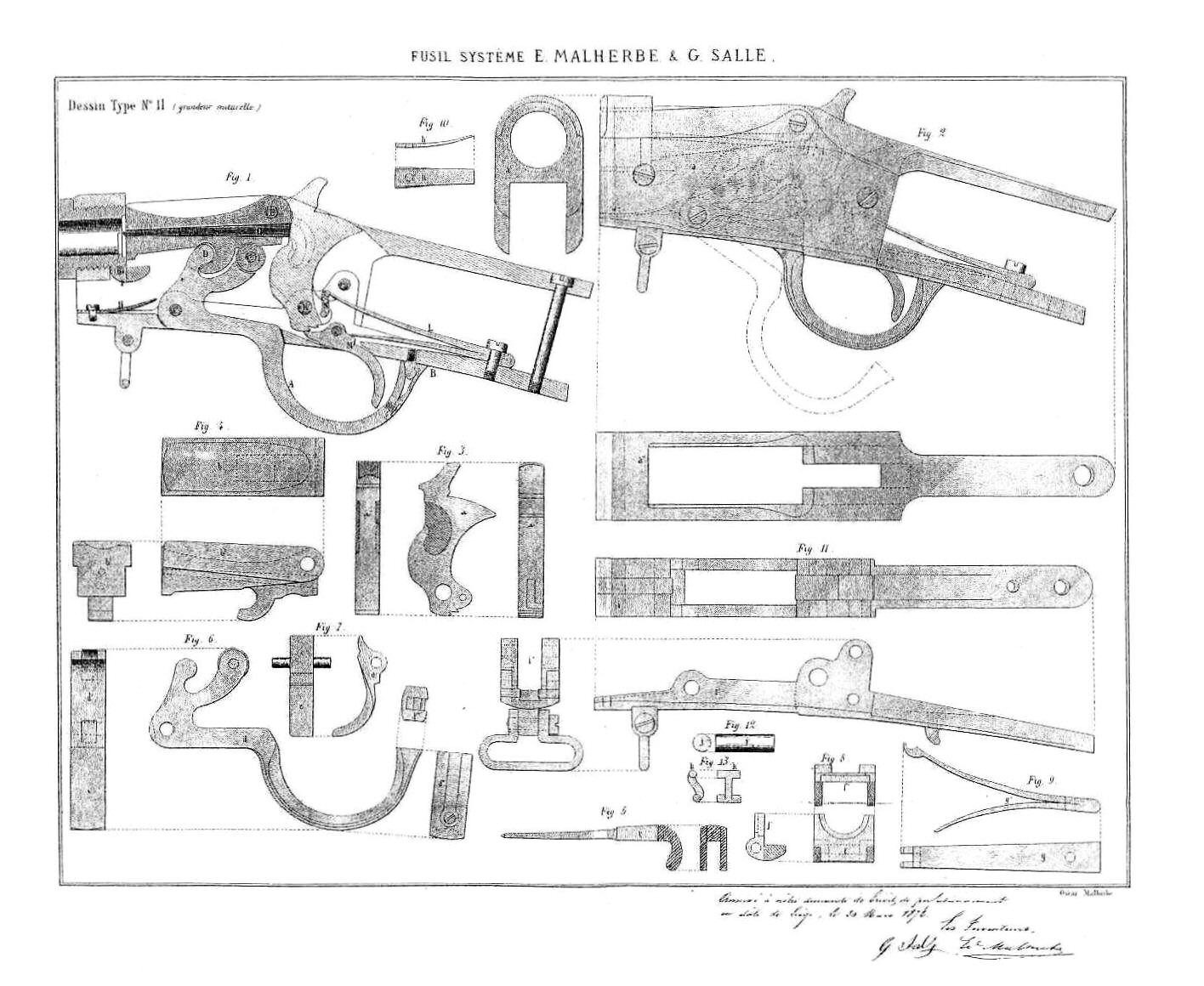

Identification 3825
Qualified as
"Apache", this "pistol shot out of ball" with dagger, known as "summoir
pistol" after its first inventor Louis Dolne-Bar, seems to be of the 2nd
model, i.e. perfected by patent 027218 of March 14, 1870. Caliber 7 mm with
pin.
Here is the patent
for improvement filed by Louis Dolne-Bar:
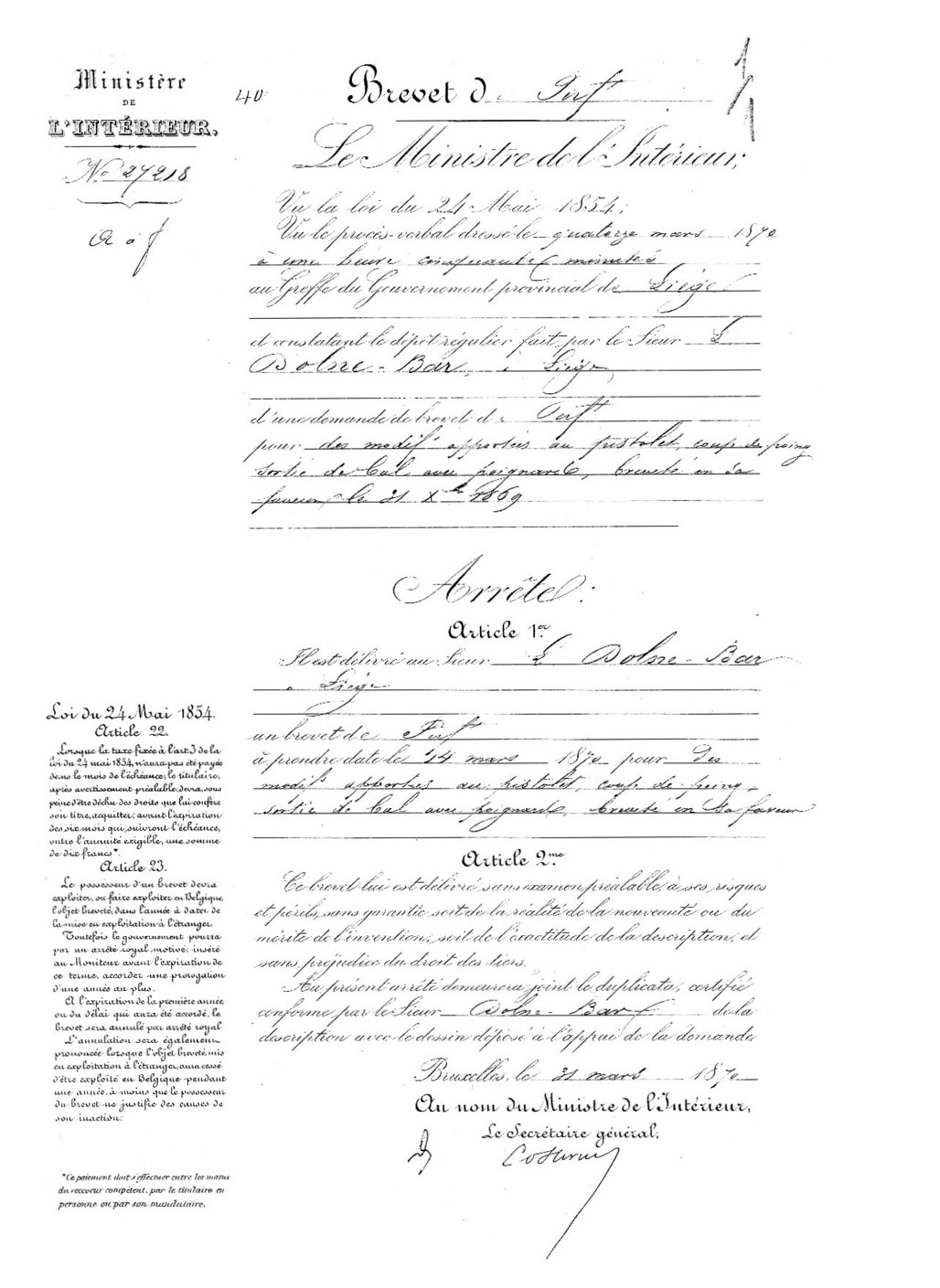
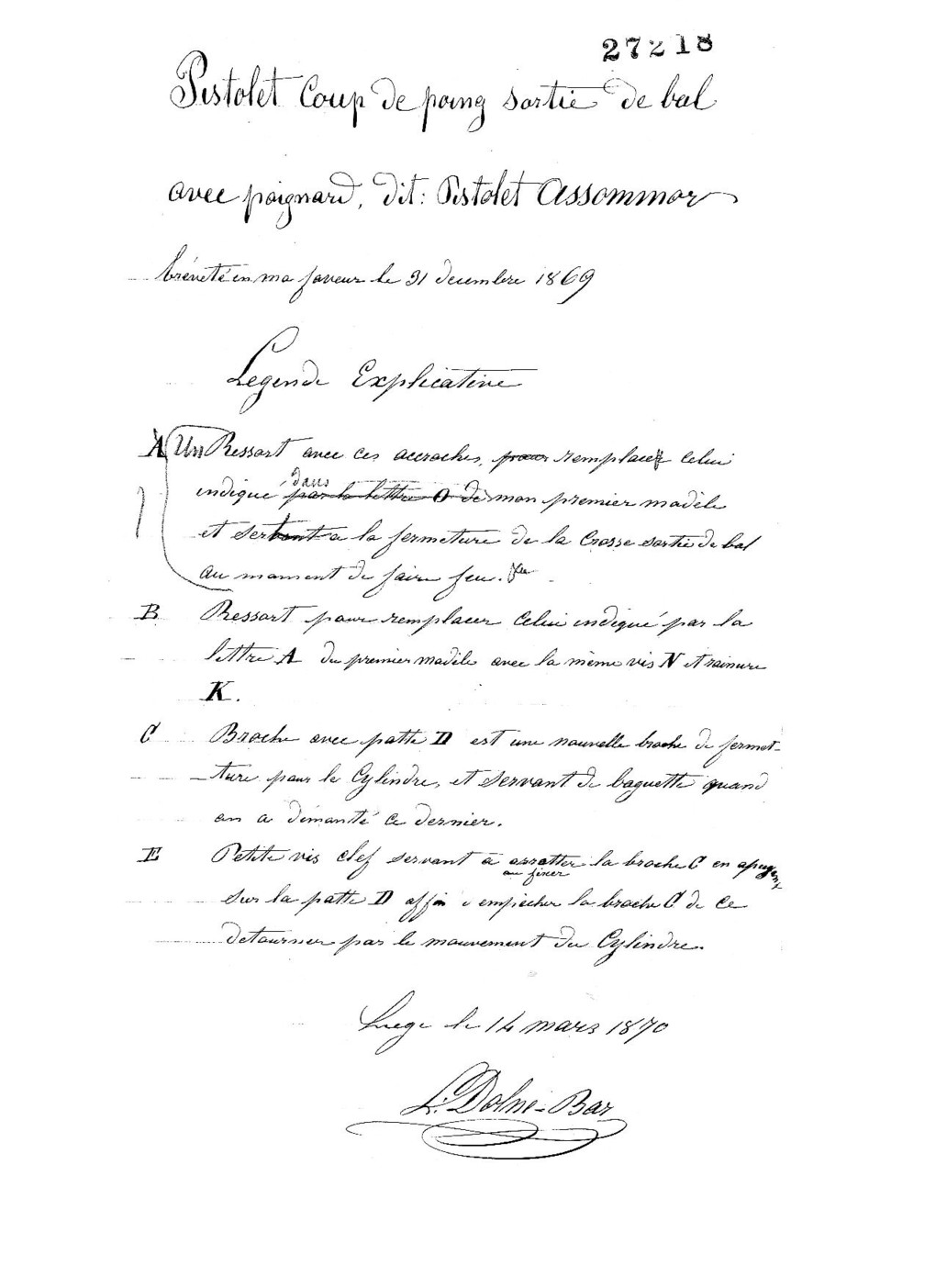
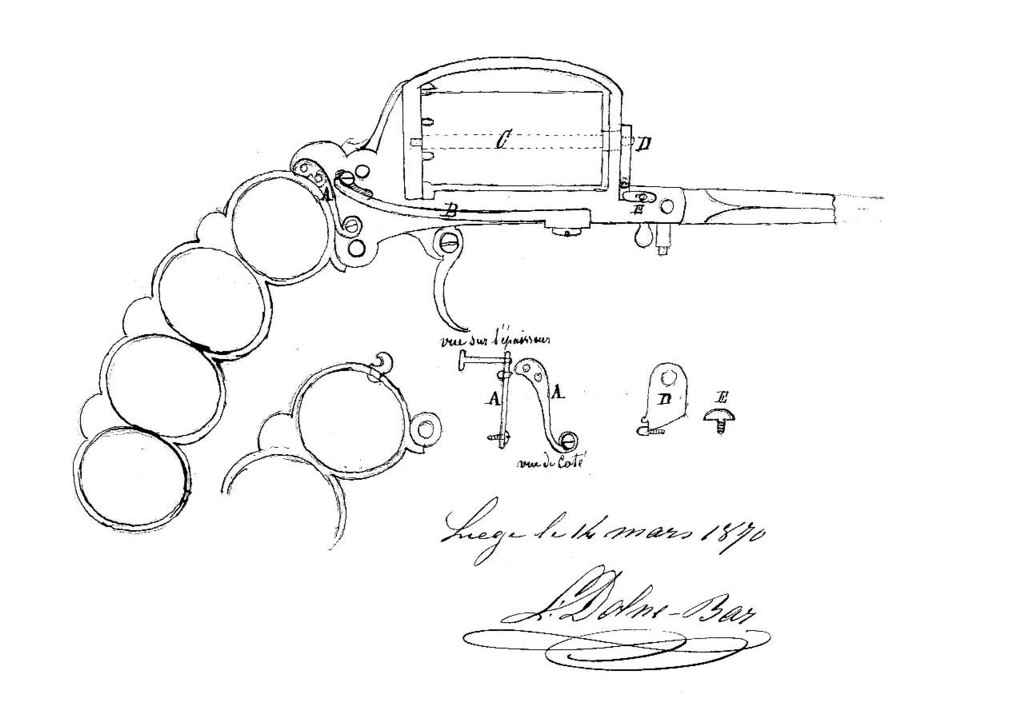
See also
Dolne-Bar/Delhaxe/Collette on
Littlegun :
I notice the initials
VC (Victor Collette) which could be the manufacturer.
I can't decipher the
monogram.
HPH
Identification 3826
I hope that the owner of this “engine” did not untie the strings of his purse too much to win it.
I know that in Liège,
we did everything from the best to the worst, but in the latter category, he
is a champion.
Certainly, there have
been manufacturers of “trafficking” weapons, which have been sold in Africa,
and it is doubtless part of the end of this production: the fact that it has
passed the test on the proofhouse in Liège seems to indicate that it is
“safe” to use, but for the rest, it is almost to be regretted.
As one member of the
team put it very well, “In my opinion, the non-embedded counterplate and its
retaining screws are fanciful.
The wood has been
leveled to erase traces of the original counterplate.
Also, I think the
misfit mouthpiece came from another gun, and I'm wondering about the lock
and the battery spring.
Even the flint is
upside down between the hammer's jaws. »
I would add that the
screw for fixing the barrel does not comply with the usual practice, namely
that the slot is in the axis of the barrel, otherwise without a back sight.
The wand is way too
close to the barrel.
I thought for a moment
of a rifle intended for members of “reconstruction” societies who fire
volleys, but these rifles are (usually at least) capable of attaching a
bayonet via a small tenon, which is not the case here.
I'm really sorry.
GP with the
help of MC.
Identification 3827
Voici un pistolet à broche à deux canons juxtaposés et baïonnette repliable de fabrication espagnole. Il porte en effet des poinçons d’épreuve à poudre noire du Banc d’Epreuves d’Eibar : les trois cercles ont été utilisés depuis 1923, les deux fusils dans un écu surmontés d’un pistolet depuis 1931.
Ce type de pistolet a connu un grand et long succès en Amérique du Sud, notamment en Argentine et au Brésil.
GP avec l’aide de Chris et HPH
Bonjour,
Ces pistolets - avec ou sans baïonnette - semblent être une spécialité
d'Eibar et sont tous à peu près identiques, avec surtout la même gravure en
damier, quel que soit le fabricant.
Les exemplaires rencontrés, allant du 5 mm au calibre .20, toujours à
broche.
Caractéristiques générales:
- 2 canons taillés dans un seul bloc (sauf le cal. 20)
- Gravure en damiers sur les 2 faces du coffre
- Qualité plutôt niveau quincaillerie
- Rarement marqués (je n'en avais qu'un seul marqué, de Arizmendi Hermanos)
- 2 détentes escamotables et facilement esquintables, peu pratiques
- La plupart des pièces ne sont pas trempées
- Bouton latéral d'ouverture + ressort
- Crosse en bois de Campèche véritable, un peu taillées façon "renaissance"
- Sauf erreur de ma part, AUCUN poinçon d'épreuve
- Fabriqués apparemment par divers armuriers d'Eibar
- Finitions possibles:
- Entièrement poli blanc
- Entièrement chromé
- Carcasse poli blanc/chromé et canons bleuis
- Entièrement jaspé (probablement un faux jaspage)
- Baïonette à ressort facultative
Le plus souvent dans un état lamentable, mais certains ont été bien
conservés. Historiquement mystérieux, je n'ai jamais trouvé une quelconque
explication au sujet de ces vistemboires pourtant probablement populaires
puisqu'on en trouve partout assez régulièrement. J'ai vu certaines carcasses
en 5 mm en acier (?) fondu, donc assez récentes. Je suppose qu'on en trouve
également beaucoup en Amérique du Sud, où ce type d'arme est very popular.
Voilà.
Identification 3829
Here’s what was certainly a nice revolver when it was full, I mean with its
grips of course.
The cylinder tilts to the right after lowering the door to the rear.
Caliber unknown to the owner... he could have measured the diameters of the
cylinder housing and the barrel housing...
The ELG stamp on a star in a crowned oval indicates that it is dated after
July 11, 1893.
According to a member of the team, it is a
creation of Noël Ledent,
whose name can be seen on the handle, already mentioned on the website here
:
Would it have been manufactured by
N. Ledent
with omission of the patented
DD Oury ???
That is plausible.
GP with the help of HPH, Chris and MC.
Identification 3830
Voir :
http://www.littlegun.be/articles/essais%20belges%201880.htm
https://www.rockislandauction.com/detail/65/637M
https://patents.google.com/patent/US547447
https://guns.fandom.com/wiki/Li%C3%A9geoise_Model_1888
https://www.forgottenweapons.com/ria-liegeoise-1888-trials-rifle/
ENGH Casper
Bressoux
(1889-1897)
Dépôt de brevets en Belgique
- n° 088806 – 10/12/1889
Nouveau fusil à répétition avec chargeur rapide
- n° 094205 – 18/03/1891
Invention pour un fusil à répétition avec verrou à filet interrompu et
fermeture à la partie antérieure et chargeur rapide
- n° 100226 – 25/06/1892
Magasin avec chargeur étui en acier applicable aux fusils à répétition avec
fermeture dite à verrou
- n° 103359 – 04/02/1893
Système de pistolet à répétition
- n° 106276 – 25/08/1893
Pistolet à répétition (brvt ppal n° 103359 du 04/02/1893)
- n° 107894 – 14/12/1893
Pistolet à répétition (brvt ppal n° 103359 du 04/02/1893)
- n° 107904 – 22/12/1893
Pistolet à répétition (brvt ppal n° 103359 du 04/02/1893) (avec
PAQUOT Joseph)
- n° 108199 – 10/01/1894
Pistolet à tir rapide, à répétition et à tir de précision (brvt ppal
n° 103359 du 04/02/1893) (avec PAQUOT Joseph)
- n° 127121 – 09/03/1897
Nouveau système de fusil à répétition
Identification 3832
Here is an
interesting juxtaposed hammerless rifle “Mephisto”, a pistol-grip and
cheekbutt that, after a lot of research, has been attributed, thanks to the
team, to Jean-Baptiste Rongé (initials JBR in six-pointed star under crown),
already mentioned on the website, especially about the last rifle mentioned
on this page:
https://littlegun.be/arme%20belge/artisans%20identifies%20q%20r/a%20ronge%20jean%20baptiste%20hammerless%20gb.htm
where it also reads “General Fire Arms Company”
What’s more, the team
also found the following very interesting link that evokes another Mephisto
rifle by Jean-Baptiste Rongé also bearing the “General Fire Armes Company”
label:
https://www.shotgunworld.com/threads/shotgun-id-and-stamp-meaning.507056/
So far, at least, no
other trace of this General Fire Arms Company has been found in London.”
The
barrels
were made by Fried. Krupp AG in Essen, Germany.
The punches
ELG on a star in a
crowned oval: accepted by the proofhouse of Liège, in use from 1893 to 1968;
Lion on PV:
smoke-free powder proof, in use from 1898 to 1968;
J under star:
countermark of a controller, in use since 1877;
Peron (little step) :
inspection, in use since 1853;
EL: provisional
proof, in use since 1852;
24 over C in vertical
diamond: calibre, in use from 1898 to 1924;
P 1KG052.5: barrel
weight, in use from 1892 to 30 June 1924.
This rifle therefore
dates from the period between 1898 and 1922, when the annals were
introduced.
GP with the
help of HPH and PHL.
Identification 3841
This is a classic pinfire revolver of indeterminate
caliber, whatever. Superior quality given the engravings.
We see, it seems to me, the
initials PF under the barrel; we also see on the barrel a PF crowned in a
circle: we know a PF crowned in an oval, which is a trademark registered by
Pirlot & Frésart,
rue St-Gilles 95 in Liège on 13/06/1888.
But there is no trace of a
crowned PF in a circle
that would be a trademark of
Pirlot Frères,
registered in the proofhouse of Liège from 1836 to 1879.
It was certainly renewed at
the time of the partnership between
Gustave
Pirlot and
Edouard
Frésart in 1888. In any case, it seems
to me unlikely that this revolver was after 1888 (in principle even 1877,
see below).
The brand
E.
Lefaucheux Inv. Bvté means that
royalties have been paid for the use of the
Lefaucheux
system.
A
crowned EL
theoretically means that
Eugène Lefaucheux's
factory in Liège contributed to the manufacture of this weapon. (even the
cylinder only?)
As for the crowned IS: mystery and gumball.
There is also a crowned G, the countermark of a
controller of the Liège proofouse, applied between 1853 and 1877. And the
classic ELG star in oval, for acceptance between 1846 and 1893.
GP with
HPH
Identification 3850
Voici un superbe fusil de chasse à deux canons juxtaposés. Le système de
percussion est de type « hammerless », avec clé de brisure « top lever ».
Les parties métalliques sont artistiquement gravées de scènes de chasse
(chiens, gibiers). Il est très étonnant que le graveur n’ait pas signé son
œuvre. La crosse et la longesse proviennent d’une essence luxueuse,
peut-être de la ronce de noyer. L’armement s’effectue par un levier latéral
situé à gauche du mécanisme de percussion. Il s’agit à l’évidence d’un objet
de la plus haute qualité.
Les marquages indiquent qu’il s’agit d’un magnifique exemplaire du célèbre
fusil « Le Rationnel » conçu par Henri Pieper à la fin du XIXe siècle. Il a
déjà été mentionné sur le site :
https://littlegun.be/arme%20belge/artisans%20identifies%20p/a%20pieper%20h%20rationnel%20fr.htm
Cette arme est bien entendu évoquée dans le livre consacré à la dynastie
Pieper par Michel Druart (Bayard, les hommes, les armes et les machines du
Chevalier, Pieper & Cie, 1859-1957). Cette dynastie va d’ailleurs faire
l’objet d’un nouveau livre de la plume d’Anthony Vanderlinden, déjà bien
connu pour ses publications sur les pistolets de la FN.
Selon un membre du groupe, il existe un (ou deux ?) exemplaire(s) d’un fusil
Rationnel « découpé » au musée de la commune de Herstal, mais sans certitude
qu’il(s) est (sont) encore exposé(s).
Marquages, Poinçons :
Outre certains marquages non identifiés, on distingue :
ELG sur étoile dans un ovale sous couronne : poinçon du banc d’épreuves en
vigueur à partir de 1893.
Perron liégeois : inspection, en usage de 1853 à nos jours.
N et R ous étoile : contremarques de contrôleurs, en usage à partir du 27
janvier 1877.
PV sous lion dressé : épreuve à la poudre sans fumée en usage depuis 1898
(en fait depuis 1903).
EL en cursives anglaises : poinçon de Liège pour les épreuves provisoires à
la poudre noire, en usage de 1852 à nos jours.
Plusieurs nombres : 4138, 94, 570. Numérotation de l’arme ? Des éléments de
l’arme ?
Nombre dans un losange vertical, ici calibre 16.
Choke 16.
Logo de la firme (Etablissement Pieper) et indication du modèle (Le
Rationnel).
Sur la bande du canon, marquage et logo « canon acier électrique Gin ». Les
canons auraient donc été produits avec de l’acier préparé selon le procédé
de Mr Gustave Gin (1860-1916), ingénieur français des arts et métiers,
spécialisé dans la production électrique d'acier. Voir :
http://patronsdefrance.fr/?q=sippaf-actor-record/23904
Anecdote :
On sait qu’Henri Pieper a offert un tel fusil au président de la République
française Félix Faure, ainsi que signalé dans un article du 6 juillet 1895,
colonne de droite :
htttps://doc.rero.ch/record/82208/files/1895-07-09.pdf
Et qu’il y en avait donc aussi un à cette exposition de Bordeaux.
Mais il ne peut s’agir d’un de ces deux fusils puisque l’exemplaire
en question est postérieur au 4 octobre 1898, date de l’entrée en vigueur du
poinçon du calibre (nombre dans un losange vertical, calibre 16 ici).
Remarques :
Un membre du groupe, expert dans le domaine des armes de Pieper, a relevé
plusieurs anomalies, voir ci-dessous ses remarques in extenso :
“
A ma connaissance les Anciens
Etablissements Pieper n’ont jamais été installés à Liège ; fondés en
1905 à la suite de la liquidation des Etablissements Pieper, ceux-ci ont
occupé une nouvelle usine située rue Petite Foxhalle à HERSTAL.
J’ai personnellement visité les lieux d’implantation : H.Pieper à Liège puis
Etablissements Pieper, rue des Bayards à Liège, ensuite l’usine de
Nessonvaux où était installée la canonnerie, et enfin l’emplacement de
l’usine (aujourd’hui démolie) des Anciens Etablissements Pieper rue Petite
Foxhalle à Herstal.
C’est la première fois que je rencontre le marquage qui figure sur votre
Rationnel. Habituellement on trouve un marquage circulaire « H.Pieper
Breveté » ou le chevalier Bayard chevauchant son cheval.
La marque « ACIER ELECTRIQUE GIN » ne figure pas parmi les marques déposées
par H.Pieper, les Etablissements Pieper ou les Anciens Etablissements
Pieper.
Le Rationnel figure bien dans le catalogue des Etablissements Pieper en 1903
mais on ne le trouve dans aucun
des catalogues des Anciens Etablissements Pieper.
En conséquence je ne peux pas me prononcer avec certitude sur l’origine de
votre Rationnel. Est-ce une arme récupérée par les Anciens Etablissements
Pieper après la liquidation des Etablissements Pieper et terminée
(commercialisée) par la nouvelle entreprise ?”
En conclusion, il s’agit d’un fusil de chasse « Le Rationnel » de la firme
Pieper, produit postérieurement à 1903, date d’entrée en vigueur effective
du poinçon PV sous lion dressé. Cependant les anomalies relevées indiquent
qu’il ne provient pas de la production standard de ce modèle. Pourrait-il
s’agir d’un exemplaire expérimental destiné à tester les canons en acier
électrique Gin ?
Chris, GP, MD
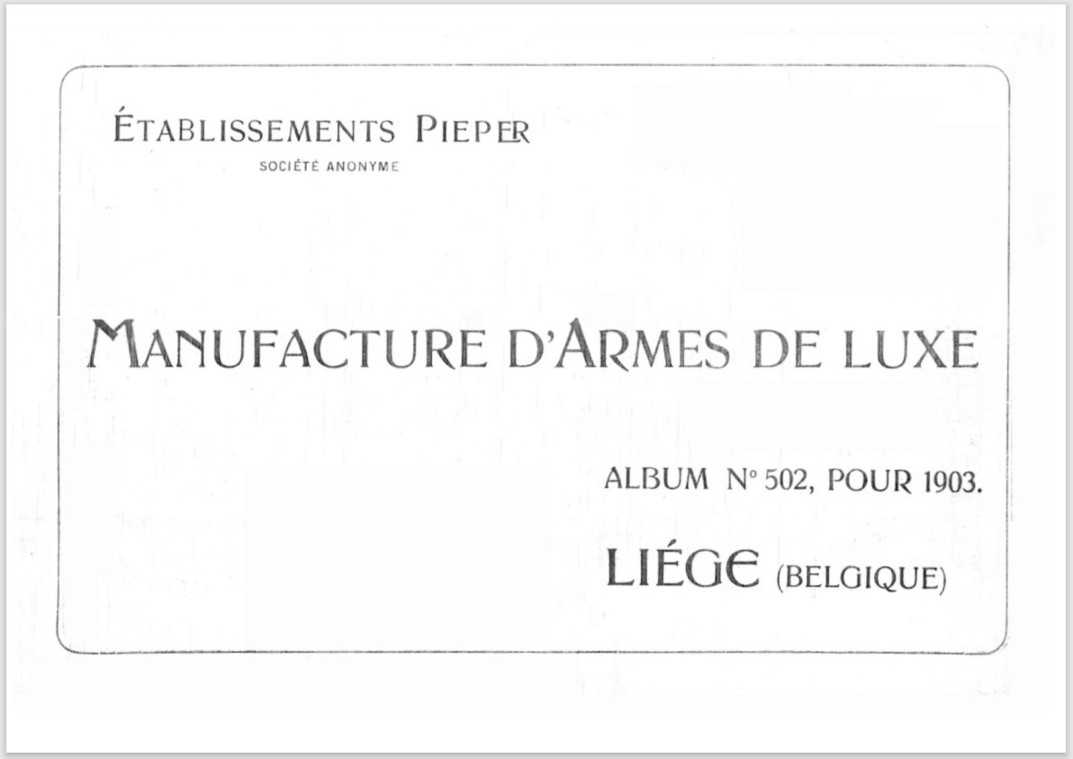
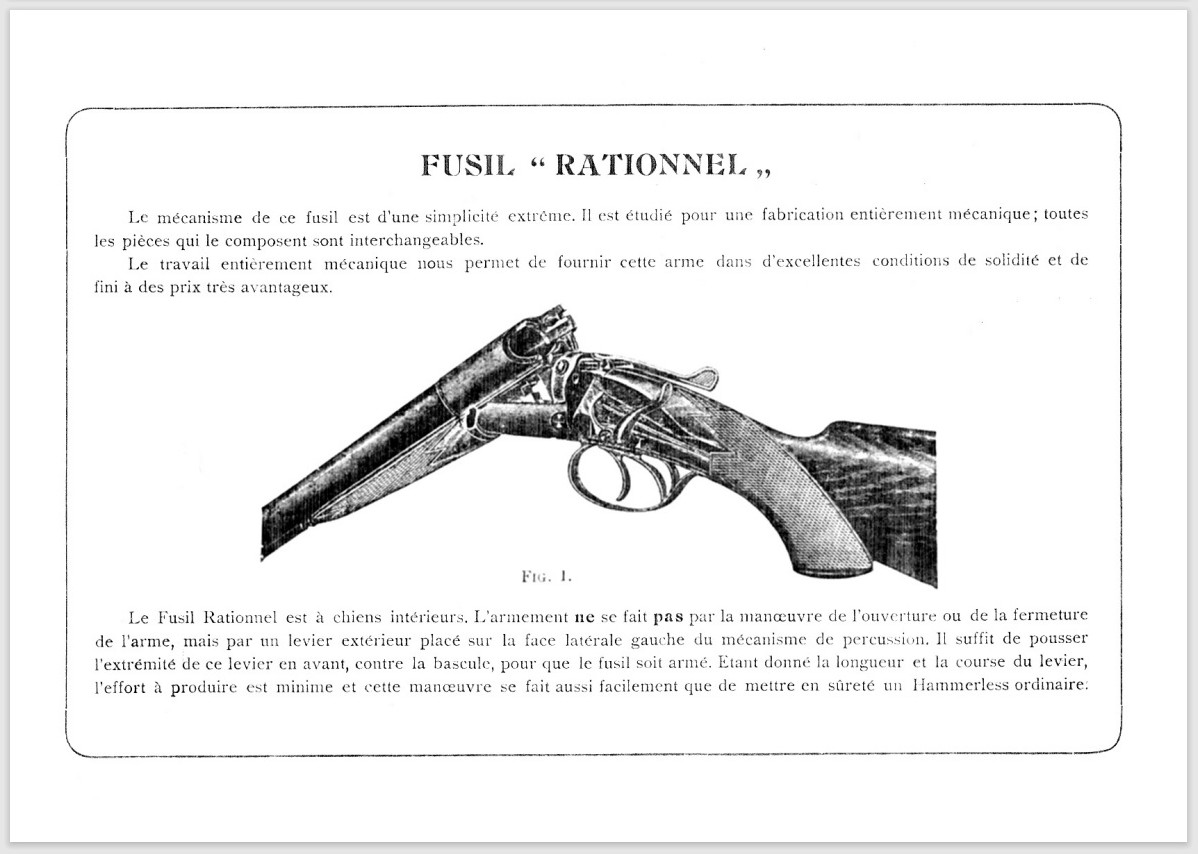
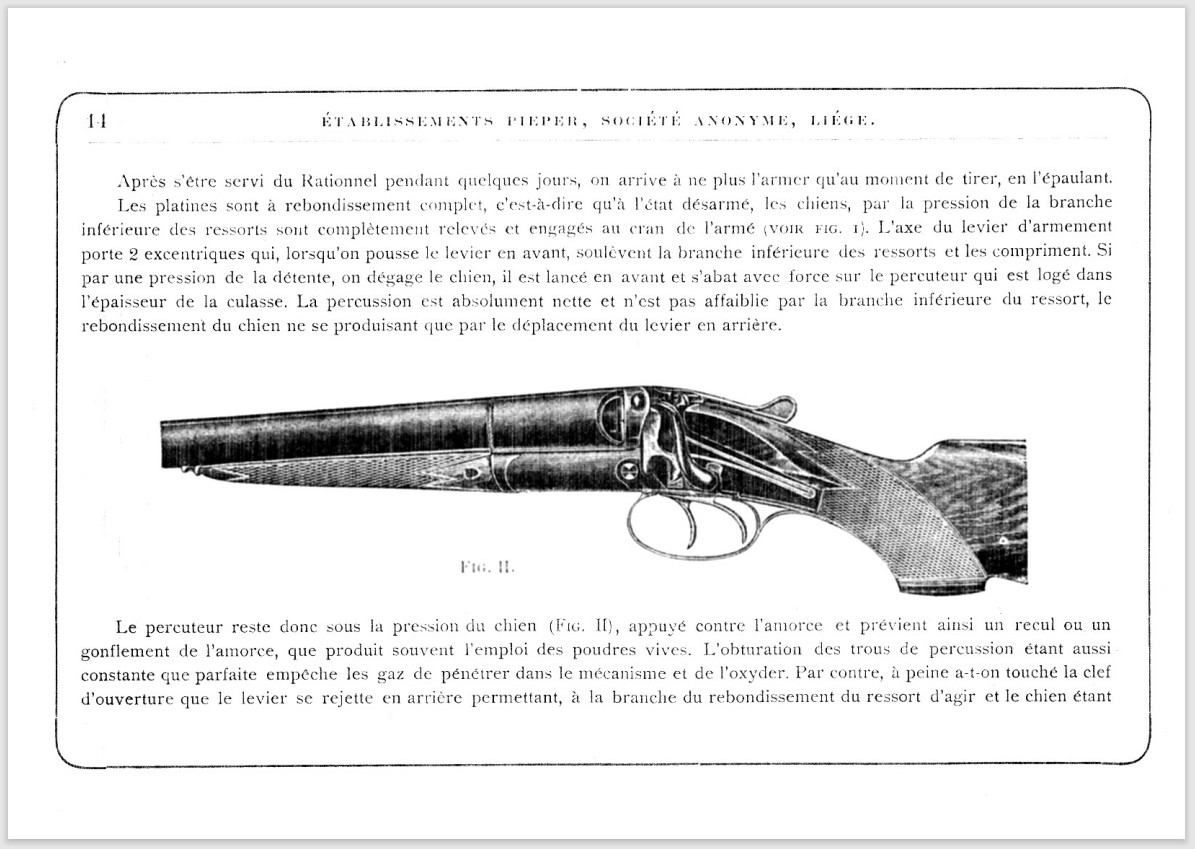
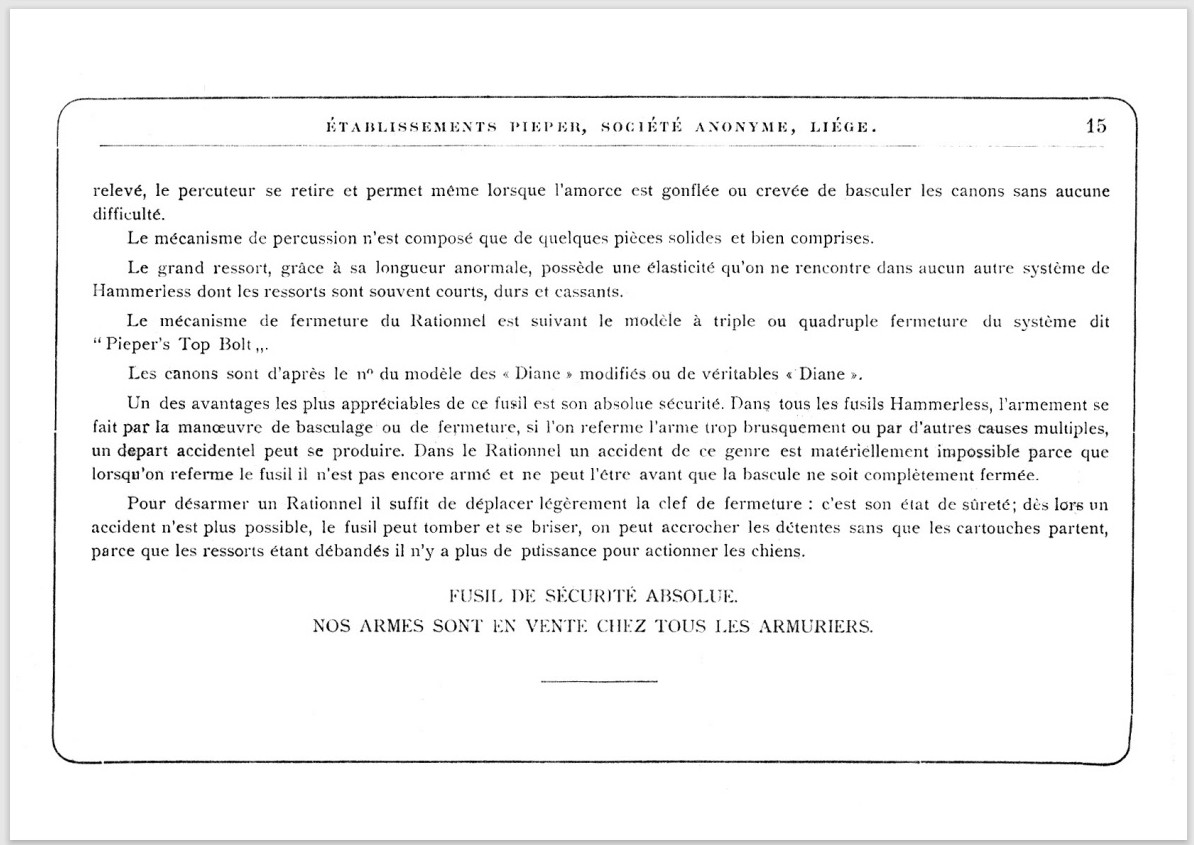
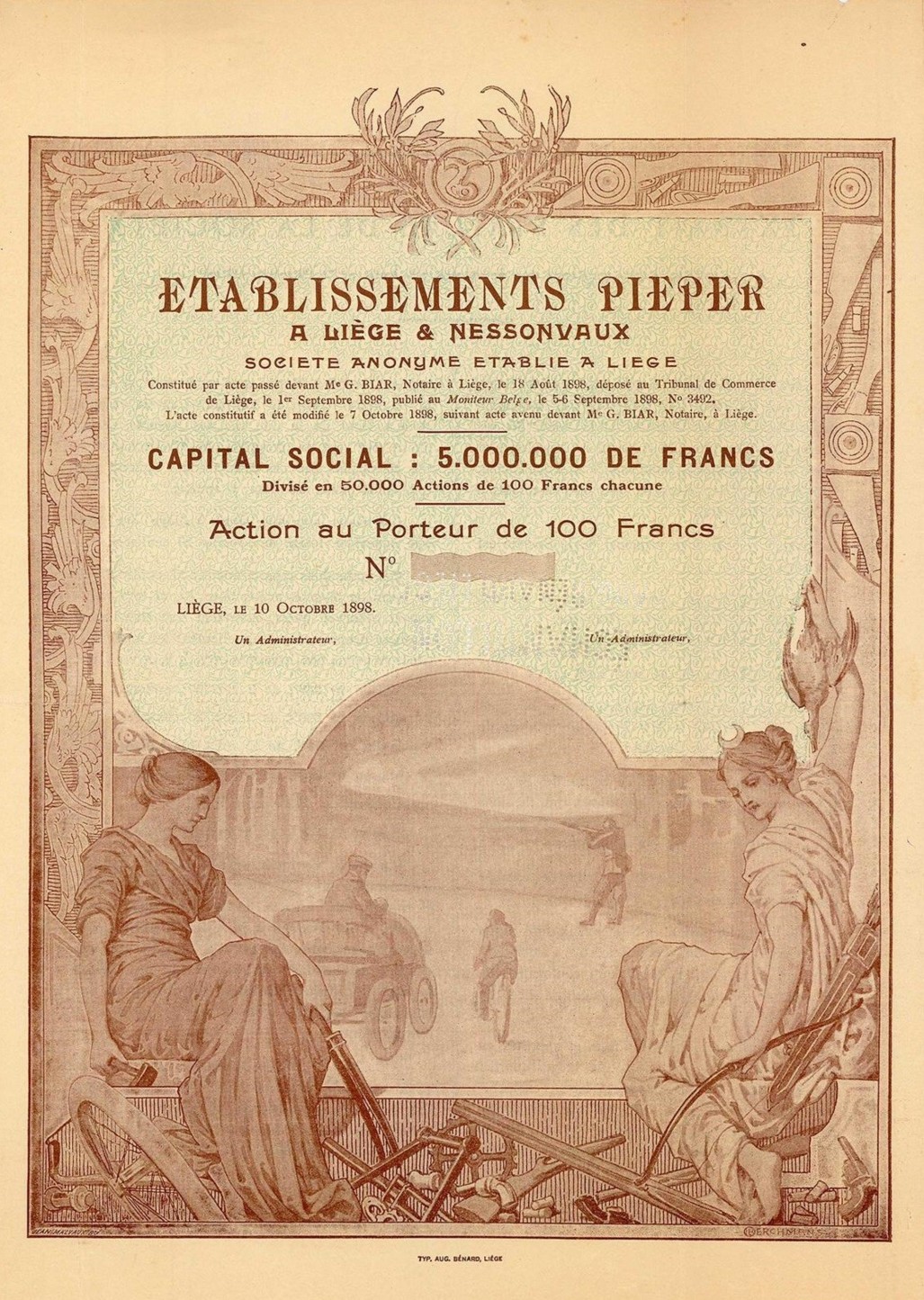
Identification 3852
Here is a “big”
revolver of calibre .45/450/11mm with question mark. The opening is done by
pressing the two pedals.
Under the plates,
there is the mention J. Warnant Patented and on the other side JH followed
by SG.
Jean Warnant is
extensively mentioned on the website:
http://littlegun.be/arme%20belge/artisans%20identifies%20t%20w/a%20warnant%20jean%20gb.htm
He has filed a
multitude of patents, but I have not found one that could match the weapon
in question. There are actually two patents that come into play:
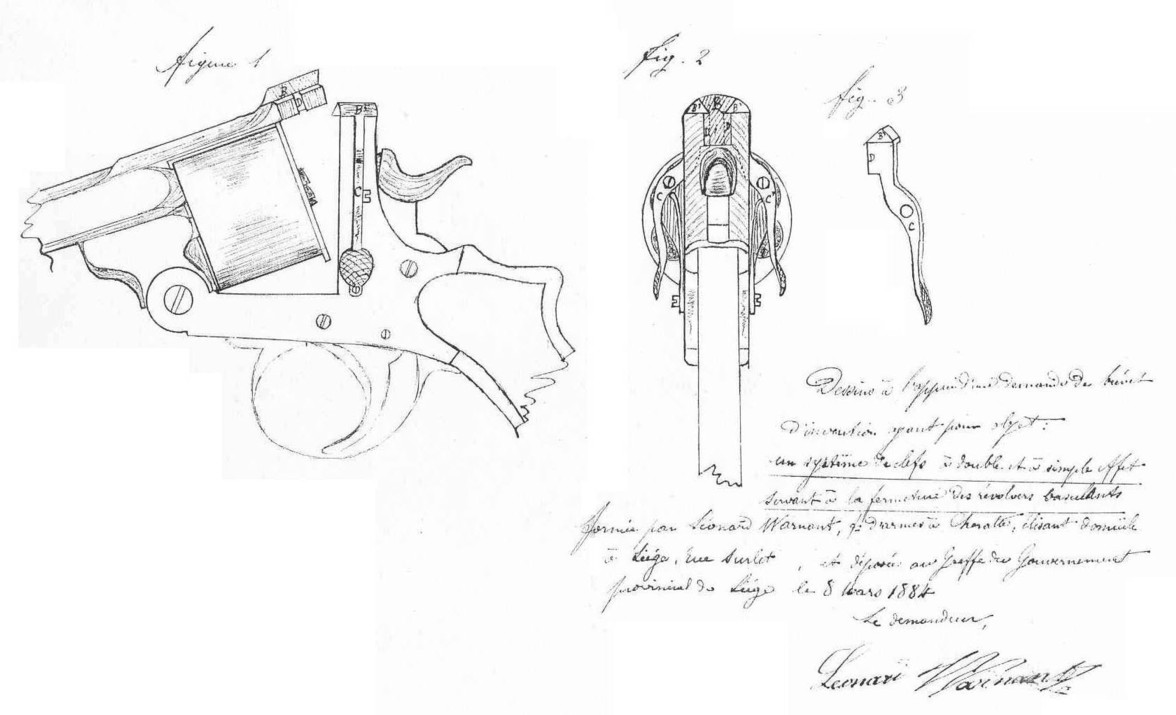
And 64421, but it's
signed Leonard Warnant. Understand who can, I'll give my tongue to the cat.

Moreover, and most
importantly, it is well known that there are two meanings for the term
“patented”, namely that the gunsmith in question was patented
(recognized/graduated as a gunsmith) or that the weapon was derived from a
very specific patent.
In this case, I
prefer the first meaning (until the day when I will be shown in black and
white exactly which patent it derives from).
As for JH, a member
of the team found that it could match Jules Heur. Thanks to him.
http://littlegun.be/arme%20belge/artisans%20identifies%20d/a%20d%20heur%20jules%20fr.htm
The date of
manufacture is located in any case between 1877 (x under star) and 22 July
1893 (ELG on star in oval).
GP with help from
Chris, Max and HPH.
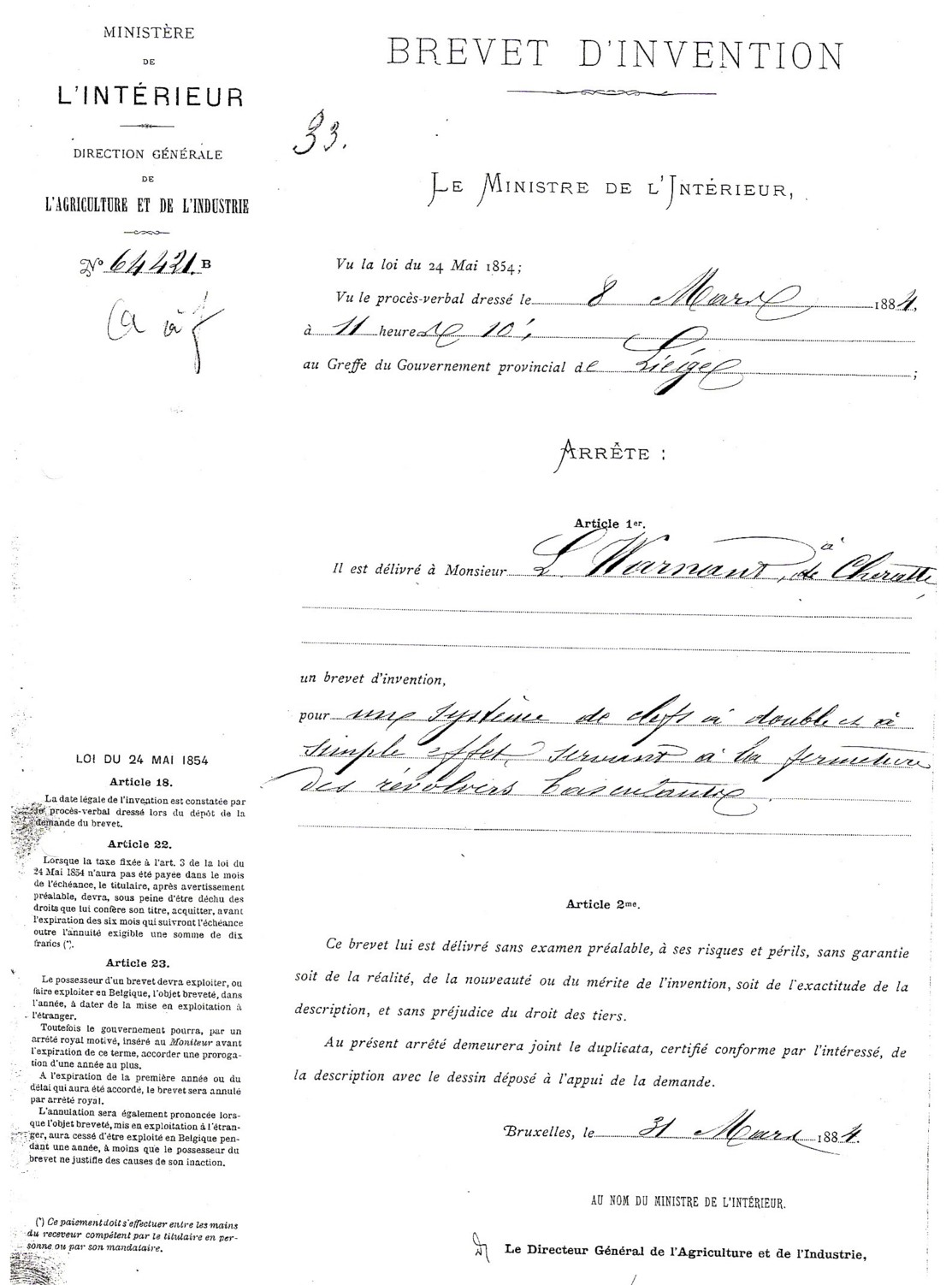
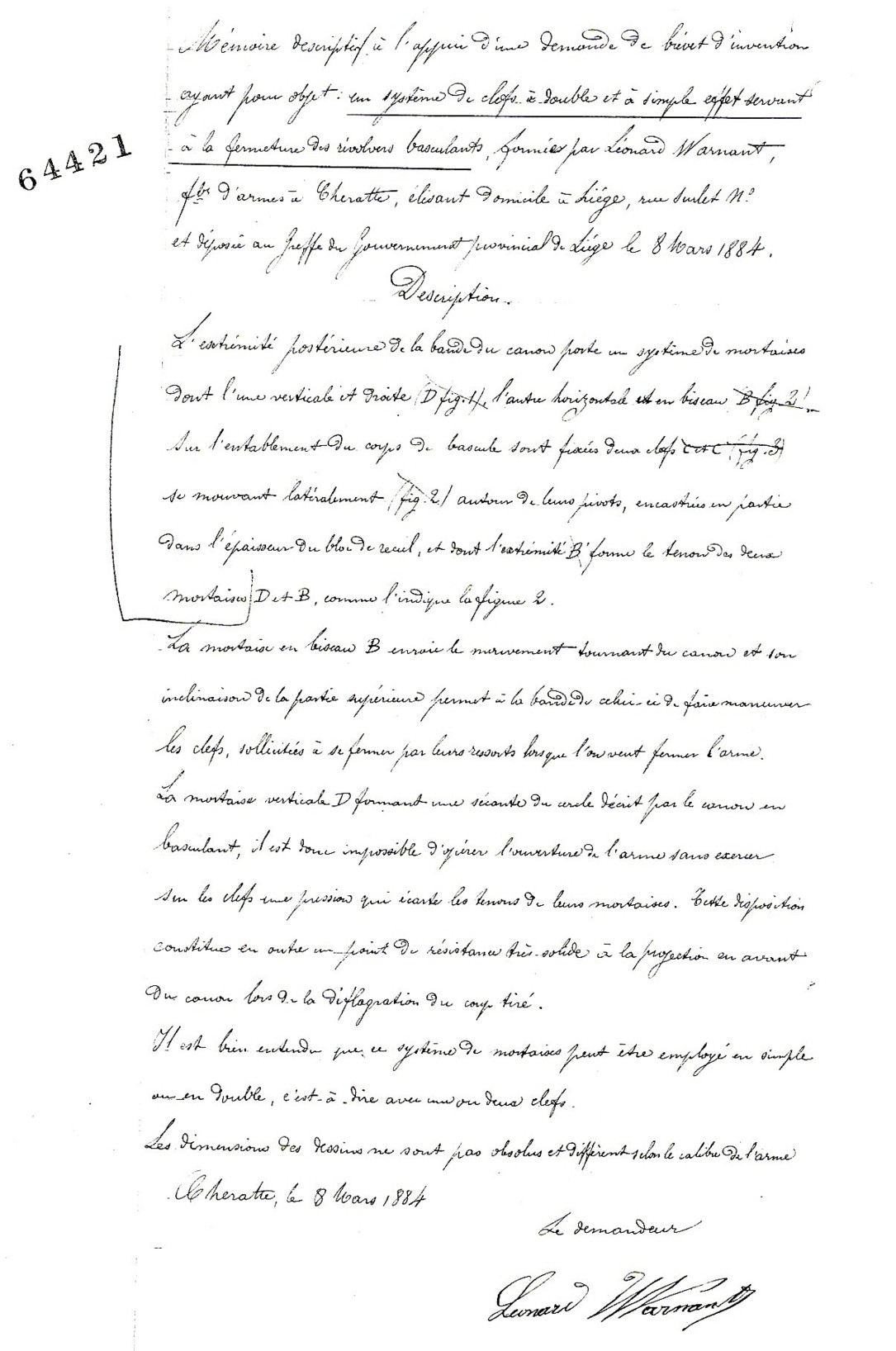
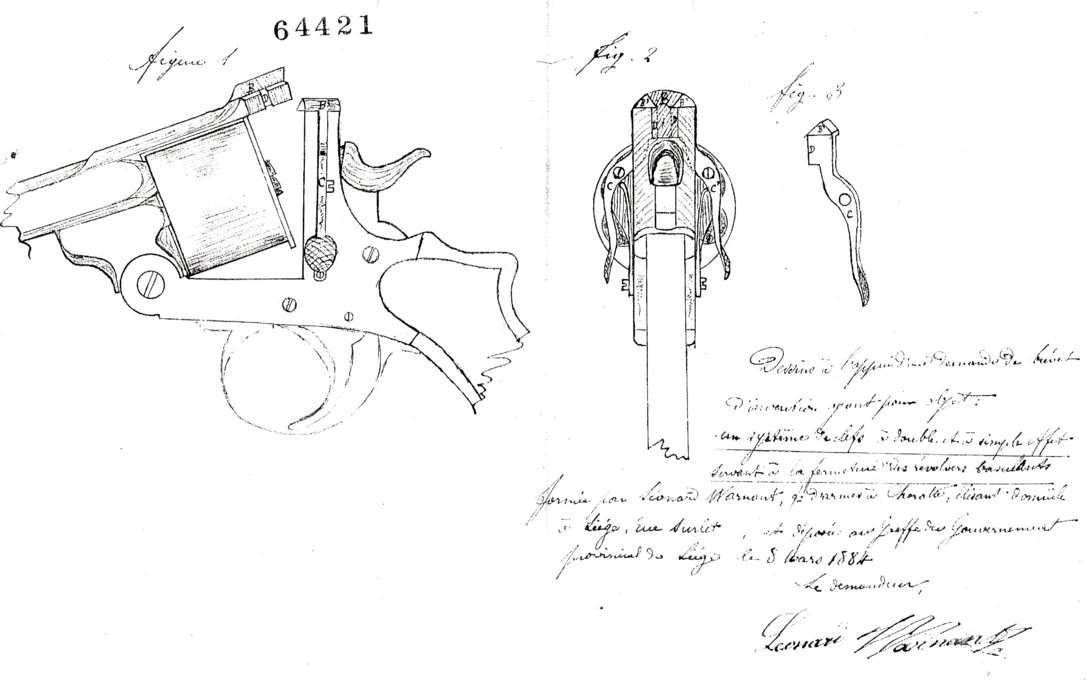

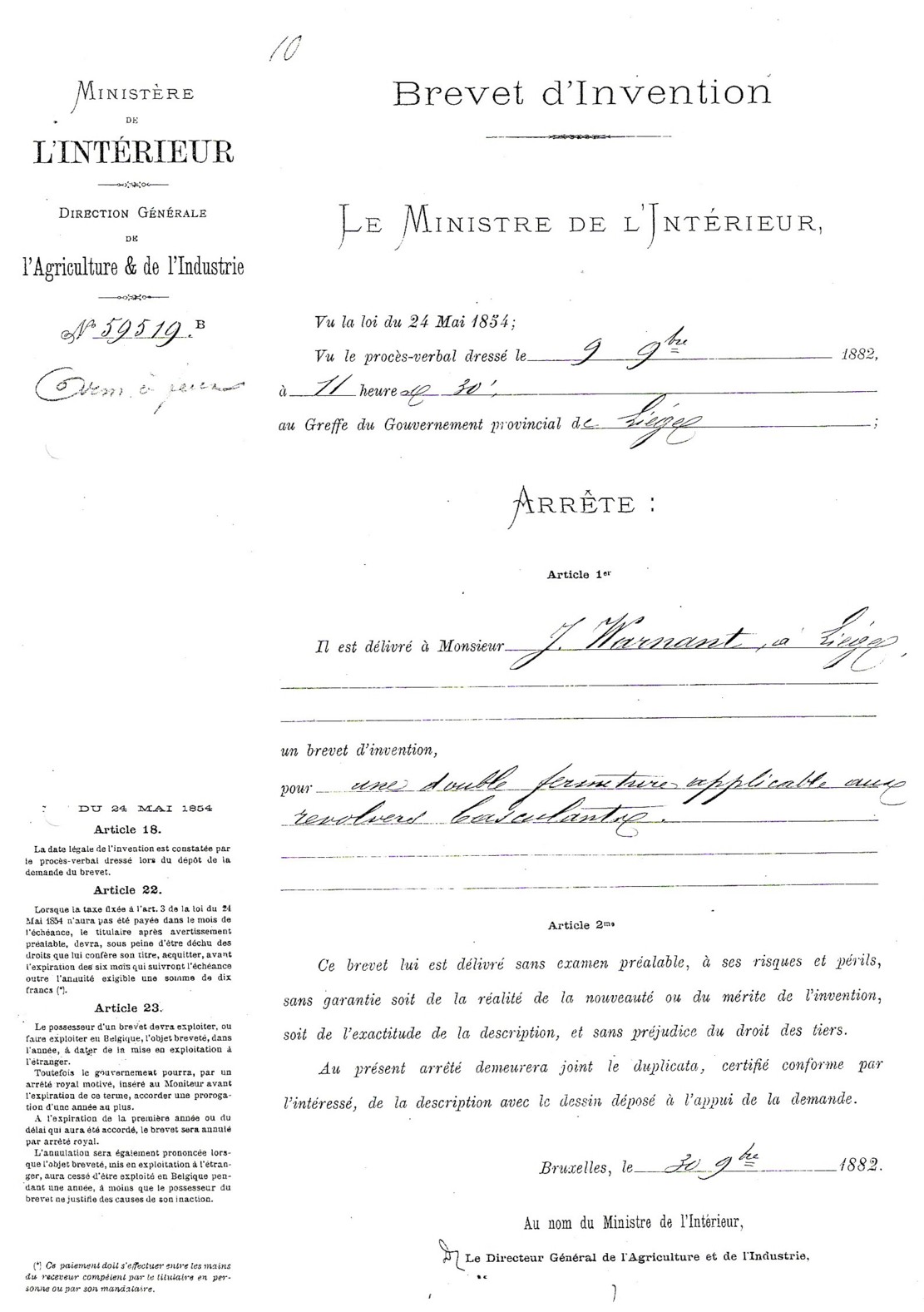
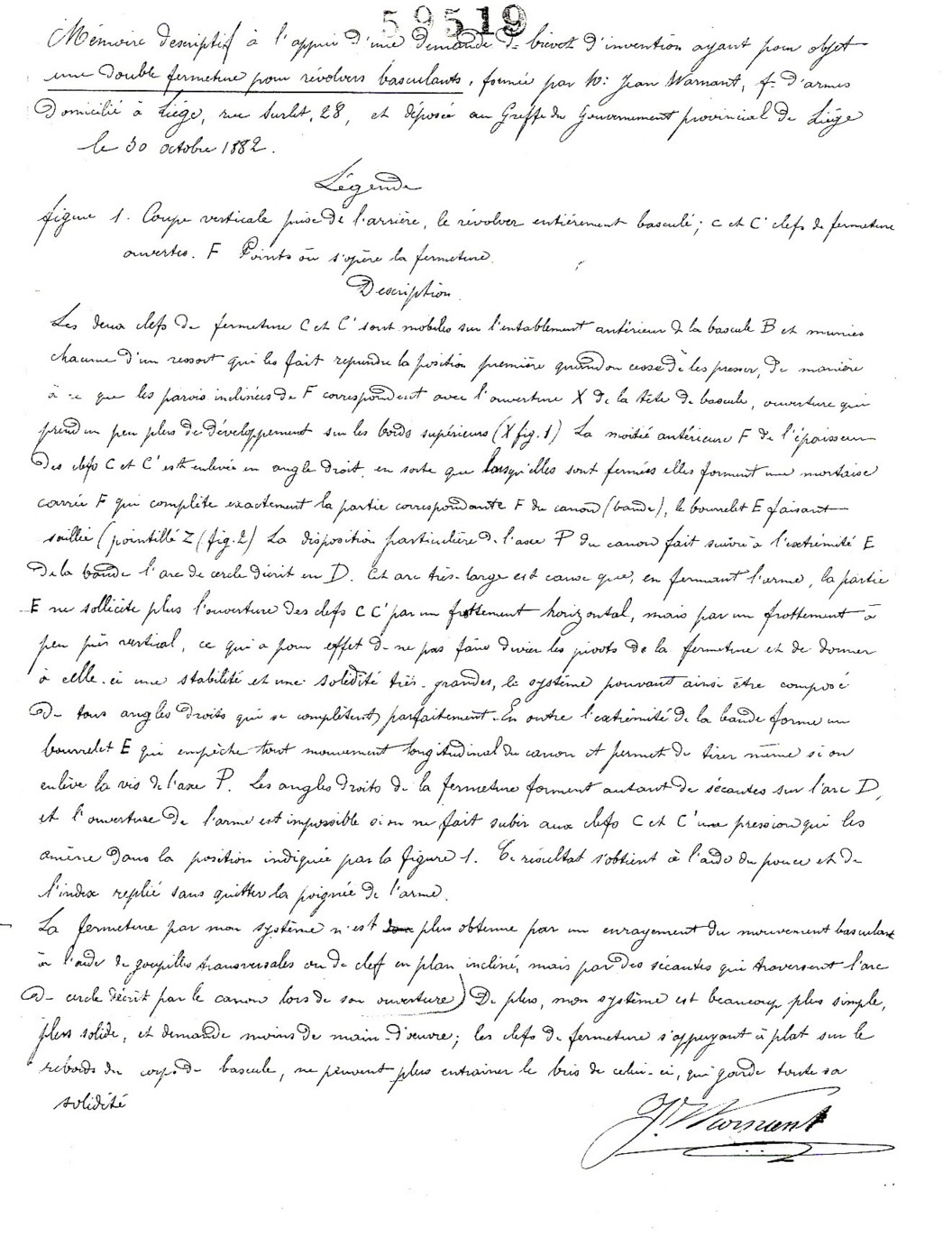
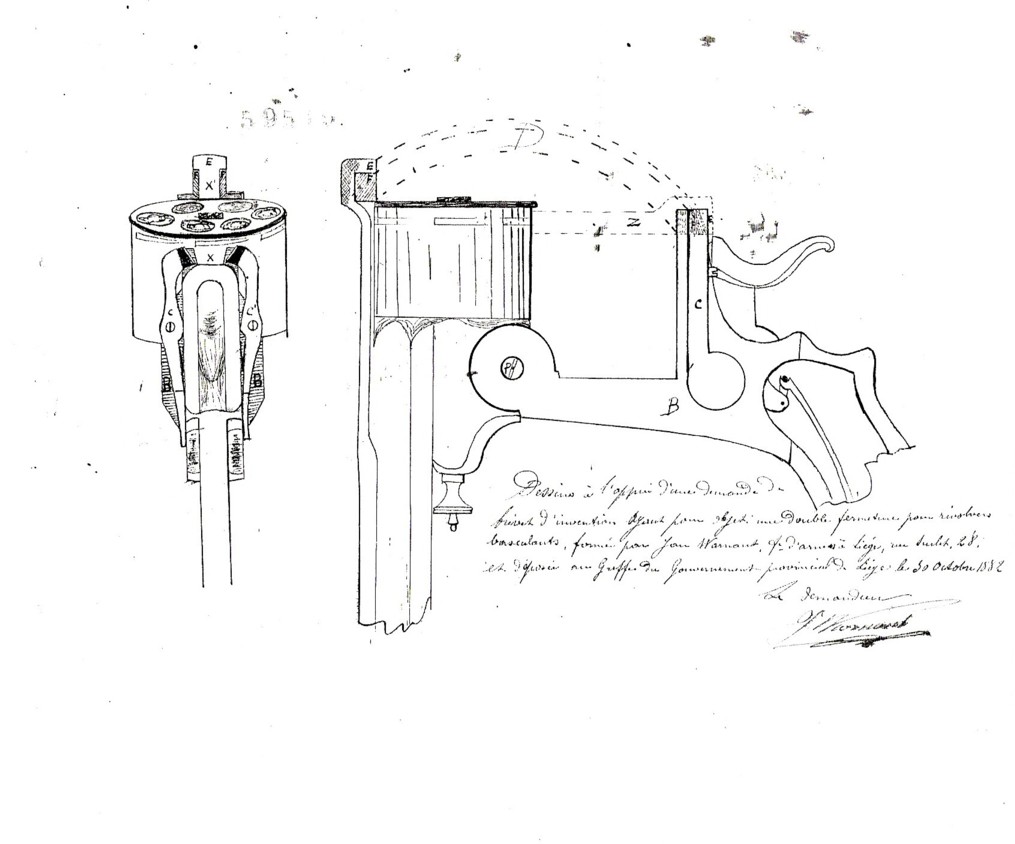
Identification 3853
Here is a very classic Liége shotgun juxtaposed Anson & Deeley type with
semi-pistol butt and light engravings produced by the well-known
"Manufacture Liégeoise d’Armes à feu" (listed in the proofhouse from 1866 to
1929) already widely mentioned on the website and in the "Exceptional
collection".
The punches:
28569 : serial number of course;
ML crowned with a star in a circle: one of the marks of "Manufacture
Liégeoise d’Armes à feu" ;
e: annual letter for 1926;
ACM in a circle: it is suggested that it is one of the trademarks of the "Manufacture Liégeoise d’Armes à feu" :
see in the attached article https://littlegun.be/arme%20belge/artisans%20identifies%20i%20j%20k/a%20kaufmann%20jules%20et%20cie%20gb.htm
1kg 325: barrel weight, in use since 1924;
Lion on PV: tested for live powder, in use since 1924;
x
under asterisk: countermark of a controller, in use from 1877 to 1968;
ELG on star in crowned oval: accepted by the Liège proofhouse in use from
1893 to 1968;
Perron: inspection by the proofhouse of Liège, in use since 1853;
Choke 16.0: Choke barrel.
GP with AD and PHL
Identification 3855
Here is a nice Bull
Dog revolver from Liège, compact and that looks well finished, classic
Belgian interpretation of the Webley N°2.
Caliber is
undetermined, probably 450 or more probably 380 European. It has a cap ring
and a bridge release, attributes attesting to a superior range to most of
its congeners.
The markings are
classic:
ELG on star in crowned
oval : accepted by the Liège proofhouse, used between 1893 and 1968 ;
R crowned: rifled
barrel, used between 1894 and 1968;
A under star: control
after 1877;
195 or 196 (?) maybe a
serial number.
We also see on the
left side the initials FD, which are actually followed by a C as it appears
from an enlargement of the photo, so that we arrive at the company François
Dumoulin & C° already mentioned on the site:
GP with help from
Chris, HPH and AD.
Identification 3858
Il s’agit d’un fusil de chasse hammerless à percussion centrale de type Anson & Deeley. Les platines sont de type "en avant" et portent une légère gravure. La clé d’ouverture est de type "top lever". Les chiens sont extérieurs. Les canons lisses de calibre 16 sont juxtaposés. La crosse en bois de noyer est façonnée "pistolet".
L’arme porte les poinçons réglementaires du banc d’épreuves de Liège, à savoir :
ELG* dans un ovale couronné : acceptation définitive post 1893.
Perron : inspection, en usage de 1853 à nos jours.
Z étoilé: contremarque du contrôleur, en usage de 1877 à 1968.
EL en lettres anglaises : épreuve provisoire, en usage de 1852 à nos jours.
PV surmonté d’un lion stylisé : épreuve à la poudre sans fumée, en usage de 1898 à 1968.
16.70 dans un oméga : calibre nominal et longueur de la douille. En usage de 1924 à nos jours.
Choke 16.9 et 14.7 : canons chokés, calibrés en mm à 22 cm de la culasse et à la bouche.
Lettre "n" ou "u" minuscule : (Je ne peux pas distinguer si c'est un "n" ou un "u"!) : le "n" est la lettre annale de 1935, le "u" est celle de 1942.
ACM dans un cercle : Probablement, mais sans certitude, une des marques de la Manufacture Liégeoise d'Armes à Feu. Elle ne figure pas dans les marques déposées officielles.
L’arme porte également les marques suivantes :
ML : Manufacture liégeoise d’armes à feu, entreprise sise à Liège rue du Vertbois, 54.
ML couronné dans un ovale vertical : idem ci-dessus.
133257 : numéro de série de l’arme.
AD
Identification 3866
It is a small, faired
hammer revolver that roughly mimics the general shape of a semi-automatic
pistol. The European market was flooded at the beginning of the 20th century
by these small handguns, often referred to as "humpus" or "hammerless". The
latter term meaning "hammerless" is however abusive, even inappropriate,
since these revolvers obviously have an hammer, even if the hammer remains
invisible under the carcass. The manufacturers hoped that customers would
appreciate the “modernized” appearance of a system that was outdated at the
time because it dates back to the design of the British Bull Dog created in
1873. These revolvers, like this one, were often calibrated in 6.35 or 7.65
with centre percussion (for this example, only a measurement of the diameter
of the chambers would make it possible to distinguish between these two
calibres). The only real improvement of these weapons was the presence of a
stockpile of ammunition inside the handle, as is the case with this one,
which is impossible on a Bull Dog. The weapon also has an under-deck
trigger, while most of its counterparts have a folding trigger. The revolver
is equipped with a safety device, an accessory of little use on a revolver,
but which was especially appreciated by the German users for whom it was
intended, as indicated by the address of the dealer Carl Kürmes, Leipzig.
The first name of this gunmaker is normally written “Karl”, but it is
possible that the Liège engraver has francisized it as “Carl”.
In the absence of an
unambiguous marking, it is not possible to definitively identify the
manufacturer of the revolver. This point provoked an interesting search by
several members of the team from which it emerges that a real possibility
would be a production by Pierre WERTZ
who filed several patents for this type of revolver from 1902 to 1910 (see
the following link on the site):
https://littlegun.be/arme%20belge/artisans%20identifies%20t%20w/a%20wertz%20gb.htm
Nevertheless, as other
Liège artisans have produced similar revolvers, caution should be exercised
on this attribution.
Markings:
SUR, left side of the
carcass, for "safety" (abbreviation in French).
PV under erect lion,
right side of the carcass and back of the barrel (curiously modified in RV)
for proven live powder, since
1898 (but effective since 1903).
M under star, right
side of carcass and back of barrel, inspection stamp from January 27, 1877.
R under crown, for
rifled barrel, verification mark for rifled barrel handguns, from 30 January
1894 to 26 February 1968.
Oval ELG under crown,
stamp of the proofhouse after 1893.
N° 1 at the front of
the cylinder (serial number or indication for the craftsman?).
According to the state
of research, everything indicates that this revolver must have been produced
at the very beginning of the 20th century, during the period 1903-1914.
Chris, Max, HPH
Identification 3869
It is a small rifle,
called garden or living room, in caliber 9mm Flobert and intended for
precision shooting at a reasonable distance. It has an octagonal barrel,
standard sights and a diopter holder. (It's the tin welded piece you wanted
to know what it's used for !!)
The trigger guard is
worked with a sketch of finger rest. One-shot, its extractor is
Warnant system.
Reminder:
Louis-Nicolas Flobert, French gunmaker (1818 - 1894), invented the first
metal cartridge with annular percussion in 1845. This was a major innovation
in the field of firearms ammunition. The 9mm Flobert is still in use today
and rifles of this calibre are still produced today.
There is no specific
indication of the manufacturer of the weapon. However, the letters
WC engraved on the gun may
possibly militate for Walter Clément
(see on the website :
https://www.littlegun.be/arme%20belge/artisans%20identifies%20c/a%20clement%20walter%20gb.htm)
but much more probably for Warnant-Créon Julien, see on the website a rifle showing points in
common with it, patented on March 23, 1885 :
https://www.littlegun.be/arme%20belge/artisans%20identifies%20t%20w/a%20warnant%20creon%20julien%20gb.htm
Note the analogy of
the extraction system between the two weapons.
Markings:
Peron (little step) :
stamp of the inspector of the proofhouse (valid from 16.06.1853 to the
present day) in several places of the rifle.
M under star: control
stamp in effect from January 27, 1877, left side of the hammer.
WC on the barrel, possibly Warnant-Créon branding.
Number 99 (or 66
depending on the reading direction) probably a serial number, on the barrel,
next to another unidentified marking (an animal?)
Marking in front of
the sight, evoking the letter J.
FL. 9 m. C, extractor
in open position, Flobert 9mm calibre indication.
Note: On the available
photos, we could not detect an ELG oval.
In conclusion, this
rifle was probably manufactured by Julien Warnant-Créon in Liège, after 1885.
Chris, GP, AD, HPH
Identification 3870
Il s’agit d’un fusil d’infanterie à silex, en calibre 17,5, ayant souffert de l’usure du temps avec ses bois piqués et fatigués et l’absence de sa baguette, mais qui mérite le plus grand respect tant pour son aspect historique que pour sa rareté.
C’est un fusil réglementaire français modèle « 1777 corrigé An IX ». Mis au point à la fin de l'Ancien Régime, le fusil modèle 1777 a été utilisé pendant la longue période des guerres de la Révolution et du Premier Empire. La correction « An IX » doit son nom au calendrier révolutionnaire, et a été adoptée en 1800 (soit l’an IX de la révolution française). Issu du travail d'une commission réunie à la demande de Napoléon Bonaparte, les modifications par rapport au fusil 1777 portent principalement sur la platine, la crosse et l'embouchoir.
Pour un exemple de ces fusils sur le site : http://www.littlegun.info/arme%20francaise/saint%20etienne/a%20manuf%20roy%20grenadier%201777%20an9%20fr.htm
Cet exemplaire provient de la Manufacture de Kulenburg, mot qui est indiqué dans le cartouche sur la platine. Kulenburg est une ville des Pays-Bas dont le nom est francisé en Culemborg. Bien entendu, les Pays-Bas étaient à cette époque partie intégrante de l’empire napoléonien (le 5 juin 1806, Napoléon nomma son frère Louis Napoléon Bonaparte roi de Hollande). La manufacture de Kulenburg fut donc réquisitionnée pour produire les armes destinées à l’armée française. L'administration impériale a commencé à fonctionner seulement à partir de janvier 1811. La manufacture, menée par l'entrepreneur Devillers (de Liège) a connu des difficultés financières et a été fermée par ordre de Napoléon fin 1812, pour concentrer la production à Liège.
La manufacture de Kulenburg n’ayant
fonctionné qu’en 1811 et 1812, seulement 6743 fusils ont été produits !
L’arme présentée ici est donc d’une réelle rareté...
Marquages :
Kulenburg dans un cartouche surmonté d’un couronne, platine côté droit : marquage de la Manufacture.
Chiffre 6 (ou 9 selon sens de lecture) côté gauche canon.
Poinçon côté gauche canon, incomplet, évoquant un D.
Quelques Sources :
From Aspects of Dutch gunmaking by Henk L. Visser & De Witt Bailey : “In 1812, the factory [Culemborg?] was closed by order of Napoleon.
Production of French
arms for the Northern and Southern Netherlands was concentrated in the Liege
arms factories….”
https://www.passionmilitaria.com/t88208-fusil-d-infanterie-de-la-manufacture-de-culembourg
https://www.tircollection.com/t31804-manufacture-de-culemborg
https://www.nmm.nl/nl/stories/culemborgse-geweerfabriek/
Chris, HPH
Identification 3875
It is a beautiful
revolver belonging to a category often called "transition revolvers". The
term "Transition" applies in the strict sense to the weapons that form the
link between pepperbox and revolvers of modern design, with or without a box
frame. By extension, it is also used for revolvers of the 19th century which
still have the look of the pistols with one shot of which they are
descendants. In many countries, gunsmiths developed this type of percussion
handgun, such as Baker in Great Britain, Maynard in the USA, Devisme in
France. A similar general line can be found in their products, as well as in
the specimen found here, even if each gunmaker developed its own innovations
(internal percussion at Devisme, for example). Of course, the craftsmen of
Liège were also interested in these products.
The revolver presented
here has features that make it a luxury item: octagonal barrel, staggered
hammer, fine plates finely grated probably in walnut, engraved carcass,
shield protecting the primers, numbered chambers, calibre 44 (10,8mm).
The manufacturer of
the item is easily identified thanks to several references on the weapon
(see below the “markings” section): this is Jean Baptiste Hanquet, a
well-identified artisan on the site:
https://littlegun.be/arme%20belge/artisans%20identifies%20h/a%20hanquet%20jean%20baptiste%20gb.htm
In 1853 he filed a
Belgian patent for a pistol system, which may correspond to the revolver
examined here. His company was registered on the proofhouse of Liège between
1796 and 1872, which is also in accordance with the period of manufacture of
this revolver, around 1853-1855, according to the following site (which also
indicates the calibre, dimensions and characteristics):
https://www.pistol3d.com/revolver_hanquet/hanquet.html
Markings:
Oval ELG on star,
cylinder, corresponding to the proof mark of Liège from 8 September 1846 to
11 July 1893
GM under crown, under
the barrel, not identified with certainty: perhaps the initials of the
craftsman who provided the barrel (GM for Guillaume Mariette?).
155 (serial number
probably), under the barrel.
V under crown, left
side cannon and barrel, control stamp in effect from 30 December 1853 to 26
January 1877
Manufacturer's
signatures: Hanquet patented (left side gun), Manufed by J B Hanquet Liège
(top gun), Hanquet (primer shield)
Lepage Frères Paris 12 rue d’Enghien, arms dealer
It was a 44 caliber
percussion revolver, designed, patented and manufactured in Liège by Jean
Baptiste Hanquet between 1853 and 1855, to be resold in Paris by the Société
Lepage Frères.
Note:
An astonishing version
of this revolver is known, presented in a box with two interchangeable guns
of different lengths as well as a removable stick, allowing the owner to
choose a revolver or a small rifle from the same carcass:
Chris, HPH
Identification 3879
Voici un beau revolver dans un
état de conservation très correct avec son bronzage profond peu altéré. Il
dispose des meilleures avancées techniques disponibles dans la seconde
moitié du 19ème siècle :
Canon court octogonal
Barillet 6 coups muni de
drageoirs
Calibre probable 12 mm Galand
Chien rebondissant
Simple et double action
Poignée imperdable
Démontable sans outil
Les marquages de l’arme indiquent
à l’évidence qu’il s’agit d’une production de l’armurier et inventeur
français Charles-François Galand, bien connu sur le site
LittleGun. Très créatif et à l’affût des nouveautés internationales, Charles-François Galand (1832-1900) travaillait à Paris (France), à
Liège (Belgique) et Birmingham (Angleterre) où il entretenait d’étroites
relations industrielles et commerciales avec les armuriers britanniques.
Pour davantage d’informations sur sa biographie, voir :
Le revolver examiné ici est un
exemplaire du modèle dit « Galand de Guerre », dont la genèse et la
description sont rapportées sur le site LittleGun et reprises ci-dessous :
Texte par GP : « Revenons en
France où Galand participe, après la guerre de 1870-71, aux épreuves devant
mener à l’adoption d’une nouvelle arme de poing, en l’occurrence un
revolver. Galand pense d’abord à une version améliorée de son modèle 1868,
mais comme la Commission permanente de tir de Vincennes veut une arme
"homogène" (donc à cadre fermé), il n’est plus question de lui proposer un
arme à cadre ouvert. Dès lors, Galand établit en 1872 (brevets des 28
février, 24 juin et 24 septembre de cette année) une arme d’une très grande
simplicité et élégante, mais plus onéreuse que le Chamelot-Delvigne qui
devait finalement l’emporter. La Commission reprochera également au Galand
la portière de chargement trop petite et les boutons-poussoirs libérant la
baguette d’éjection. Il existe deux modèles (extrêmement rares) de ce
revolver, l’un chambré pour la munition Galand à gros bourrelet, l’autre
pour la 11 mm Chamelot-Delvigne. La version civile de ce revolver dit de
Guerre n’eut pas beaucoup de succès, bien que présentée avec des finitions
très soignées et avec une pince spéciale pour le rechargement des 18
douilles en acier. Tout aussi rare est le deuxième type de ce revolver, avec
comme principales différences une platine rebondissante et une vis pour
rendre la plaquette gauche imperdable. Ce deuxième type a même existé avec
deux barillets, l’un pour la 11 mm Galand, l’autre pour le 11 mm
Chamelot-Delvigne. Après ces échecs sur le plan militaire, Galand va se
tourner vers le marché civil ».
Ce texte est extrait du lien
suivant, où figurent également des planches originales :
https://www.littlegun.be/arme%20belge/artisans%20identifies%20g/a%20galand%20de%20guerre%20fr.htm
Marquages :
Côté gauche canon : Z sous
étoile, poinçon de contrôle en vigueur à partir du 27 janvier 1877.
Côté gauche carcasse : Galand
Fabt, pour Galand Fabricant.
Numéro 698 (numéro de série?)
Arrière barillet :
Z sous étoile, poinçon de contrôle en vigueur à partir du 27 janvier
1877.
Ovale ELG sur étoile, poinçon du banc d’épreuve en vigueur de 1846 à
1893.
Avant barillet :
Initiales C.F.G., pour Charles François Galand
Chiffre 3
Nous sommes donc bien en présence d’un revolver Galand de Guerre, fabriqué à
Liège par Charles-François Galand entre 1877 et 1893, très certainement au
tout début de cette période.
Chris, HPH, GP
Note :
On peut trouver une version au
format pdf d’un ouvrage de Charles-François Galand intitulé : « Le
revolver de guerre en 1873, avec appendice : manuel technique à l’usage du
revolver Galand, à portière et à baguette et dont le mécanisme se démonte
sans outil », où l’auteur disserte de son revolver et de ses concurrents
contemporains, téléchargeable
sur le lien suivant :
https://gallica.bnf.fr/ark:/12148/bpt6k940000s#
L’ouvrage a été réédité en
version brochée par Hachette-BNF et est aisé à se procurer pour une somme
modique auprès des librairies en ligne.
Identification 3880
Il s’agit ici d’un Colt « Paterson » fabriqué à Liège, un peu plus tardif de ceux fabriqué par Samuel Colt dans le New Jersey, tirant en simple action. La détente tombant à l’armé.
Calibre .36 ( ?). Sur base des poinçons et marquages qui semblent authentiques.
La gravure sur le barillet (difficilement visible) pourrait représenter l’attaque d’une diligence (thème souvent utilisé).
COLT PATENT sur le dessus du canon (moyennant paiement d’une redevance au titulaire ?)
Peut-être un n° 3 Belt Model de 1838 ?
Les Colt Paterson (brevet US n° 138 du 25 février 1836) étaient fabriqués entre 1837 et 1841 par la Patent Arms Mfg. Co. à Paterson dans le New Jersey qui fit faillite en 1842. Les brevets déposés aux Etats-Unis, Royaume Uni et France (pas en Belgique à ma connaissance).
"Samuel Colt partit en Europe dès 1835. Dans le musée Colt sont exposés des revolvers à détente repliable de type Paterson , fabriqués en Belgique. En 1849 et en 1851, puis de nouveau au cours des années suivantes, Sam Colt se rendit sur le continent. Liège était le centre de fabrication d’armes de l’Europe. Les contrats de Colt, ou la nature exacte de ses accords, avec les fabricants d'armes belges sont quelque peu obscurs."
L’arme elle-même :
ELG sur étoile dans un ovale du 8/9/1846 au 11/7/1893 sous le canon et sur le flanc du barillet
Je ne vois pas de poinçons de contrôleur(s) peut-être effacés à l'avant du barillet et/ou non visibles sur les photos ? Mais aussi : les poinçons de contrôleurs n’ont été officialisés qu’en 1853 ce qui pourrait expliquer leur absence. On pourrait donc dater cette arme entre 1846 et 1853 !
Le n° 47 pourrait être un numéro de série.
Cette arme semble tout à fait authentique et d'époque ! Quant au fabricant, si le LG situé à l’avant du barillet sont des initiales, je risquerais Lambert GHAYE.
En effet cet artisan doué, armurier-mécanicien, Faubourg St Léonard à Liège. L’intéressé a déposé 13 brevets de 1855 à 1872 en Belgique pour diverses inventions et perfectionnements sur les armes à feu et armes blanches.
Il signait Lt GHAYE sur les armes issues de ses brevets
et on retrouve LG sur diverses pièces.
https://littlegun.be/arme%20belge/artisans%20identifies%20g/a%20ghaye%20fr.htm
HPH
Identification 3882
Il s’agit d’un fusil de chasse à deux canons juxtaposés. Le système de
percussion est de type «hammerless», avec clé de brisure «top lever». La
platine est gravée de motifs floraux, ainsi que le pontet et une partie des
canons. Ceux-ci ont subi un traitement qui évoque un acier de type Damas. Il
s’agit donc certainement d’une pièce de qualité.
Marquages, Poinçons :
Ovale ELG sur étoile : poinçon du
banc d’épreuves du 8 septembre 1846 au 11 juillet 1893.
Perron liégeois : inspection, en
usage de 1853 à nos jours.
X sous étoile : contremarque du
contrôleur, en usage à partir du 27 janvier 1877.
Non pour balle : canon lisse
choké, en vigueur entre 1878 et 1897.
AS : initiales du fabricant ?
Albert Spirlet qui signait de diverses façons (AS sous couronne, dans un
losange, entre des feuillages, et parfois avec son nom en entier) ? Même si
cet armurier est surtout réputé pour ses revolvers, un fusil de chasse lui
est attribué, sous réserve, sur le site Littlegun :
https://www.littlegun.be/arme%20belge/artisans%20identifies%20s/a%20spirlet%20fr.htm
17,2 : choke. Calibre 16 ?
EL en cursives anglaises :
poinçon de Liège pour les épreuves provisoires à la poudre noire, en usage
de 1852 à nos jours.
1583 : numérotation de l’arme.
17 : choke ?
N : ?
F par ordre de A Vernier à
Marseille, signifiant Fabriqué par ordre de Auguste Vernier à Marseille.
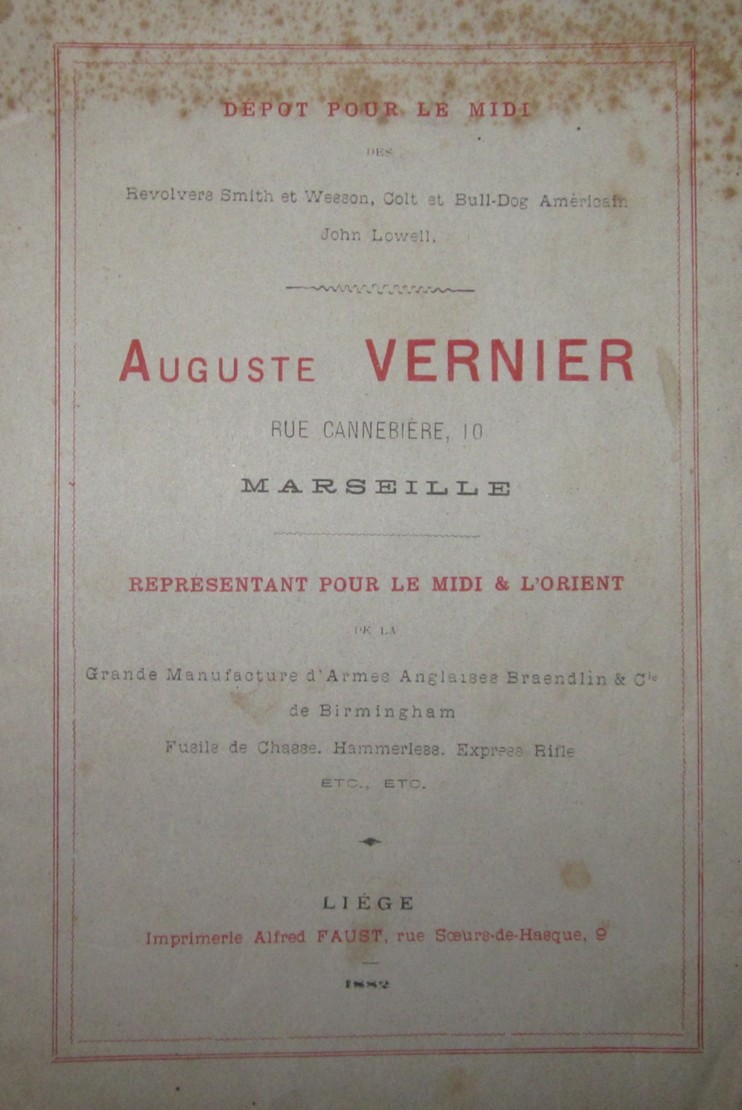
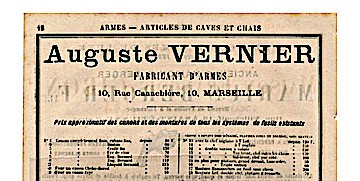
En conclusion, il s’agit d’un fusil de chasse à canons juxtaposés à poudre
noire, calibre 16, fabriqué à Liège potentiellement par l’armurier Albert
Spirlet pour une commercialisation à Marseille par son confrère Auguste
Vernier. L’examen des marquages et poinçons permet de fixer sa fabrication
entre 1878 et 1897, période d’usage de la mention « Non pour balle » et
compatible avec les autres marquages.
Chris
Identification 3883
Il s’agit ici d’un fusil à percussion d’origine
suisse. Malgré les restaurations effectuées par le propriétaire de l’arme
(remplacement de la baguette et de la hausse qui étaient manquantes), on
reconnaît un fusil réglementaire généralement dénommé
carabine
fédérale modèle 1851 (en allemand :
Eidgenössischer Stutzer 1851,
également appelé
Feldstutzer 1851).
Cette arme fut la première carabine militaire de l'armée suisse à être
procurée par la Confédération plutôt que d'être fournie par les cantons
respectifs de résidence des soldats. Une autre particularité est son calibre
de 10,5 puis 10,4 mm utilisé pour la première fois par une armée européenne.
Ce modèle fut remplacé en 1869 par le fusil Vetterli modèle 1869/70.
Sa genèse remonte à 1848, date à laquelle les cantons suisses jusqu’alors
indépendants décidèrent de former une alliance conduisant à la Confédération
Suisse, impliquant la création d’un ministère commun de l’armée. Une mission
essentielle de ce ministère fut d’harmoniser l’équipement des soldats, ce
qui conduisit à l’adoption de ce fusil modèle 1851.
Quelques caractéristiques fournies par le propriétaire :
Longueur totale 1,22 m avec canon de 85 cm. Calibre 10,4 mm rayé. Détente à
stetcher.
Ce fusil modèle 1851 fut construit par divers armuriers en Suisse et
d’autres nations, par exemple à Liège en Belgique par Beuret Frères entre
autres. On trouve sur le site LittleGun un exemple fabriqué par J.N. Peter à
Genève :
http://www.littlegun.info/arme%20suisse/ancien%20artisan/a%20peter%20j%20n%20%20fr.htm
L’exemplaire présenté ici porte le marquage «
Jules Poncet et fils à Genève
» sur la platine. Cet armurier était très réputé pour sa production de
carabines à percussion pour le tir de précision (voir par exemple Gazette
des Armes N°106). En l’absence de tout autre marquage, on peut donc penser
que cet artisan fut bien le fabricant de l’exemplaire examiné ici.
La destination militaire de cette arme justifie la possibilité d’accommoder
une baïonnette, comme montré sur le dessin original ci-dessous extrait de :
https://capandball.com/the-model-1851-feldstutzer-and-its-impact-on-rifle-development-part-1/#_ftn6

Sources :
Pour une étude complète incluant les données balistiques et les informations
sur les munitions, voir:
https://capandball.com/the-model-1851-feldstutzer-and-its-impact-on-rifle-development-part-1/#_ftn6
Chris
Identification 3885
Il s’agit d’un sympathique fusil
conçu sur le système « Rolling Block » de Remington inventé au milieu des
années 1860. Il possède un canon octogonal et son bloc culasse est gravé. On
distingue un monogramme sur plusieurs pièces de l’arme, mais celui-ci reste
non identifié. Le viseur est gradué pour plusieurs distances (100, 150 et
200 yards probablement). Le calibre et le type de munitions ne sont pas
précisés.
Les marquages « C.S.L. London »
et « Army & Navy » indiquent que le fusil était destiné à une
commercialisation par l’Army & Navy Co-Operative Society Limited. Cette
firme fut créée en 1871 par un groupe d’officiers de l’armée de terre et de
la marine britanniques. L’objectif était de distribuer à ses membres divers
articles aux meilleurs prix possible. Le premier magasin a ouvert ses portes
en février 1872 à Londres, et les armes y ont été commercialisées à partir
de 1873. On trouve sur le marché de la collection de nombreux revolvers et
armes d’épaule estampillés de cette coopérative, souvent provenant de Webley
et des autres artisans de Birmingham. Jusqu’à preuve du contraire, la
coopérative n’a jamais eu d’activité armurière et n’a été destinée qu’à la
distribution.
On peut voir d’autres exemplaires
de fusils Rolling Block vendus par la CSL sur les liens suivants :
https://www.vintageguns.co.uk/gun-sales/army-and-navy-6247
https://www.vintageguns.co.uk/magazine/an-army-and-navy-rolling-block-rifle
Le fabricant réel du fusil ne
peut pas être identifié par les données fournies. Aucun marquage spécifique
ne peut orienter la recherche. Même son origine géographique est incertaine,
seule une lettre sur le canon évoque un poinçon de contrôle belge, mais sans
certitude.
Marquages :
« C.S.L. London » et « Army &
Navy »
Numéro à 5 chiffres (?7142)
J sur le bois
68J
(?)
Il s’agit donc d’un fusil de type Rolling Block,
d’origine non identifiée, et commercialisé par
l’Army & Navy Co-Operative Society Limited
à Londres postérieurement à 1873.
Chris, HPH
Identification 3886
This is a very classic shotgun juxtaposed, equipped with external hammers,
with a “top lever” break key. Its Belgian origin is amply assumed by several
“Belgium” markings on the plate, the gun band and the wood.
In addition to the markings and markings typical of Liège production, which
are detailed below, the rifle is identified by the patent dates relating to
it (27 March, 14 April and 20 June 1883) as well as by the indication of its
model “The Universal”. This name
is a trademark registered on 18/11/1889 by
A. Simonis, J. Janssen & Dumoulin
Frères (S. J. & D.), whose firm existed from 1883-1884 to 1905:
https://littlegun.be/arme%20belge/artisans%20identifies%20s/a%20simonis%20janssen%20and%20dumoulin%20gb.htm
Below the link above is a rifle of the same company, very similar in
appearance to this one, but bearing the trademark
UNION MACHINE C° registered on
24.02.1887 (UNION MACHINE C° NEW-YORK).
It should be noted that all the indications are in English, suggesting that
S.J. & D. was at least partially
targeting the international market.
Markings, stamps:
Patd March 27 April 14
June 20 1883: patent dates.
Belgium.
The Universal:
indication of the model.
Laminated steel, on the
barrel strip.
Peron (little step) :
inspection, in use from 1853 to the present day.
Letter T.
Numbers: 36148, 7, 1556,
390, 210 (numbering of weapon elements).
G and S under asterisk :
: control countermarks, in use from January 27, 1877.
P (?) under crown.
17.8 and 18: 18-gauge
Choke.
Not for Ball: Shocked
smooth barrel, in use between 1878 and 1897.
EL in English cursives:
Liège punch for provisional black powder proofs, in use from 1852 to the
present day.
In conclusion, it is a
shotgun with juxtaposed black powder barrels, calibre 18, manufactured in
Liège by A. Simonis, J. Janssen &
Dumoulin Frères (S.J. & D.) with a view to potential international
marketing. Examination of markings and punches allows to establish its
manufacture between 1883 (patents) and 1897 (limit of use of the notation
Not pour ball).
Chris, HPH
Annex:



Identification 3890
Nous sommes en présence d’un beau
fusil de chasse de type « Drilling », doté de chiens externes, avec clé de
brisure « top lever ». Les Drillings ("Drilling" étant l'allemand pour
"triplet") se composent normalement de deux canons à alésage lisse assortis
et d'un canon rayé (allemand : Normaldrilling, Drilling
courant), mais peuvent couvrir une gamme beaucoup plus large de formes et de
configurations de canons. Étant donné que les Drillings étaient généralement
conçus par de petits fabricants, chacun d’entre eux choisissait la
disposition qu'il préférait ou s'adaptait à la disposition commandée par le
client. La disposition la plus courante était 2 canons lisses côte à côte
avec un canon rayé à percussion centrale en dessous, qui servait à donner le
« coup de grâce » au gibier blessé.
L’arme présente quelques
particularités par rapport à la plupart de ses congénères : les trois canons
semblent tous destinés à des cartouches à plombs, calibre 12 en
l’occurrence. On voit deux chiens et deux queues de détente pour les canons
supérieurs gauche et droite, mais les photos fournies ne permettent pas
d’identifier le mécanisme de percussion du canon inférieur. Serait-ce en
agissant sur l’espèce de sûreté en forme de poussoir derrière les chiens,
où l’on voit notamment un 3 ?
Marquages, poinçons:
L’arme porte les poinçons
réglementaires du banc d’épreuves de Liège, à savoir :
ELG sur étoile dans un ovale
couronné
: acceptation post 1893.
Perron
: inspection post 1853.
X et S sous étoile
: contremarques des contrôleurs post 1877.
12 C dans un losange
: calibre, en usage de 1898 à 1924.
EL en lettres cursives
: épreuve provisoire en usage de 1852 à nos jours.
P 1K923,4
: poids du canon pouvant tirer
des poudres sans fumée (armes lisses), en usage de 1892 à 1924.
D= 70mm/20,6
: Longueur de la chambre en mm et diamètre en mm après épreuve facultative à
la poudre sans fumée. En usage de 1892 à 1924.
Choke 18,4/17.3
: canons chokés. En usage de 1910 à 1924 (période
de fabrication).
Max 2 GR 13 poudre et 31 GR 50
PLOMBS
: charges pour poudre sans fumée.
La marque
A. GODEFROID Fabricant d’armes à
Liège rue de l’Université, 7 est bien entendu celle du fabricant de
l’arme. Il s’agit d’une entreprise inscrite au banc d’épreuves de Liège de
1898 à 1913, voir sur le site :
https://www.littlegun.be/arme%20belge/artisans%20identifies%20g/a%20godefroid%20a%20fr.htm
La période de production s’arrête à 1913, l’arme a donc été construite entre
1910 et 1913.
Chris, HPH, GP
We are dealing with a
beautiful shotgun of the "Drilling" type, equipped with external hammers,
with a "top lever" break key. Drillings ("Drilling" being German for
"triplet") normally consist of two matching smooth-bore barrels and one
striped barrel (German: Normaldrilling, common Drilling), but can cover a
much wider range of barrel shapes and configurations. Since Drillings were
generally designed by small manufacturers, each manufacturer chose the
layout they preferred or adapted to the layout ordered by the customer. The
most common arrangement was 2 smooth barrels side by side with a rifled
central percussion barrel underneath, which was used to give the "grace
blow" to wounded game.
The weapon has some
peculiarities compared to most of its congeners: the three barrels all seem
to be intended for lead cartridges, calibre 12 in this case. Two hammers and
two triggers are shown for the upper left and right barrels, but the
pictures provided do not identify the percussion mechanism of the lower
barrel. Could it be by acting on the kind of safety in the shape of a pusher
behind the hammers, where we see a 3 in particular?
Markings, stamps:
The weapon bears the
regulatory stamps of the Liège proofhouse, namely:
ELG on star in a
crowned oval: acceptance post 1893.
Peron (little step):
inspection post 1853.
X and S under
asterisk: countermarks of controllers post 1877.
12 C in a diamond:
calibre, in use from 1898 to 1924.
EL in cursive letters:
provisional proof in use from 1852 to the present day.
P 1K923.4: Barrel
weight capable of firing smokeless powder (smooth weapons), in use from 1892
to 1924.
D= 70mm/20.6 : Chamber
length in mm and diameter in mm after optional smoke-free powder test. In
use from 1892 to 1924.
Choke 18.4/17.3:
Shocked barrels. In use from 1910 to 1924 (period of manufacture).
Max 2 GR 13 powder and
31 GR 50 LEADS: filler for smokeless powder.
The brand
A. GODEFROID Manufacturer of
weapons in Liège rue de l’Université, 7 is of course that of the
manufacturer of the weapon. It is a company registered on the Liège
proofhouse from 1898 to 1913, see on the website.
The production period
ended in 1913, so the weapon was built between 1910 and 1913.
Chris, HPH, GP
Identification 3893
Voici deux fusils à tabatière, celui du haut portant des marquages britanniques et celui du bas des marquages belges. Ces fusils ont été obtenus par transformation d'une arme réglementaire (Enfield, BSA ?) selon le système Snider.
Historique de ce système, selon la source : https://pop.culture.gouv.fr/notice/palissy/IM40004069 :
« Bien que le fusil à percussion Enfield modèle 1853 des armées de la reine Victoria ait démontré sa fiabilité, la guerre de Crimée démontra la faiblesse des armes à chargement par la bouche, en termes de volume de tir notamment. Les Britanniques expérimentèrent alors plusieurs dispositifs permettant de convertir le fusil Enfield en arme à chargement par la culasse. Le système breveté par l'Américain Jacob Snider (1811-1866), permettant de multiplier par cinq la cadence de tir, fut finalement adopté en 1866, donnant naissance au fusil Enfield-Snider 1853/66 calibre .577. La conversion peu coûteuse proposée par Snider consistait à couper cinq centimètres du canon au tonnerre puis à fraiser une chambre où était vissé un bloc fermé par une culasse mobile portant le percuteur. La platine restait intacte tandis que le chien était légèrement désaxé. »
Fusil du haut :
On distingue une belle couronne britannique surmontant des lettres majuscules (on ne reconnaît pas l’attendu VR pour Victoria Regina, mais plutôt ER pour Edward Rex, soit Edouard VII, roi du Royaume-Uni de 1901 à 1910) derrière le chien, ainsi qu'une adresse se terminant par London devant le chien. Cependant il est curieux que la couronne soit le modèle réservé aux reines et non pas celui destiné aux rois… Ceci, ainsi que la date de production des Sniders bien antérieure à l’accession d’Edouard au trône, laisse supposer un remarquage ER par dessus VR.
Mettre illustration couronnes
Pour plus de détails sur les marquages britanniques, une belle étude :
Les première lignes de l'adresse sont illisibles sur les photos fournies. Sans image supplémentaire représentant les marquages, on peut supposer qu’il s’agit peut-être d’un fusil Enfield modifié Snider.
Fusil du bas :
Celui-ci est à l’évidence d’origine liégeoise selon ses marquages. Il a été probablement conçu à partir d’une arme réglementaire difficile à identifier après les modifications (nouveau bois).
Marquages sur le bois :
NJR : probablement marquage de l’artisan Nicolas Joseph Dessard, voir :
https://littlegun.be/arme%20belge/artisans%20identifies%20den/a%20dessart%20fr.htm
Nombre 208 : numéro de série ou indication pour le montage ?
Marquages sur les parties métalliques :
BF ou BE (?), B, non identifiés.
V. Dery, AC, non identifiés.
14.9 sur le canon, visiblement une surmarque qui correspond sans doute au calibre. Rappelons que les fusils Sniders étaient chambrés en calibre .577 ce qui correspond à 14,42 mm.
EL en cursives majuscules : épreuve provisoire depuis 1853 (canons fusils).
Sur le chien centralisé apparaît une signature Mercenier Guyot qu'on retrouve sur divers revolvers et ici :
S’agit-il d’une association momentanée entre ces deux artisans liégeois ?
https://www.littlegun.be/arme%20belge/artisans%20identifies%20m/a%20mercenier%20gerard%20fr.htm
https://www.littlegun.be/arme%20belge/artisans%20identifies%20g/a%20guyot%20j%20fr.htm
Ce fusil semble donc être un assemblage insolite composé par
plusieurs armuriers liégeois (Dessard, Mercenier et Guyot), à partir du
système Snider. Il a sans doute été construit entre 1866 et la fin du 19ème
siècle.
Anecdote :
Le 19 juillet 1870, la guerre Franco-Prussienne éclate. Le 1er Septembre 1870, à la bataille de Sedan l’Empereur Napoléon III est capturé ce qui provoque la chute du Second Empire. Le 4 Septembre à Paris, un Gouvernement Républicain dit "de La Défense Nationale" se met en place et décide de continuer la guerre et de chasser les Prussiens. La France manquait d’armes pour équiper ses bataillons de Mobiles de "la levée en masse" et il fut décidé d’acheter massivement tout ce qui était disponible à l’étranger. Parmi les très bonnes armes importées, on acheta en Angleterre plusieurs milliers de fusils Enfield Snider dans les versions longues et courtes. »
Chris, HPH, GP
Identification 3896
Voici un petit revolver d’origine
liégeoise en calibre 8 mm. Il est basé sur l’architecture des revolvers Bull
Dog et RIC, système inventé au milieu du 19ème siècle par
l’anglais Webley à Birmingham. Cependant ces revolvers étaient conçus pour
des munitions à poudre noire (en général .450, .442, .380 ou .320), alors
que celui-ci accommode la poudre sans fumée. En effet, l’invention de cet
explosif moderne par Paul Vieille en 1884 fit tomber la poudre noire en
désuétude. Dès 1886, l’armée française l’utilise dans le fusil Lebel, avant
une généralisation internationale. Dans le domaine des armes de poing, le
revolver d’ordonnance français modèle 1892 bénéficia d’une munition de 8 mm
à poudre vive. Les fabricants d’armes pour le marché civil se tournèrent
donc rapidement vers l’adaptation de petits revolvers pour ces munitions
modernes. Par exemple, le catalogue Manufrance proposa au début du 20ème
siècle une déclinaison de revolvers dit « renforcés » en calibre 8 mm («
L’Agent », « Le Municipal », etc), destinés aux civils mais aussi en tant
qu’armes de « back-up » pour les professionnels (militaires et forces de
l’ordre) déjà munis d’un revolver d’ordonnance.
L’exemplaire examiné ici possède une finition bronzée. Il est muni d’un canon octogonal et d’une poignée carrée avec un anneau de calotte. Le barillet comporte 5 chambres. De façon plus inhabituelle pour ce type d’arme de poche, il est doté d’un système de sûreté sur le côté droit de la carcasse. Celui-ci consiste en une vis-poussoir de sécurité qui permet de faire tourner uniquement le barillet en actionnant la détente sans provoquer la percussion, ou de bloquer la détente si le marteau est armé. Ce dispositif rappelle le système Abadie.
Tout indique une arme simple, de
bonne qualité, fiable et bien conservée.
Marquages
:
ELG en ovale sous couronne :
poinçon d’épreuve de Liège postérieur à 1893.
« Acier fondu », sur la bande du
canon.
Chiffre 6 (ou 9 selon sens de
lecture), arrière du barillet.
R sous couronne, côté droit du
canon : marque de vérification des armes de poing à canon rayé, en vigueur
de 1894 à 1968.
AC sous étoile, côté droit du
canon et carcasse, arrière du barillet : poinçon du contrôleur, postérieur à
1877.
TL, EN et PW sous les plaquettes
: marques de sous-traitants ?
Initiales LAM côté gauche de la
carcasse : initiales du fabricant Léopold Ancion MARX, inscrit au banc d’épreuve de 1890 à 1979 et bien
répertorié sur le site, voir :
https://littlegun.be/arme%20belge/artisans%20identifies%20a/a%20ancion%20marx%20fr.htm
https://littlegun.be/arme%20belge/artisans%20identifies%20a/a%20ancion%20marx%20bull%20dog%20fr.htm
En conclusion il s’agit d’un revolver en calibre 8 mm en 5 coups, basé sur
l’architecture du système RIC et produit par la firme liégeoise de Léopold
Ancion Marx postérieurement à 1894 selon l’examen des poinçons.
Chris, HPH
Identification 3897
Voici un inhabituel petit
pistolet de poche à la finition nickelée, en calibre 6,35 mm, doté de
plaquettes claires probablement en os ou en corne ainsi que d’une sûreté. Le
calibre 6,35 (ou .25 ACP), issu des recherches de l'américain John
Moses Browning, fut développé à partir de 1903-1906. Le fonctionnement
semi-automatique de la plupart des pistolets utilisant cette munition ainsi
que leur compacité séduisirent rapidement le marché européen de l’arme de
poche et firent tomber en désuétude les petits revolvers de poche à broche
ou à percussion centrale comme les Bull Dogs.
Une multitude de modèles
exploitant le concept furent mis sur le marché durant le premier quart du 20ème
siècle, soit par de grandes firmes armurières (Webley, FN, Unique, Clément,
Manufrance, Mann, etc.) soit par des artisans de plusieurs nations
européennes (Belgique, Angleterre, France, Espagne) qui développèrent chacun
leur propres interprétations, améliorations et variantes.
Marquages :
Perron : poinçon sur la queue de
culasse, qui est le poinçon de l’inspecteur du
B.E.
(valable
du 16.06.1853 à nos jours).
C sous étoile : poinçon du
contrôleur, valable à partir de 1877.
PV sous lion dressé: épreuve à la
poudre sans fumée (poudre vive) depuis 1898 – mais en fait depuis 1903.
ELG sur étoile dans un ovale
couronné : poinçon du banc
d’épreuve postérieur à 1893.
R couronné : marque de
vérification des armes de poing à canons rayés : du 30 janvier 1894
au 26 février 1968.
On distingue un poinçon à
l’intérieur du bloc-culasse pouvant être le chiffre 7, qui serait alors un
numéro de série.
En l’absence de marquage
permettant d’identifier directement le fabricant du pistolet, il a été
suggéré de le comparer au modèle Vici attribué à Henrard et Discry, voir :
https://www.littlegun.be/arme%20belge/artisans%20identifies%20h/a%20henrard%20and%20discry%20fr.htm
En effet les deux armes
présentent des analogies de forme. L’équipe dispose de nombreux brevets
déposés par Jean Henrard sur ce type de pistolets. Cependant leur analyse ne
permet pas de retrouver la trace de ce modèle précis. Plusieurs différences
entre les deux armes sont évidentes, en particulier l’absence de
glissière externe sur l’exemplaire examiné ici ainsi que son original pontet
articulé dont la fonction, selon le propriétaire, est de servir à bloquer et
débloquer le chargeur.
Cependant un membre de l’équipe a
mis en lumière un brevet déposé à Liège par l’armurier Pierre Coune le 25
janvier 1919 (N° 278900), qui décrit « un système de pistolet automatique
par déflagration de gaz à sûreté spéciale ». L’examen du descriptif de
ce brevet ainsi que des schémas inclus démontrent sans équivoque que le
pistolet examiné ici est un exemplaire fabriqué selon ce brevet. Les
principales revendications de l’auteur portent sur :
1. l’obturateur et le percuteur ne formant qu’une seule pièce,
2. la sous-garde à bascule, calant à la fois le canon et le magasin,
3. la sûreté empêchant tout déclenchement quand le magasin est
enlevé.
Ces spécifications correspondent
bien au pistolet considéré ici, que l’on peut donc attribuer à Pierre COUNE,
armurier rue de Neuville, 114 Cheratte (1906-1919). Celui-ci déposa
plusieurs brevets en Belgique :
- n°
191992 – 24/04/1906 Revolver
à cylindre renversant
- n°
213904 – 01/09/1909 Système
de platine de pistolet automatique
- n°
217556 – 28/06/1909 Pistolet
automatique (brvt ppal n° 213904 du 01/02/1909)
- n°
278900 – 25/01/1919 Système
de pistolet automatique par déflagration de gaz à sûreté spéciale.
Ce pistolet en calibre 6,35 a donc été fabriqué à Liège, postérieurement à
1919 (date du brevet) selon l’invention de l’armurier Pierre Coune. et
probablement durant les années 1920. Il s’agit certainement d’une pièce
d’une réelle rareté.
Anecdote :
Le calibre 6,35 a acquis une
certaine notoriété dans l'histoire de France avec l'assassinat de Gaston
Calmette, rédacteur en chef du
Figaro par madame Caillaux, épouse du ministre de l'Industrie, que le
journal avait diffamé. Un journaliste s'exclama à l'époque : il n'y a plus
de débat politique, il y a le 6,35 !
Dans l'après-midi du 16 mars
1914, Henriette Caillaux, décidée à défendre la réputation de son mari et la
sienne mais épuisée nerveusement après une campagne de presse de trois mois,
achète pour 55 francs chez l'armurier de la bourgeoisie Gastinne Rennette un
petit Browning modèle 1906.
Après un essai au stand de l’armurier, elle se rend au journal et vide son
chargeur de 6 munitions sur Calmette qui ne survivra pas à ses blessures.
D’une façon qui peut surprendre de nos jours, elle fut acquittée le 28
juillet 1914.
Voir :
https://fr.wikipedia.org/wiki/Henriette_Caillaux
Chris, Max, HPH, GP, PHL, MD, Alain
Identification 3898
Le fusil examiné ici est
identique à une arme déjà décrite de façon exhaustive et précise sur le
site, sous le lien suivant :
https://littlegun.be/collection%20privee/belgique/be%20klmno/a%20be%20leverd%20et%20counet%20fr.htm
Le texte d’un membre de l’équipe (GP) figurant dans cette fiche est repris
in extenso ci-dessous, à l’exception des marquages qui diffèrent
partiellement entre les deux armes :
« Il s’agit d’un fusil se
démontant en deux parties, canon et crosse anglaise contenant le mécanisme
de mise à feu, sans longuesse. Arme typique de braconnier, il figure dans
certains catalogues anciens, sous le nom de système Leverd ou Levert. Le
canon se fixe dans le boîtier selon un système comparable à celui d’une
baïonnette à douille. Il s’agit quasi certainement d’un avatar du brevet
106283 déposé en 1893 par MM. Jean-Jacques Leverd et Counet.
Assurément un bien drôle d’engin
dont l’identification aurait sans doute pris "un certain temps" si la copie
du catalogue n° 53 de 1912 de la maison J.B. Rongé Fils n’était pas tombée
entre nos mains. En page 46 y figure en effet ce drôle de vistemboire
attribué à Jean-Jacques Leverd, qui existait en plusieurs versions, ne
serait-ce déjà que pour la crosse : crosse pistolet ou anglaise, avec ou
sans joue. Tous les calibres étaient disponibles, du 12 au 12 mm en passant
par le 16, 20, 24, 28, 32 et 14 mm. Cet exemplaire est en deux pièces, mais
il existait également des versions en trois pièces (avec canon brisé) et en
quatre pièces, avec canon et crosse brisés. Le système est directement
dérivé de celui d’une baïonnette à douille. Le canon, muni de deux tétons de
grandeur différente, s’encastre dans la culasse et se bloque après un petit
mouvement rotatif. Le canon se libère après avoir appuyé avec le pouce droit
sur le bec d’un ressort d’un peu plus d’un demi-cercle qui bloque le petit
téton inférieur. L’opération est très rapide et doit se faire après le tir
de chaque cartouche. Inutile de dire que ce type d’arme a certainement dû se
retrouver plus souvent entre les mains d’un braconnier que d’un honnête
chasseur. Le catalogue Rongé ne mentionne hélas pas les prix, mais il ne
fait pas de doute qu’il ne devait pas être très élevé, en tout cas à la
fabrication.
On ne sait en tout cas pas
grand-chose de ce Jean-Jacques Leverd : le "Qui est qui de l’armurerie
liégeoise" nous apprend que c’était un fabricant d’armes à Cheratte entre
1893 et 1902. Il a déposé deux brevets : l’un concernant des modifications
aux fusils à canon simple, démontable (avec Counet) en 1893 et l’autre, en
1902, portant sur une modification aux carabines Flobert.
Dans un premier temps, comme le
dessin du brevet 106283 de 1893 montrait une clé latérale, nous avons pensé
qu’il s’agissait d’une variante du système Leclercq pour fusils pliants bien
connu dans la production armurière liégeoise. Mais un autre membre de
l’équipe (grand merci à lui) a bien remarqué que le brevet portait en fait
sur un canon qui se glisse dans un boîtier et est libéré en appuyant sur la
clé latérale. Il y a peut-être eu un autre brevet concernant le système de
ce fusil-ci, à savoir le maintien par deux tétons et une espèce de
(demi)-virole (en fait un ressort) comme sur les baïonnettes à douille, mais
il ne nous est – actuellement - pas connu. Néanmoins, on peut dire que ce
fusil est à mettre en rapport avec Leverd et Counet, ne serait-ce aussi
que par la présence du marquage « L&C Breveté » dans
un ovale.
Le catalogue Alpha de 1911
présente aussi ce fusil en bas de page 298. Notons l'autre orthographe
(Levert au lieu de Leverd), mais on avait à l’époque une autre notion de
l’orthographe des noms propres. Il s'agit d'une crosse pistolet à joue, et
tous les calibres sont disponibles, du 12 au 410, pour un prix variant entre
31 et 42,50 marks. A cela s’ajoute aussi que d'autres armuriers n'ont pas
hésité à mettre ce fusil pour le moins particulier dans leur catalogue.
Ainsi, à la page 40 d'un catalogue de Joseph Saive (évidemment non daté), on
retrouve l'engin type 82, cette fois qualifié de FUSIL SUISSE marque
"Champion" (voir aussi la notice sur un fusil Leverd identique du site
littlegun.be, hormis en matière de marquages). A noter qu'il n'existe, dans
le catalogue de J. Saive, que dans la version la plus simple de crosse
anglaise et sans joue, et dans un seul calibre, le 16, comme le fusil évoqué
sur le site. Pour être tout à fait complet, et comme on dit "dans l’état
actuel de nos connaissances", un troisième exemplaire connu de cet fusil est
exposé dans une salle historique du Fort II de Wijnegem près d’Anvers (en
tant qu’arme ayant servi à un résistant…), mais dans un état qui ne permet
pas l’examen des marquages. »
Marquages :
Perron sur un des tétons et sur
le guidon : inspection depuis 1853.
EL : épreuve provisoire depuis
1852.
C sous étoile et I (ou T ?) sous
étoile : contremarques de contrôleurs depuis 1877.
967 est sans doute le numéro de
l’arme.
L&C Btés dans un ovale : à
attribuer à Jean-Jacques Leverd et Counet qui ont déposé en 1893 un brevet
d’invention intitulé « modifications aux fusils à canon simple démontable ».
16.7 est sans doute le diamètre
du canon, soit celui d’un calibre 16. Comme, entre 1898 et 1924, le marquage
d’un canon se présente dans un losange avec le calibre au-dessus du C, on
peut dire que l’arme est (quasi certainement) antérieure à 1898. En effet, à
partir de 1924, le calibre et la longueur de la chambre figurent dans un
oméga couché.
ELG sur étoile dans un ovale
couronné, aux deux extrémités du canon : poinçon d’épreuve postérieur à
1893.
LLH : Ces initiales se réfèrent
probablement à Laurent Lochet-Habran qui aurait fabriqué au moins le canon,
voir :
https://littlegun.be/arme%20belge/artisans%20identifies%20l/a%20lochet%20habran%20laurent%20fr.htm
En conclusion, c’est un fusil dit « de braconnier », en calibre 16, fabriqué
à Liège entre 1893 et 1898 selon un brevet de
Leverd et Counet. Le fabricant peut être cette même équipe, avec
l’aide de Laurent Lochet-Habran
pour le canon.
Chris, HPH, Alain, GP
Identification 3903
Here is a beautiful
shotgun with two side-by-side barrels. The percussion system is of the
"hammerless" type, with a "top lever" break key. The metal parts are
artistically engraved with hunting scenes (dogs, furred and feathered game),
signed A. Gob.
This engraver is,
among other things, described in the last volume (The Addendum) of Alain
Daubresse's encyclopedia " Liege gunmakers through their work".
The shotgun appears to
be in excellent condition and of a high standard of quality.
Markings:
Mark representing a
blacksmith in front of his anvil: mark of Alphonse FORGERON (B.E. 1880/1932)
rue Adolphe Borgnet, 5 then 4 in LIEGE.
Photo Illustration
http://littlegun.be/arme%20belge/artisans%20identifies%20e%20f/a%20forgeron%20gb.htm
Lowercase letter q:
annual letter of 1938.
1 kg 291: weight of
the barrel, in use since 1924.
AH under star, P under
star: countermarks of controllers, in use from January 27, 1877.
PV under raised lion:
smokeless powder proof in use since 1898 (in fact since 1903).
ELG on star in crowned
oval: hallmark of the proofhouse in force from 1893.
16-70 in omega:
nominal caliber and length of case, in use from 1924 to the present day.
Number 37129 and
number 4: serial number and/or indication for assembly?
Peron: inspection, in
use from 1853 to the present day.
"Royal Compressed
Steel" on the barrel: manufacturer of the barrel. NB: Forgeron's rifles
known on the site have barrels with different markings (Cap, Falla, Royal
Compressed Steel with or without crown), which suggests that he used
subcontractors for the barrels.
In conclusion, this is
therefore a beautiful 16 gauge hunting rifle, engraved by the artist A. Gob
and manufactured in Liège by the gunsmith Alphonse Forgeron in 1938.
Chris
Identification 3905
This beautiful shotgun
is presented as a very classic Anson & Deeley side-by-side with false locks.
The metal parts are artistically engraved (floral patterns), the foregrip
and butt are partially checkered. The rifle appears to be in excellent
condition and of a good quality standard.
Markings:
H under star, UA
joined under star: countermarks of controllers, in use from January 27,
1877.
ELG on star in crowned
oval: hallmark of the proof house in force from 1893.
EL in cursive:
provisional proof since 1853 (rifle barrels).
12 C in diamond:
caliber hallmark between 1898 and 1924.
Number 23670: serial
number, surprisingly erroneous under the trigger guard (25670 instead of
23670 as on the other parts of the weapon).
Peron (Little step) :
inspection, in use from 1853 to the present day.
17.8 and 18.2 (right
barrel), 17.3 and 18.3 (left barrel): choke.
Capital letter V in a
circle: marking not assigned.
There is no lowercase
annal letter (in force since 1922).
Stanley Arms Co
London-Liège: According to the following source, this is a brand belonging
to the Wiebusch & Hilger Co. company in New York City. This company was a
dealer in weapons from Liège, and a distributor of various manufactured
products (razors, knives, etc.):
https://www.ima-usa.com/products/original-u-s-belgian-made-16-gauge-double-barrel-hammer-shotgun-by-stanley-arms-co-serial-1134-circa-1891?
The imported rifles
were allegedly produced by several Liège manufacturers, such as Demarteau,
Dumoulin, Pieper and Simonis. Most of these claims come from the following
link, which is very rich in information unfortunately not certified by
authentic documents, which invites us to remain in the conditional:
https://www.shotgunworld.com/threads/stanley-arms-company-shotgun.353873/
In conclusion, this
12-gauge side-by-side shotgun was manufactured in Liège by an unidentified
craftsman, for import to New York. It was manufactured between 1898
(diamond-shaped caliber) and 1921 (absence of annals letter).
Chris, GP
Identification 3906
Nous avons ici un «classique» fusil modèle 1866, dit «Chassepot», qui est le
premier fusil réglementaire à chargement par la culasse de l’armée
française.
Marquages :
S 1867 : millésime de l’arme. Le S signifie manufacture de Saint-Etienne.
F 36255 : numéro de série.
A.F
350, 4 sur la mire.
B et D dans un cercle : marquages de contrôles des inspecteurs.
1, plaque de couche.
PRODUCTION ANNUELLE : (Arrêt de la
production en Juillet 1875)
D’après les archives de la MAS :
1867
( 95 000 ex )
F1 –
F95000, prévus 95 000 exemplaires, en fait
69 864 exemplaires.
L’arme est marquée J. Pire et Cie, Anvers. Ces établissements
sont bien identifiés sur le site, voir :
https://littlegun.be/arme%20belge/artisans%20identifies%20p/a%20pire%20gb.htm
Cette entreprise vendait, outre des armes "modernes" contemporaines, des
armes militaires "déclassées" issues de stocks de divers pays. Certaines
étaient démilitarisées - c'est-à-dire qu'on enlevait les éléments ayant un
caractère militaire (fixations pour la baïonnette par exemple) - et
transformées pour la chasse. D'autres étaient vendues comme arme de panoplie
pour les collectionneurs et autres. Ce fusil Chassepot Mle 1866 en est un
exemple (annexe page du catalogue Pire de 1905 - N°92) ci-dessous :
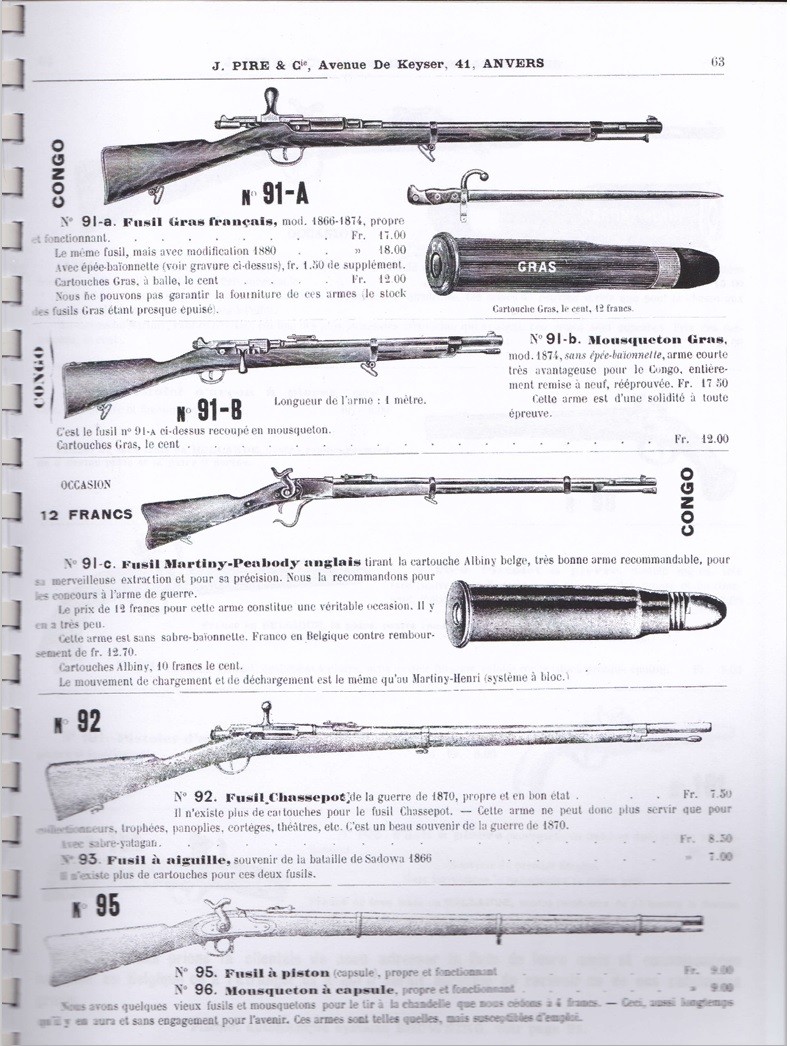
Pour en savoir plus :
https://www.littlegun.info/arme%20francaise/artisans%20c%20d/a%20chassepot%201866%20gb.htm
https://fr.wikipedia.org/wiki/Chassepot_mod%C3%A8le_1866
Anecdotes et culture populaire :
En raison de son implication dans plusieurs épisodes tragiques de l’Histoire
de France (Guerre franco-prussienne, Guerre Garibaldienne et Commune de
Paris en 1870-1871), le fusil Chassepot est devenu légendaire dans
l’imaginaire collectif français. Le sabre-baïonnette Chassepot restera
d’ailleurs en service jusqu’après la guerre de 14-18, porté par les
fonctionnaires des forces de l'ordre (gendarmerie, police municipale, gardes
champêtres).
Par exemple, le 9 novembre 1867, après avoir fait six cents morts dans les
rangs garibaldiens, le général de Failly a écrit enthousiaste au ministre de
la guerre Adolphe Niel : «Nos fusils Chassepot ont fait merveille !».
Le Chassepot est cité dans plusieurs chansons communardes :
La semaine sanglante de Jean-Baptiste Clément
:
Demain les manons, les lorettes
Et les dames des beaux faubourgs
Porteront sur leurs collerettes
Des chassepots et des tambours
Elle n’est pas morte d’Eugène Pottier,
par ailleurs auteur de «l’Internationale»
:
On l'a tuée à coups d'chassepots,
À coups de mitrailleuses,
Et roulée avec son drapeau
Dans la terre argileuse !
Jean Misère du même Eugène Pottier :
Maigre salaire et nul repos,
Il faut qu’on s’y fasse ou qu’on crève,
Bonnets carrés et chassepots
Ne se mettent jamais en grève.
Le Capitaine «Au mur» de Jean-Baptiste Clément :
Fais-moi vite trouer la peau,
Car j’en ai fait de la besogne
Avec mon chassepot.
Et d’un’, tu vois la lune !
Et d’ deux : viv’ la Commune !
Il est également cité à plusieurs reprises dans le roman d’Emile Zola, «La
Débacle» :
«Mais, surtout, ce qu’on heurtait à chaque pas, c’étaient des débris
d’armes, des sabres, des baïonnettes, des chassepots, en si
grand nombre, qu’ils semblaient être une végétation de la terre, une moisson
qui aurait poussé, en un jour abominable…
… Pourtant, un garçon de treize à quatorze ans laissa Prosper l’approcher,
et comme celui-ci, en reconnaissant un Français, le couvrait d’injures, ce
garçon protesta. Quoi donc ! est-ce qu’on ne pouvait plus gagner sa vie ? Le
matin, ayant fui de son village, le ventre vide depuis la veille, il s’était
laissé embaucher par un entrepreneur luxembourgeois, qui avait traité avec
les Prussiens, pour cette récolte des fusils sur le champ de bataille.
Ceux-ci, en effet, craignaient que les armes, si elles
étaient recueillies par les paysans de la frontière, ne fussent portées en
Belgique, pour rentrer de là en France. Et toute une nuée de pauvres
diables étaient à la chasse des fusils, cherchant des cinq sous, fouillant
les herbes, pareils à ces femmes qui, la taille ployée, vont cueillir des
pissenlits dans les prés».
Ce dernier passage est particulièrement significatif en mentionnant la
relation avec la Belgique, apte à récupérer ces fusils afin de les
«blanchir» en vue d’un retour en France, ce qui est particulièrement
pertinent par rapport à l’exemplaire examiné ici.
On notera les aspects poignants et dramatiques des chansons et textes cités
ici...
Enfin, on retrouve aussi le Chassepot dans l'un des textes de Jean Richepin
dans son livre «Les Morts bizarres»
qui porte d'ailleurs le titre suivant : «Le Chassepot du petit Jésus».
Peu exploité au cinéma, on voit néanmoins des Chassepot dans la comédie
musicale «Chitty Chitty Bang Bang» de Ken Hughes en 1968, inspirée d’un
roman de Ian Fleming (auteur des James Bond) aux mains de soldats.
Source (entre autres) :
https://fr.wikipedia.org/wiki/Chassepot_mod%C3%A8le_1866
Chris, HPH
Identification 3914
This is a Swiss
federal percussion rifle, model 1842, with 16 right-handed grooves and
equipped with a very special bayonet. Already very rare, this set becomes
extremely rare when the scabbard is present. The weapon is equipped with
precision sights (diopter, tunnel front sight, adjustable rear sight). The
caliber of these rifles is between 15 mm and 16.5 mm.
Note: in Switzerland,
all weapons that have 2 triggers are called Carbines.
The origin of this
rifle is not easy to determine based on the images present. The weapon and
the scabbard have the same number 94. The lock bears a signature that could
be that of the gunsmith Moser. This craftsman, named Samuel, was domiciled
in Frutigen in the canton of Bern. He was active from 1828 to 1844. He also
worked for the Bern arsenal. His trace can be found on the site:
https://www.littlegun.info/arme%20suisse/ancien%20artisan/a%20moser%20s%20fr.htm

However, the
inscription remains questionable, the photos do not allow a definitive
reading. For example, we can also read "Morges", like the city in the canton
of Vaud that had a gunsmithing tradition, see for example the history in the
following link:
https://www.westernguns.fr/armes-a-poudre-noire/armes-d-epaule/antique/770-bristlen-a-morges-pedersoli.html
The rifle also has,
like many Swiss weapons, a coat of arms on the barrel. This shows two bands,
one darkened by checkering at the top and a smoother one at the bottom. This
part is marked with the letter F. The only one of the 26 Swiss cantons with
this initial is that of Fribourg. Its flag is shown below with an
enlargement of the coat of arms of the weapon:
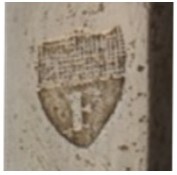
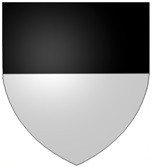
On the rifle
Coat of
arms of the canton of Fribourg
The letter F and the
appearance of the coat of arms strongly suggest that the rifle was used in
the canton of Fribourg.
Chris, Max, HPH, Alain
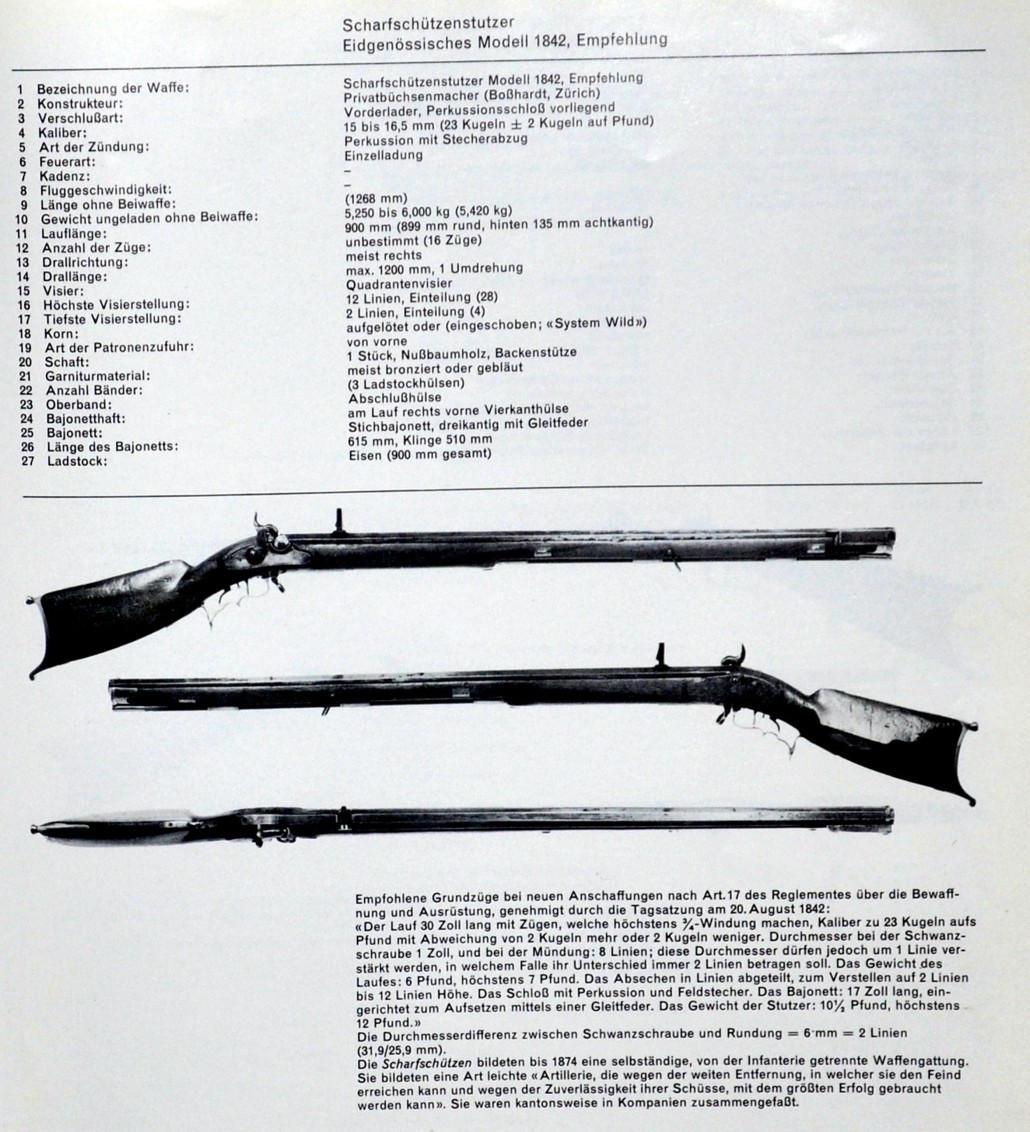

Identification 3920
Here is a shotgun with two side-by-side barrels and visible hammers. Classic
with its double trigger, its "top lever" opening system and its engraved
plate, the weapon seems to be of a high standard of quality.
Markings:
Numbers 20702 and 28: serial number and assembly assistance?
Peron, on the breech tail, punch of the inspector of the profhouse of Liège
(valid from 06.16.1853 to the present day).
PV under a standing lion, proof with smokeless powder (live powder) since
1898.
N under a star, AV joined under a star, control marks from January 27, 1877.
ELG on a star in a crowned oval, proofhouse after 1893.
12C in a diamond, caliber of the weapon, in use from 1898 to 1924.
P.1K470, weight of the barrel capable of firing smokeless powder (smooth
weapons), 1892-1924.
EL in cursive, provisional proof since 1853 (rifle barrels).
In the absence of an annual letter on the available photos, we can assume
that the rifle is prior to 1922.
Specific markings:
Fluss Stahl F-Krupp Essen on the barrels, under a logo representing an
eagle, this is the type of steel used for the barrels, see also anecdote
section.
Nouvelle Fermeture Brevetée à 5 Verrous (New Patented Closure with 5 Locks),
on the right barrel.
Dreadnought, band of barrels. Dreadnought (in English abbreviation of which
dreads nought, "which fears nothing")
Dumoulin & Cie Fts d’Armes
de Luxe Liège,
manufacturer of the weapon, company located rue Thier de la fontaine, 2. The
company was registered with the Liège
proofhouse from 1908 to 1968 and is listed on the site:
https://littlegun.be/arme%20belge/artisans%20identifies%20den/a%20dumoulin%20francois%20et%20cie%20fr.htm
Translations: Fluss Stahl = Hardened Steel.
Dreadnought = Battleship, and by extension very solid object.
Anecdotes:
The German company Krupp, located in Essen, is historically specialized in
the steel industry where it acquired an international reputation, however
tainted by its proximity to the Nazi regime during the Second World War, for
which it will produce large quantities of weapons with obvious complicity.
In a speech, Hitler urged German youth to "become as hard as Krupp steel"!
For more information, see:
https://fr.wikipedia.org/wiki/Alfred_Krupp
https://www.connexion-emploi.com/fr/a/un-exemple-d-entreprise-en-allemagne-krupp-200-ans-d-histoire-industrielle-entre-ombre-et-lumiere
Previously, Baroness Bertha Krupp Von Bohlen und Halbeck was sometimes
nicknamed "Lady Dreadnought", source:
https://www.printsandephemera.com/ourshop/prod_7863199-My-Lady-Dreadnought-Baroness-Krupp-Von-Bohlen-Und-Halbeck-1909.html
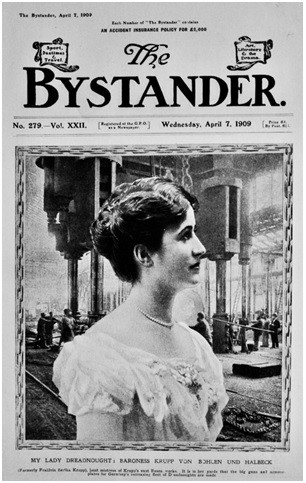
It remains in history for having given its nickname to the famous German
cannon "Big Bertha" during the First World War, see:
https://fr.wikipedia.org/wiki/Bertha_Krupp
In conclusion, this hunting rifle was produced by Dumoulin & Cie in Liège,
and its barrels made from Krupp hardened steel, between 1898 and 1922
according to the available punches.
Chris, HPH
Identification 3929
This is a Giffard type air rifle. This French inventor distinguished
himself with his original liquefied gas parlor rifles produced in
Saint-Etienne, see:
http://www.littlegun.info/arme%20francaise/artisans%20e%20f%20g%20h%20i%20j/a%20giffard%20paul%20fr.htm
The 1900 catalogue of the Saint-Etienne Manufacture offered 3 versions:
- 6 mm rifled barrel
- 8 mm rifled barrel for shooting bullets
- 8 mm smooth barrel for shooting lead shot
Giffard also filed a good number of patents in Belgium for various
rifles. He founded an air gun factory in Liège in 1865.
The rifle examined here bears a marking attributing its paternity to Paul
Giffard: P. Giffard brevet. The model was patented in Brussels on December
30, 1865 (patent 18946), a plate of which is reproduced below:
Illustration-01
The weapon also shows the markings CB 88 and Warnant on the lock, as well
as the initials JC on the wood. These are the markings that question the
owner of the weapon.
JC at this location: workshop mark.
The mention "CB88" could mean "Conical Bullet 8 mm for both bullet and
pellet shooting".
The mention of a member of the Warnant family is unexpected. Which
Warnant is it and what was his involvement (mechanism: cocking, opening,
percussion, operation, or simple subcontracting?)? The members of the
dynasty are well known on the site:
https://www.littlegun.be/arme%20belge/artisans%20identifies%20t%20w/a%20warnant%20famille%20fr.htm
To possibly answer this question, it would be necessary to have
additional information from new photos showing the operating mode of the
rifle.
Chris, HPH, Max, Marcel
Identification 3930
Ce revolver assez peu courant, en calibre 9 mm Gasser et fabriqué en Belgique, est un modèle de type Gasser Kropatschek M1876 d’officier, sans doute ici destiné au marché civil ou encore comme arme personnelle pour un officier austro-hongrois.
Pour une description du revolver
originel, voir :
http://www.hungariae.com/Gass76.htm
C’est une variante en moyen
calibre du revolver Gasser 1870, ce dernier ayant été conçu comme arme
réglementaire pour la cavalerie austro-hongroise. Le modèle 1870, plus
imposant et massif que le 1876, chambre le 11 mm Gasser. Cette arme donnera
naissance à la fameuse lignée des revolvers Gasser Monténégrins. Pour
davantage de détails, voir :
http://www.armeetpassion.com/gasser1870.html
Le revolver étudié ici comporte
toutes les caractéristiques du Gasser M1876 : poignée ronde avec anneau de
calotte, cadre ouvert d’inspiration Lefaucheux, busc marqué, baguette
d’extraction tenue par une lame fixée par une vis papillon.
Marquages :
Carcasse sous plaquette : Chiffre
5 et signes indéchiffrables
Chiffre romain IV (interprétation
plus vraisemblable que lettres
majuscules I et V)
Initiales LF entre deux étoiles
en ovale, sigle du fabricant (voir plus
bas)
Arrière barillet : ELG sur étoile en ovale, banc d’épreuve du 8 septembre 1846 au 11 juillet 1893
H sous étoile, poinçon de
contrôle, à partir du 27 janvier 1877
Carcasse côté droit : Nombre 1561 (sous réserve car la photo n’est pas assez nette pour une
certitude), numéro de série ?
Les initiales LF désignent sans aucun doute le fabricant du revolver.
Cependant leur présentation entre
deux étoiles dans un ovale est inédite, ce qui interdit toute identification
certaine. Les artisans ayant utilisé ces initiales sont peu nombreux :
Lambert Fabry :
https://littlegun.be/arme%20belge/artisans%20identifies%20e%20f/a%20fabry%20lambert%20fr.htm
Eugène Lefaucheux qui signait généralement ses armes belges par EL sous couronne, mais parfois également par LF sous un pistolet brisé à l’instar de ses armes françaises :
https://littlegun.be/arme%20belge/artisans%20identifies%20l/a%20lefaucheux%20eugene%20fr.htm
Lepage Frères, firme ayant signé ses productions soit par l’indication entière du nom soit par les initiales LF sous lion dressé dans un blason :
https://www.littlegun.be/arme%20belge/artisans%20identifies%20l/a%20lepage%20freres%20fr.htm
Il est impossible de trancher de manière absolue, d’autant plus qu’un artisan méconnu aurait pu produire cette arme.
Néanmoins la probabilité que la
firme Lepage Frères ait testé ce logo avant d’opter finalement pour le
blason avec lion dressé est séduisante.
En conclusion, ce revolver est un Gasser Kropatschek M1876 d’officier fabriqué en Belgique par une firme non déterminée avec certitude mais qui pourrait être Lepage Frères.
L’analyse des marquages indique une production située entre 1877 et 1893,
intervalle de temps pleinement compatible avec le millésime du modèle.
Chris, HPH, Alain
Identification 3931
This is a small rifle
in caliber 410 (12 mm).
Characteristics:
Side-by-side barrels,
double trigger, internal hammer and opening by key of the "Leclercq" type.
Finely checkered wood, pistol grip.
Markings:
L in a circle (?).
15802, serial number
(?).
10.3 (actual caliber
in mm), in use from 1889 to the present day.
Perron, on the breech
tail, punch of the inspector of the
proofhouse of Liège
(valid from 06.16.1853 to the present day).
ELG on star in
crowned oval, proof bench after 1893.
Caliber in a diamond
(12 MC), caliber, in use from 1898 to 1924.
P, I and AE joined
under star, control punches from January 27, 1877.
EL in cursive,
provisional proof since 1853 (rifle barrels).
The band of the
barrels bears the name of the dealer: Juan Seyler Santiago-Valparaiso. This
importer is known for having brought weapons to Chile from Liège, see for
example:
We can find several
traces of this gunsmith on the internet
:

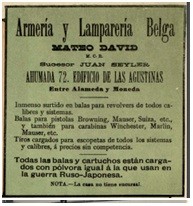
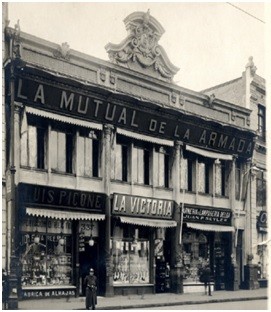
The Belgian rifle
visible in the previous link came from the Manufacture Liégeoise d’Armes à
Feu. It is tempting to suggest that this one also came from there, however
we will note the absence of the crowned ML marking specific to this company.
We do indeed find “Leclercq” key rifles in the ML catalog, see:
In conclusion, this
small rifle in caliber 410 was produced in Liège to be distributed in Chile
by the importer Juan Seyler. It is possible that the manufacturer was the
Manufacture Liégeoise d’Armes à Feu. Examination of the markings indicates
that its manufacture was between 1898 (diamond caliber) and 1922 (absence of
annual letter).
Chris, HPH
Identification 3935
This is an elegant
and light rifle according to its owner. The weapon is quite unusual with its
original safety system, of Belgian origin, hammerless and equipped with a
trigger guard with scrolls. Its caliber is .22 short.
Markings:
Made in Belgium,
under the barrel.
186, serial number,
under the barrel.
Perron, punch of the
inspector of the proofhouse of
Liège (valid from
16.06.1853 to the present day).
C under star, punch
of the controller from January 27, 1877.
R crowned, rifled
barrel, since 1924 for small caliber rifles.
22 C, caliber.
ELG on star in
crowned oval, proof mark after 1893.
MB, manufacturer
marking Martin BILAK, who produced "safety" rifles
Hammerless MB,
patents 1225 and 454138 (dated 27 January 1944), available in 6mm, .22 short
or long, 9mm and .410.
Advertisement for
Martin BILAK safety rifles
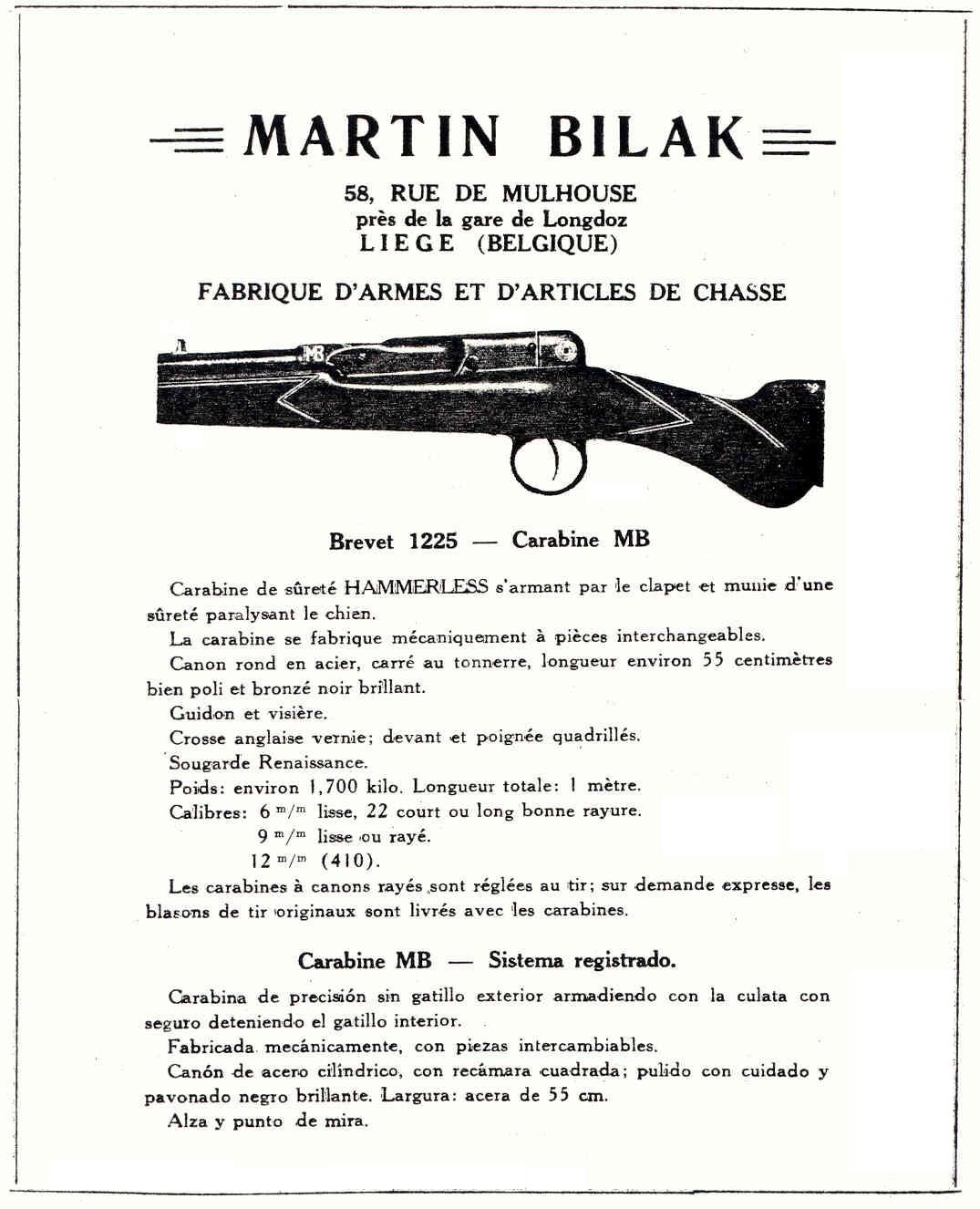
Naturalization
document of Martin BILAK
|
BILAK Martin
Chambre des Représentants SESSION 1955-1956. 15 DÉCEMBRE 1955. COMMISSION DES NATURALISATIONS (1). RAPPORTS SUR DES DEMANDES DE NATURALISATION. … Demande du sieur Martin Bilak. Le sieur Bilak est né à Pleschen (Pologne:), le 3 septembre 1884. Il habite la Belqique depuis le 31 octobre 1907 et réside à Liège. Il a épousé une Belge de naissance. De cette union un enfant est né en Belgique. Le postulant a satisfait aux obligations de la milice envers son pays d'origine. L'impétrant a été reconnu résistant armé en raison de son activité patriotique au cours de la guerre.
P. Diriken, rapporteur. https://www.dekamer.be/digidoc/OCR/K3159/K31591337/K31591337.PDF
Chambre des Représentants Séance du jeudi 26 janvier 1956 SCRUTIN SUR LA PRISE EN CONSIDÉRATION DES DEMANDES DE NATURALISATION. Résultats du scrutin. Naturalisation ordinaire. Feuilleton n° 5. Bilak, Martin, né à Pleschen (Pologne) le 3 septembre 1884 ; il réside à Liège : 173 suffrages. https://www3.dekamer.be/digidocanha/K0054/K00541586/K00541586.PDF
|
Patent 454138 (dated
27 January 1944).
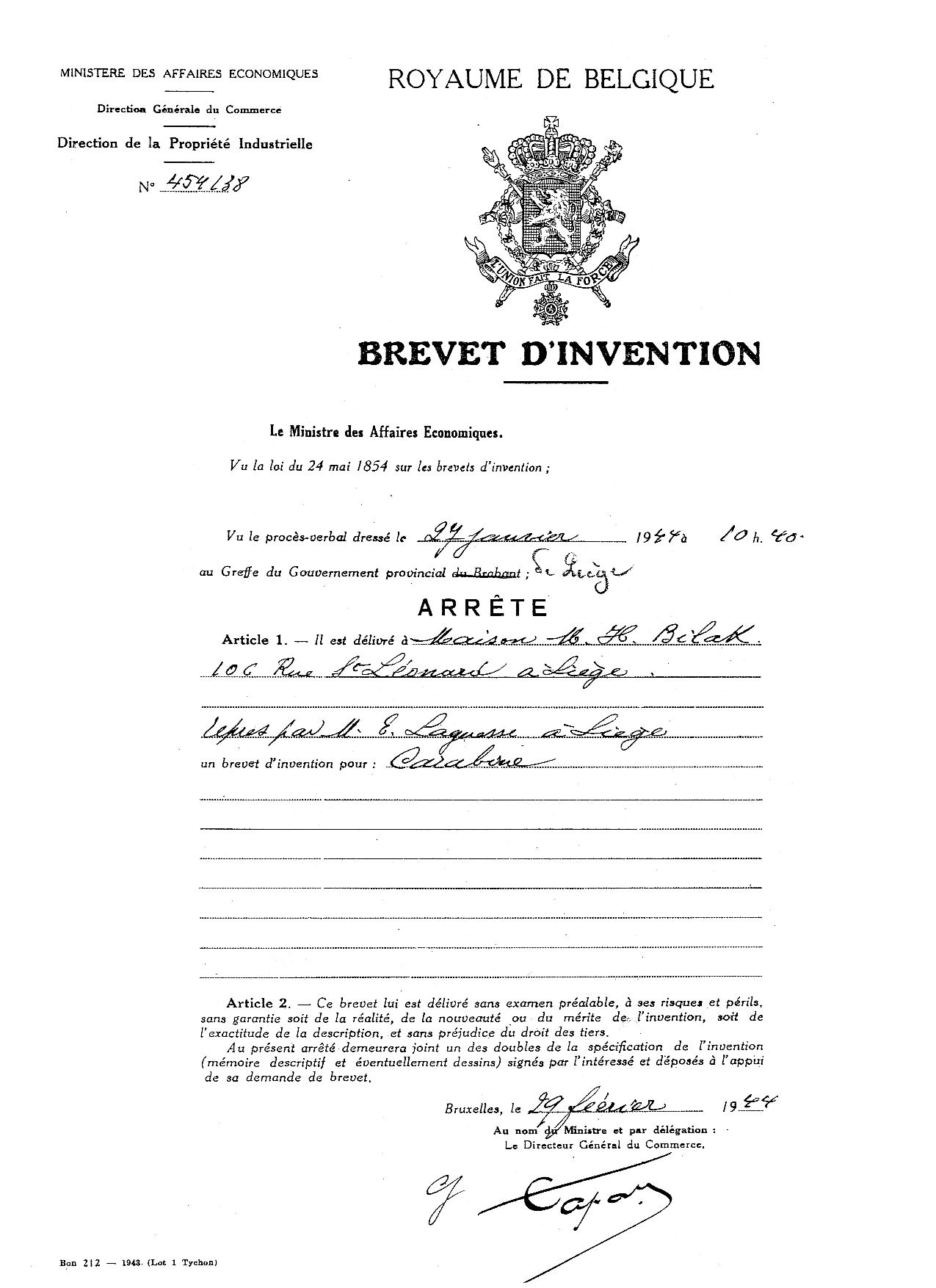
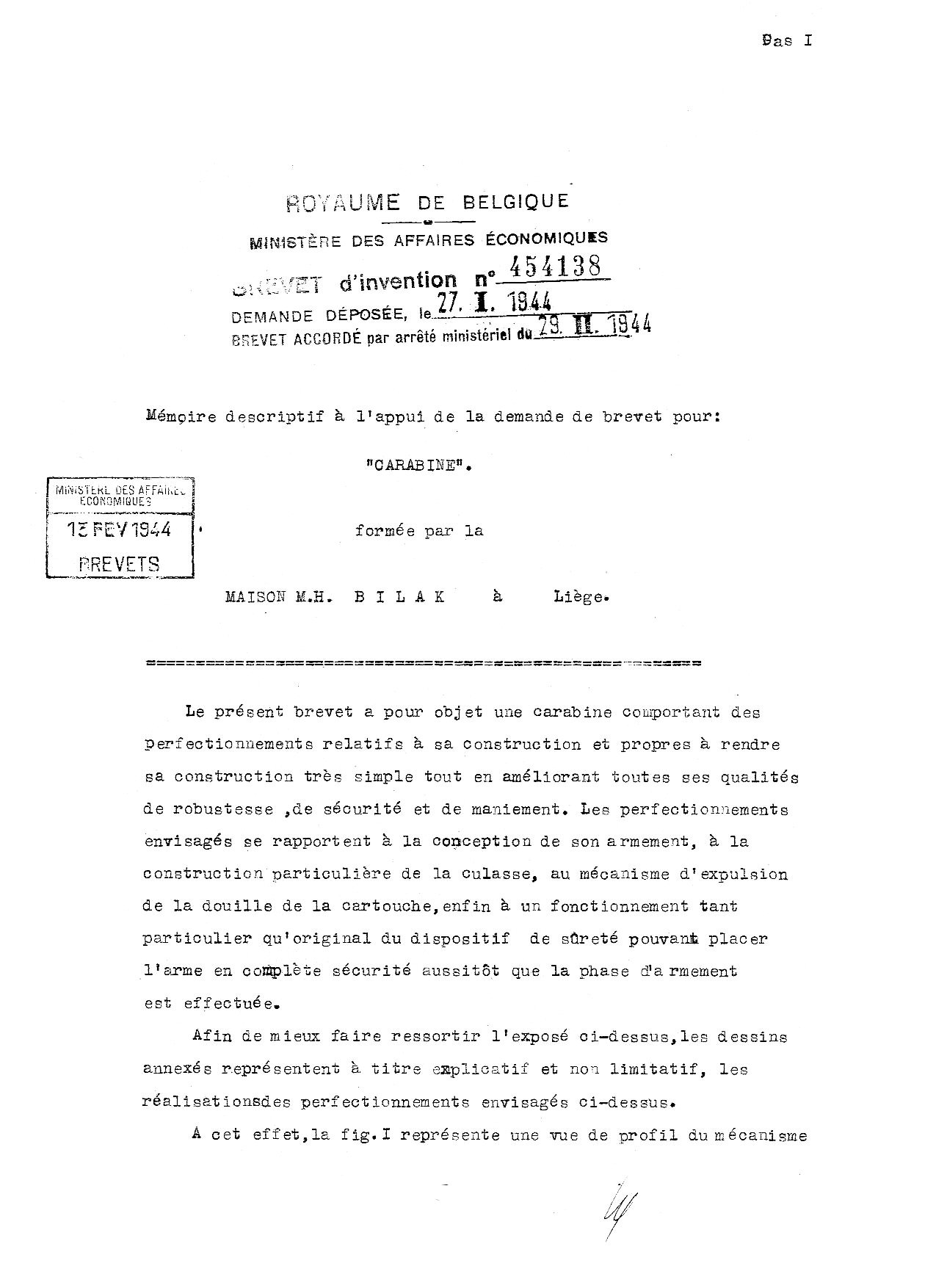
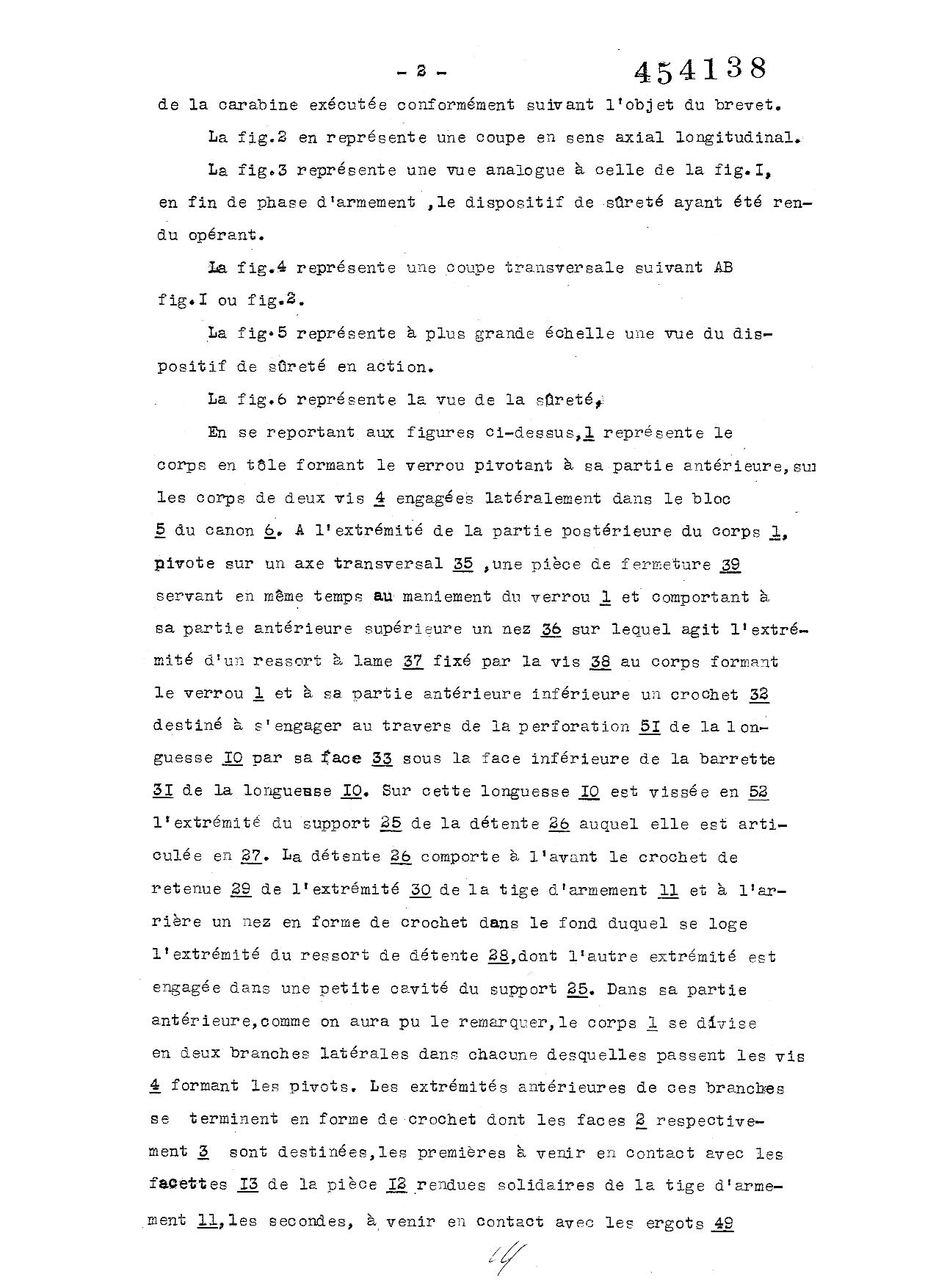
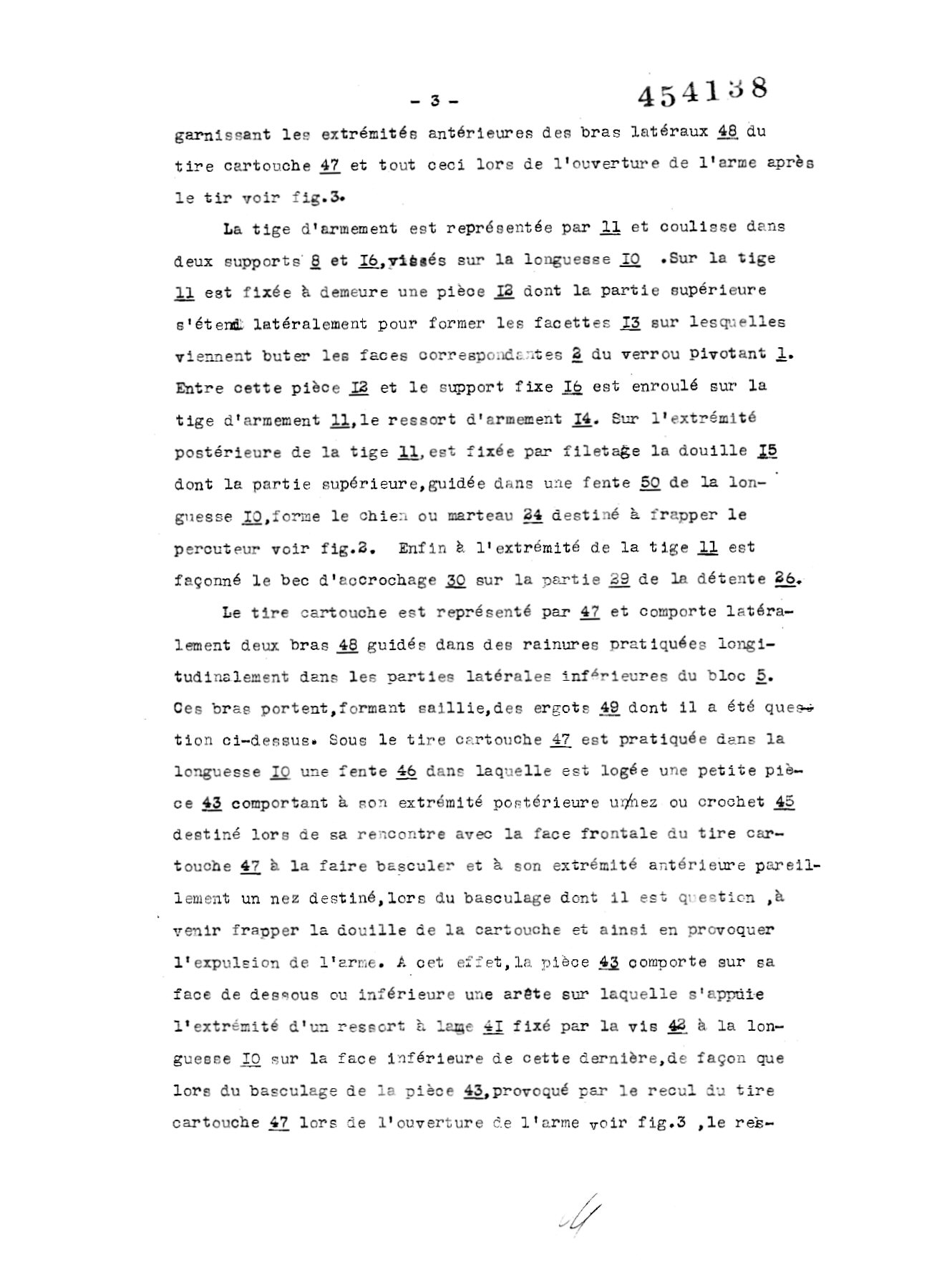
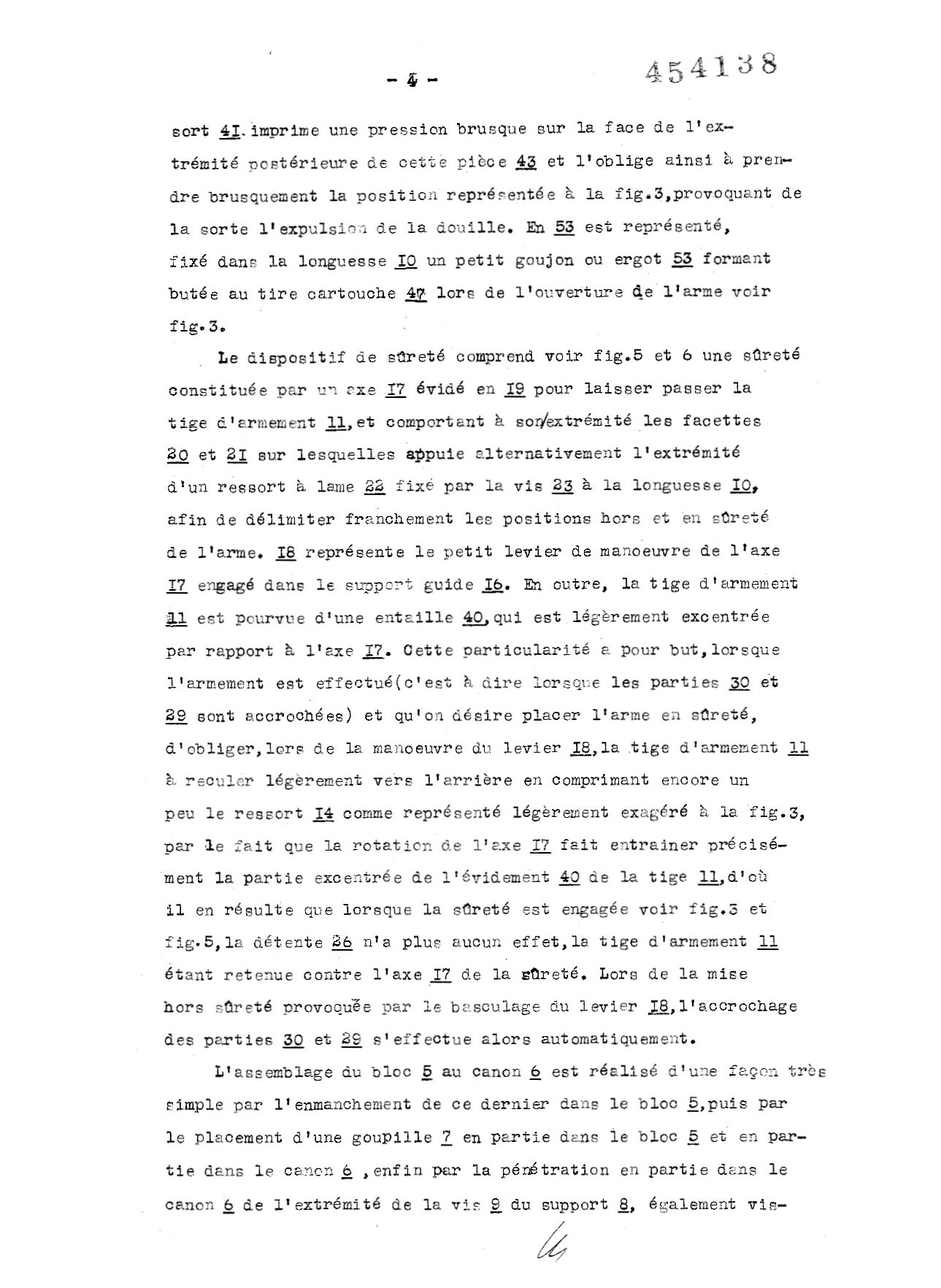
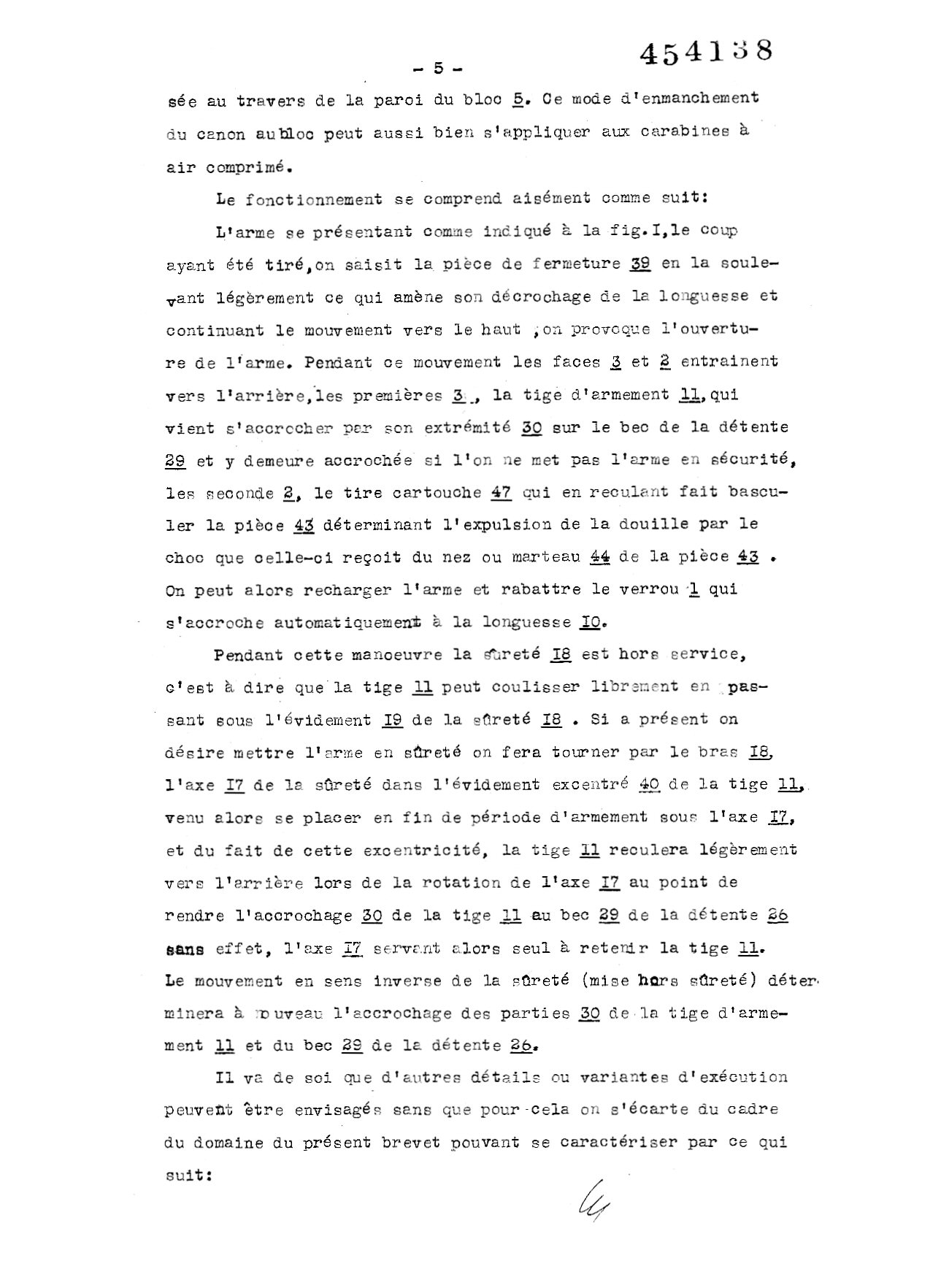
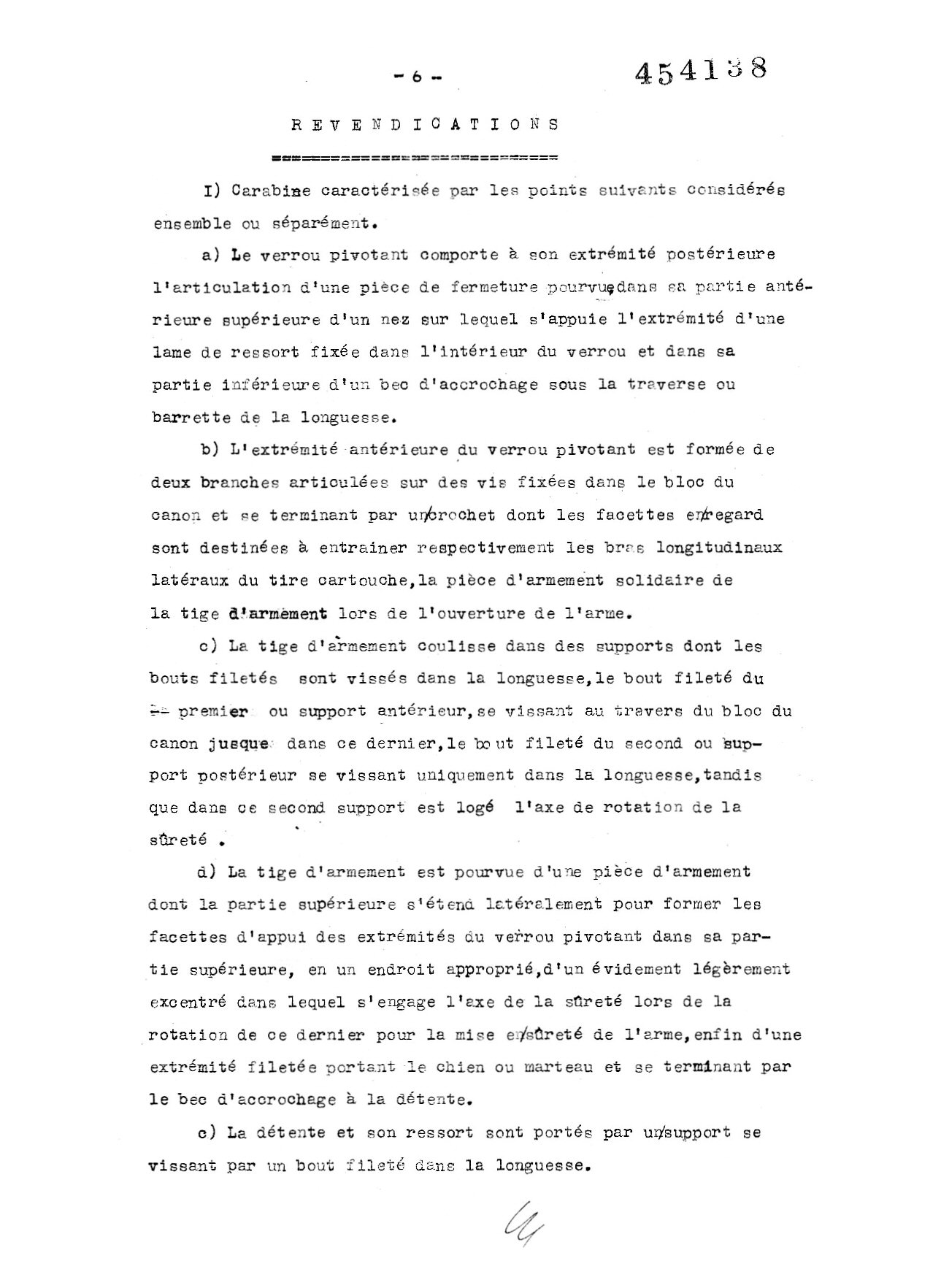
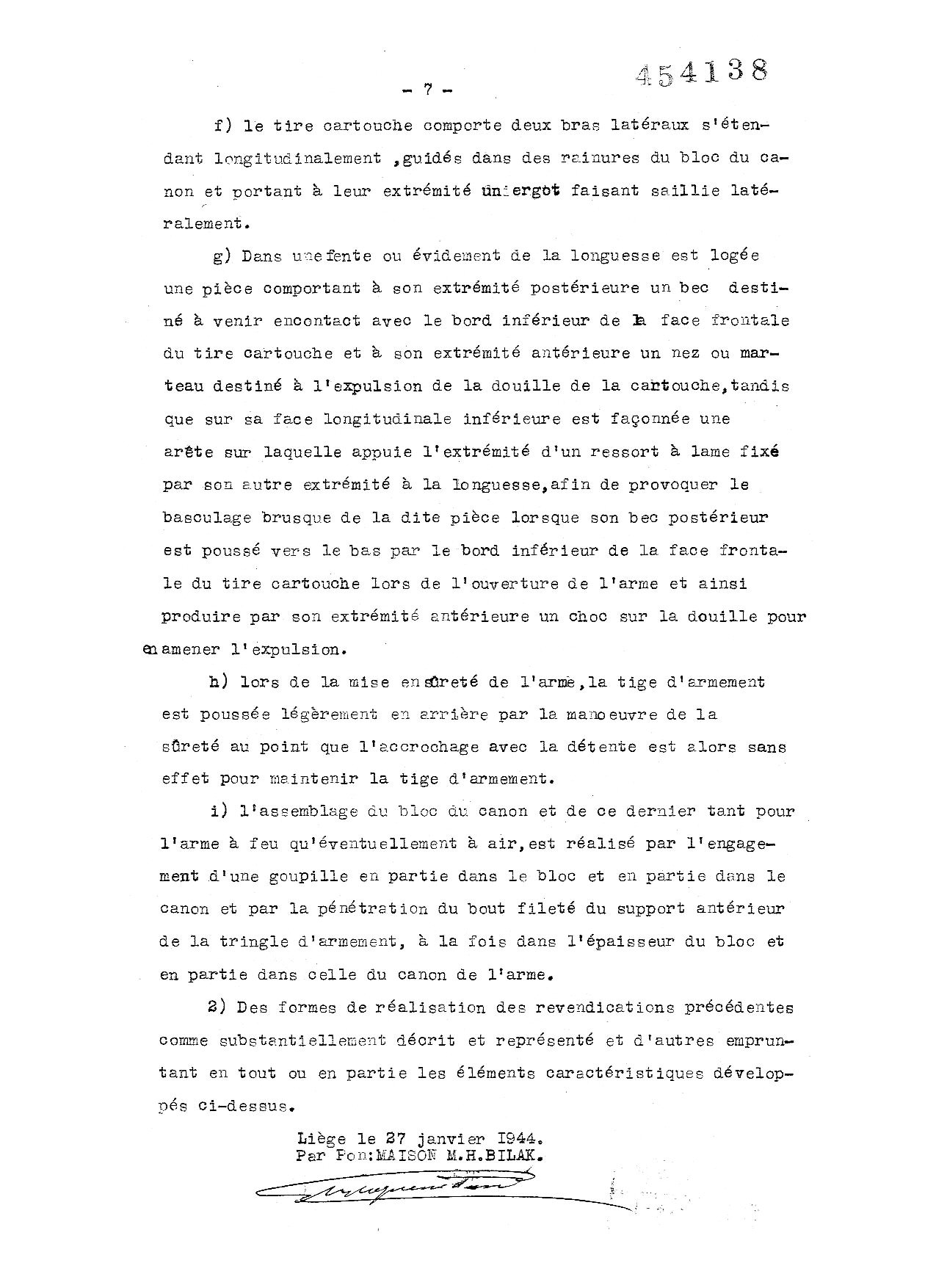
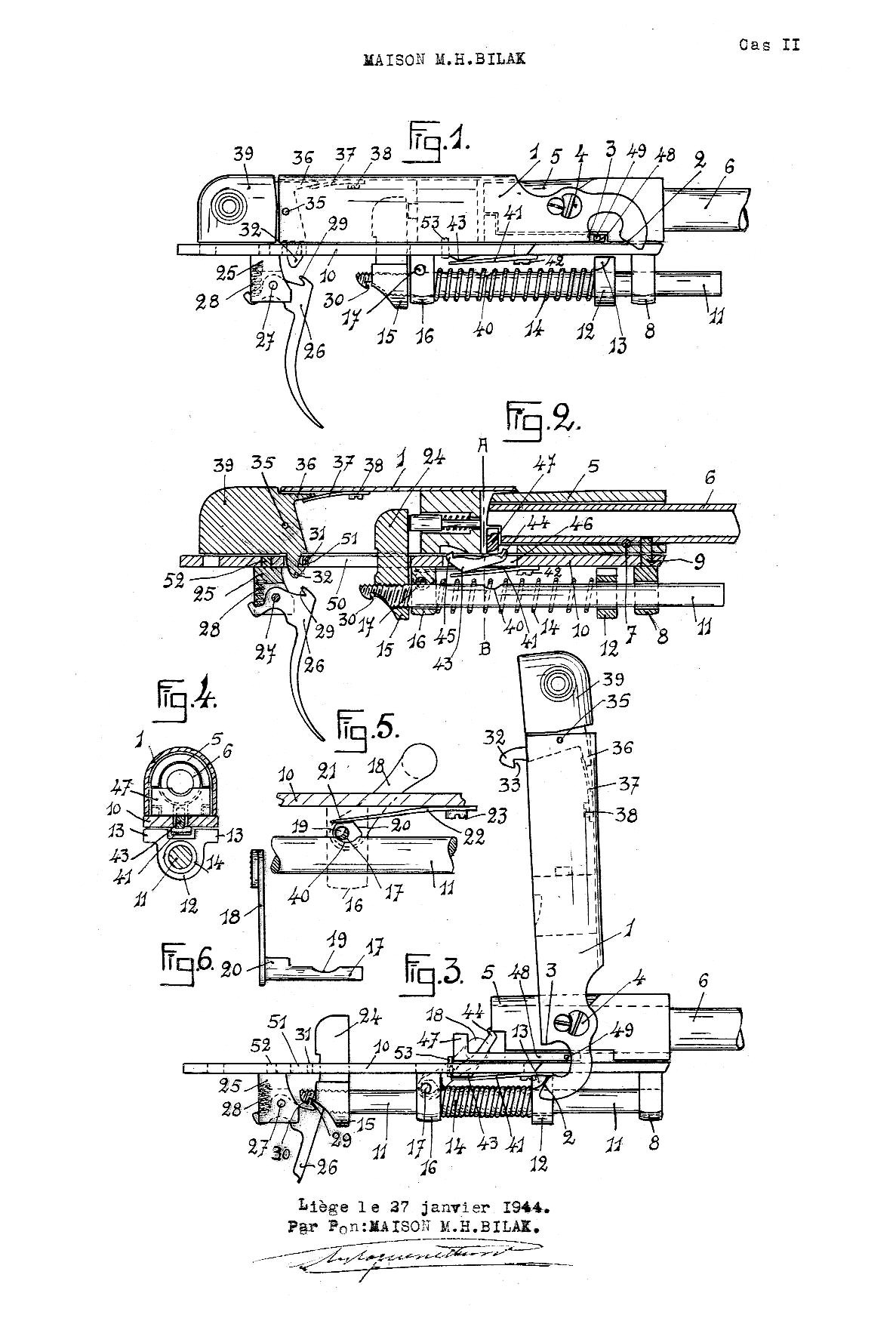
In conclusion, this
nice rifle in 22 short caliber was produced by Martin BILAK, tested in
Liège, and put on the market from 1944.
Chris, HPH, GP, PHL, MD
Identification 3936
Here is a "hammerless"
shotgun with two side-by-side barrels, very classic with its double trigger
and its "top lever" opening system. This example seems to be excellently
preserved and of a high level of finish: deep tanning, finely checkered wood
(walnut?) and engraved metal parts.
Markings:
Number 2417, probably
serial number.
Peron (little step),
on the breech tail, punch of the inspector of the proofhouse (valid from
06.16.1853 to the present day).
PV under a standing
lion, proof with smokeless powder (live powder) since 1898.
1 kg 240, weight of
the barrel capable of firing smokeless powders (smooth barrels).
ELG on star in crowned
oval, mark of the proofhouse after 1893.
Omega caliber (12.70),
nominal caliber and length of the casing since 1924.
Choke 18.4.
EL in cursive letter,
provisional proof since 1853 (rifle barrels).
T under star, control
punches from January 27, 1877.
Underlined lowercase
letter "a": annual letter 1962.
A specific marking
designates the manufacturer, on the barrel: Fabrique nationale d'armes de
guerre Herstal. The site has a lot of information on this entity, see:
https://www.littlegun.be/arme%20belge/fn/a%20a%20fn%20gb.htm
Including the
description of another shotgun of the same origin, see:
https://www.littlegun.be/arme%20belge/fn/a%20fn%20fusil%20chasse%20gb.htm
In conclusion, this shotgun was produced by the
Fabrique nationale d'armes de guerre-Herstal, and tested in Liège in 1962.
Chris
Identification 3939
This is a copy of a Smith & Wesson No. 2 revolver, often nicknamed the "Old
Army Model". The original S&W is well known, see for example:
http://www.littlegun.info/arme%20americaine/smith%20and%20wesson/s%20&%20w%20antique/1%201%202mod%20army%20fr.htm
The S&W firm filed the patent for this revolver in 1855. Chambered in 32
annular caliber, its capacity is 6 shots in single action. It benefits from
a "tip-up" system, that is to say by breaking upwards. Manufactured from
1861 to 1874, it was a weapon much appreciated by officers during the
American Civil War (known as the Secession) as a secondary weapon, and
produced in approximately 77,000 copies. This S&W revolver was also popular
with French officers under Napoleon III.
The success of this handgun, which was rarely matched at the time for its
ease of use and the relative power of its ammunition, led many craftsmen to
produce copies of varying quality, mainly in Belgium and England.
The example examined here is obviously intended for the British market, with
its Birmingham proof marks. However, there is no certain indication that it
was produced in England. For example, a certain Meyers (Belgian, English?)
is known for his copies of this S&W No. 2 model, see:
https://shop.joesalter.com/British-Meyers-Copy-Of-SandW-No-2-Revolver-Engraved
Markings:
London patent No. 39678 (right side frame).
Birmingham proof marks (barrel).
MD under left grip (?).
AS, number 30 (serial number?) and other indecipherable markings under the
right plate.
GD in intertwined cursive under the left plate.
AC in intertwined cursive in an oval under the left plate.
These last two logos are good clues to suspect a Liège origin for this
revolver, or at least for some of its elements. Indeed:
1. The intertwined GD monogram could be that of the Liège craftsman Gilles Decortis, well listed on the site,
see :
https://littlegun.be/collection%20privee/belgique/be%20abcde/a%20be%20decortis%20gilles%20gb.htm
2. The AC logo in cursive in an oval is most likely that of COQUILHAT Aimé. We already find on the site a copy of S&W No. 1 that is attributed to this craftsman,
which reinforces the
credibility of his participation in the manufacture of the revolver examined
here:
https://littlegun.be/arme%20belge/artisans%20identifies%20c/a%20coquilhat%20aime%20gb.htm
In conclusion, this copy of the S&W No. 2 revolver
intended for the British market and tested in Birmingham seems to be of
Liège origin. The idea of a manufacture with the participation of Aimé
Coquilhat and possibly Gilles Decortis is attractive, even convincing. We
can reasonably estimate that the weapon was produced during the 1860s to
1870s.
Chris, PHL, HPH, Alain
Identification 3940
A beautiful
“hammerless” shotgun with two side-by-side barrels, very classic with its
pistol grip, double trigger and “top lever” opening system. This example
seems well preserved and of a respectable level of finish: deep tanning,
finely checkered wood and metal parts engraved with scrolls and floral
motifs. The weapon bears a shield with a monogram (probably BD) on the left
side.
Markings:
Number 3910 (or 3310)
and 36225, probably serial number and assembly aids.
Peron (little step),
on the breech tail, punch of the inspector of the proofhouse of Liège (valid
from 06.16.1853 to the present day).
PV under a standing
lion, proof with smokeless powder (live powder) since 1898.
1 kg 506, weight of
the barrel capable of firing smokeless powders (smooth weapons).
ELG on star in crowned
oval, proof bench after 1893.
Omega caliber (12.70),
nominal caliber and the length of the case since 1924.
Choke 18.3 and 18.4.
EL in cursive,
provisional proof since 1853 (rifle barrels).
M under star, P under
star, control punches from January 27, 1877.
Lowercase letter "g",
annual letter 1928.
Several specific
markings designate the manufacturer:
- on the barrel "Manufacture Liégeoise d'armes à feu".
- ML logos crowned in
oval on several parts of the rifle.
The site has a lot of
information about this manufacturer, see for example:
https://littlegun.be/arme%20belge/artisans%20identifies%20ma/a%20man%20liegeoise%20fusil%20hammerless%20gb.htm
In conclusion, this shotgun was produced by the
Manufacture légeoise d'armes à feu, and tested in Liège in 1928.
Chris, HPH
Identification 3942
Il s’agit d’un petit pistolet de poche en calibre 6,35 mm, doté d’une sûreté et de plaquettes en matière sombre (probablement en ébonite). Le calibre 6,35 (ou .25 ACP), issu des recherches du génial inventeur américain John Moses Browning, fut développé à partir de 1903-1906. Le fonctionnement semi-automatique de la plupart des pistolets utilisant cette munition à percussion centrale ainsi que leur compacité séduisirent rapidement le marché européen de l’arme de poche et firent tomber en désuétude les petits revolvers de poche à broche ou à percussion centrale comme les Bull Dogs.
Une multitude de modèles exploitant le concept et la nouvelle munition furent mis sur le marché durant le premier quart du 20ème siècle, soit par de grandes firmes armurières (Webley, FN, Unique, Clément, Manufrance, Mann, etc.) soit par des artisans de plusieurs nations européennes (Belgique, Angleterre, France, Espagne) qui développèrent chacun leur propres interprétations, améliorations et variantes.
Le pistolet examiné ici porte fièrement sur la carcasse et les plaquettes le patronyme de « Gladiator ». Il s’agit en fait d’une variante uniquement lexicale du pistolet « Melior », auquel il est identique en tous points y compris pour les numéros des brevets marqués sur le côté gauche de la glissière. Selon les informations disponibles sur le site, le pistolet « Melior » serait issu des travaux de l’inventeur H. ROSIER lequel aurait cédé ses droits à la société ROBAR pour la fabrication et la commercialisation, voir :
https://littlegun.be/collection%20privee/belgique/be%20pqrstuvwxyz/a%20be%20robar%20fr.htm
Le fait que les deux modèles sont identiques est confirmé par l’existence d’exemplaires portant le nom de Gladiator sur la carcasse et de Melior sur les plaquettes, voir par exemple :
https://www.tircollection.com/t29760-mes-melior
De très nombreuses informations sur cette lignée de pistolets sont fournies sous le lien suivant :
https://unblinkingeye.com/Guns/RK1920/rk1920.html
Marquages :
Cet exemplaire porte les poinçons du banc d’épreuves liégeois, à savoir :
PV surmonté d’un lion stylisé : épreuve à la poudre sans fumée, en usage de 1898 à 1968.
Y sous étoile : contremarque du contrôleur post 1877.
Feu/sur : indications de la sûreté.
6,35 BR : 6,35 Browning – munition utilisée par l’arme.
76811 : numéro de série.
ELG sur étoile dans un ovale sous couronne (canon) : acceptation définitive post 1893.
Gladiator 6.35 sur la glissière et Gladiator Prima sur les plaquettes.
Brevets 259178 – 265491 Liège Belgium : la société a déposé deux brevets concernant cette arme, le premier le 04.08.1913 (n° 259.178) concernant la platine et le second concernant la glissière le 02.03.1914 conjointement avec TART, Edmond. La fabrication de ces armes n’a réellement débuté qu’à la fin de la grande guerre, l’occupant allemand empêchant toute fabrication d’armes, voir :
https://www.littlegun.be/arme%20belge/artisans%20identifies%20q%20r/a%20robar%20melior%20fr.htm
On peut donc estimer que la période de production de ce pistolet se situe au cours des années 1920.
Anecdote :
Le calibre 6,35 a acquis une certaine notoriété dans l'histoire de France avec l'assassinat de Gaston Calmette, rédacteur en chef du Figaro par madame Caillaux, épouse du ministre de l'Industrie, que le journal avait diffamé. Un journaliste s'exclama à l'époque : il n'y a plus de débat politique, il y a le 6,35 ! Dans l'après-midi du 16 mars 1914, Henriette Caillaux, décidée à défendre la réputation de son mari et la sienne mais épuisée nerveusement après une campagne de presse de trois mois, achète pour 55 francs chez l'armurier de la bourgeoisie Gastinne Rennette un petit Browning modèle 1906. Après un essai au stand de l’armurier, elle se rend au journal et vide son chargeur de 6 munitions sur Calmette qui ne survivra pas à ses blessures. D’une façon qui peut surprendre de nos jours, elle fut acquittée le 28 juillet 1914.
Voir : https://fr.wikipedia.org/wiki/Henriette_Caillaux
Chris, HPH, Alain
Identification 3944
Il s’agit d’un beau pistolet à percussion, présentant deux canons juxtaposés en table, à l’instar du système Garrucha qui viendra plus tard. Cet exemplaire est particulièrement travaillé avec ses parties métalliques gravées, de même que sa poignée en bois foncé. Il est doté de deux queues de détente sous pontet, actionnant respectivement deux chiens extérieurs. Sa calotte représentant une tête de lion est articulée à l’aide d’une charnière, permettant ainsi l’accès à une cavité dans la poignée apte à stocker quelques amorces. Les photos fournies suggèrent une pièce luxueuse et très bien conservée (ou très bien restaurée), disposant encore d’une baguette en bon état.
Curieusement ce pistolet a été éprouvé (ou ré-éprouvé) à la manière d’un fusil, avec les marquages suivants :
Perron, sur la queue de culasse, poinçon de l’inspecteur du
B.E. (valable du
16.06.1853 à nos jours).
EL en cursives, épreuve provisoire depuis 1853 (canons fusils).
ELG en ovale sans couronne donc jusqu'au 11/7/1893.
AC, U et D sous étoile (contrôleurs) post 27/1/1877.
11.8 : Calibre ?
Nombre 5776, numéro de
série.
D’autres marquages sont illisibles sur les photos fournies, notamment ce qui ressemble à deux lettres dans une ellipse (PL, PE ?).
On voit clairement le nombre 1908 marqué sous les canons : il s’agit probablement de l’année de ré-épreuve du pistolet, mais sans certitude.
En conclusion, ce beau pistolet à percussion a été
éprouvé à Liège avant 1893 selon les poinçons de contrôle. Bien entendu son
système à percussion indique que sa fabrication doit être bien antérieure à
cette date (années 1850-1860 ?). Plusieurs marquages sont curieusement
identiques à ceux des fusils, et auraient pu être ajoutés lors d’une
ré-épreuve en 1908. Aucune indication ne permet d’identifier le fabricant de
l’arme.
Chris, HPH
Identification 3948
Il s’agit d’un mousquet à percussion ayant subi les outrages du temps, avec ses parties métalliques piquées et corrodées. Selon les images fournies on peut penser que le canon est lisse, mais le calibre ne peut être déterminé sans information complémentaire. L’arme est conçue pour recevoir une baïonnette, ses dimensions ne sont pas précisées.
On ne dispose que de maigres indications pour tenter une identification. Seul le poinçon d’épreuve de Liège, ici ELG sur étoile en ovale en vigueur du 8 septembre 1846 au 11 juillet 1893, permet de déterminer son origine géographique et une fourchette de date de fabrication.
La crosse est gravée d’un monogramme présentant les initiales VP surmontées d’une couronne. Malgré leurs recherches, les membres de l’équipe n’ont pas trouvé de façon certaine l’origine de cette inscription (fabricant ? propriétaire initial de l’arme ? régiment ou organisation ?). Un marquage VP dans un cercle a été précédemment attribué, sous les plus grandes réserves, à l’armurier Vivario-Plomdeur Nicolas, inscrit au banc d’épreuves de Liège de 1836 à 1863 soit tout à fait dans la période de la présente arme. Il serait cependant plus qu’hasardeux d’attribuer ce mousquet à ce fabricant, faute de preuve quelconque. Voir sur le site :
En conclusion, ce mousquet a été éprouvé à Liège au
milieu du 19ème siècle. Il est néanmoins impossible d’aller plus
loin dans l’identification faute d’informations suffisantes. Les initiales
VP ne peuvent être attribuées de façon certaine dans l’immédiat.
Chris, HPH
Identification 3950
Here is a nice
Lefaucheux-type revolver in 9mm pinfire caliber. It has a copper-colored
engraved frame (in bronze or brass as for weapons intended for the Navy),
and has a cap ring. These characteristics, as well as the precious wood
plates that evoke walnut burl, indicate a weapon of very good quality, even
luxury.
Markings:
ELG on an oval star,
proof house from September 8, 1846 to July 11, 1893.
R (or perhaps K)
crowned, inspector's punch from December 30, 1853 to January 26, 1877.
DP 17 under right
plate. The number 17 could be a serial number.
NV, NJ under left
plate.
M under crown or star,
difficult to read on the photos. Under the crown, it would be a punch of the
controller from January 27, 1877.
G, 5, 7, back of the
cylinder. The G probably comes from the subcontractor who produced the
cylinder.
The manufacturer of
the revolver is not specified in an obvious way, but the initials NV may
correspond to two listed craftsmen:
1) Noël
Verviers-Delvaux. On the images on the site, we find on the safety systems
of the different weapons of this craftsman a NV (crowned) and on a handle
frame a NV similar to our copy.
2) Nicolas
Vivario-Plomdeur who presents a similar weapon (attributed to him) in the
website.
We find the G which is
certainly the signature of the craftsman of the cylinder.
In conclusion, this beautiful Lefaucheux system revolver in 9mm
pinfire caliber was produced in Liège in the 1860s-1870s like most of its
counterparts, and before 1877. The manufacturer of this revolver, perhaps
intended for a sailor given its frame made of a non-oxidizable metal, could
be Nicolas Vivario-Plomdeur, who was registered with the proof house of the
city of Liège from 1836 to 1863 (with 4 patents for inventions from 1859 to
1868). However, a manufacture by Noël Verviers-Delvaux cannot be excluded
because of the initials NV used by this manufacturer on other weapons.
Chris, HPH
Identification 3951
Voici un fusil à silex qui semble relativement complet, avec sa baguette bien présente, et raisonnablement conservé à voir ses parties métalliques légèrement piquées.
Marquages :
ELG sur étoile en ovale, poinçon du banc d’épreuves du 8 septembre 1846 au 11 juillet 1893.
S&D sur la crosse : sans doute le marquage du fabricant d’origine, voir ci-dessous.
GB au-dessus de la contre-platine, peut-être pour Gouvernement Belge (utilisé de 1831 jusque vers 1920) ? Sous réserves…
Nombre 70 : numéro de série ?
Logo représentant une abeille contenant les initiales DL : ce marquage est la propriété de la firme Dresse Laloux et Cie, connue sur le site sous le lien suivant :
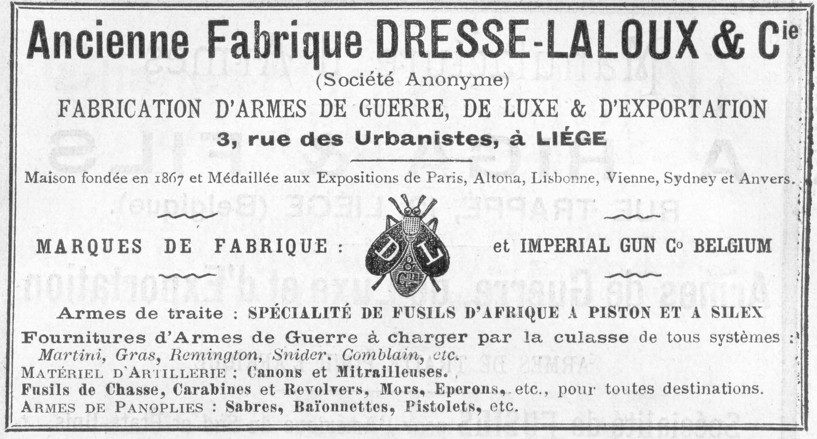
La présence de ce logo de Dresse-Laloux, déposé en 1881, pose question sur une arme de conception clairement antérieure d’un siècle.
Les recherches de plusieurs membres de l’équipe orientent vers une origine prussienne. En effet, les initiales SD pourraient être la signature de la firme Splitgerber & Daum ayant existé sous cette appellation de 1722 à 1779. Il pourrait donc s’agir d’une arme récupérée d’un stock, ré-éprouvée en Belgique avant d’être revendue par Dresse-Laloux dans une région du monde restée utilisatrices d’armes à silex (Afrique ?). Les établissements Georges Laloux ont poursuivi la commercialisation de ces armes totalement obsolètes alors qu'ils étaient déjà installés rue des Urbanistes.
D’autres exemplaires ayant vécu la même situation sont connus, voir par exemple :
Il est cependant impossible de définir avec certitude quelle arme a servi de base, même s’il évoque le fusil d’infanterie modèle 1777. En effet, la comparaison d’un original après recyclage et les modifications apportées par Dresse-Laloux n’est pas pertinente.
En résumé, la seule indication d'une quelconque origine reste le S&D qui laisse entrevoir la piste d'un fusil issu de Potsdam en Prusse... Au cours de 130 années de location, les armes reçoivent les marquages officiels « POTSDAMMAGAZ » et l'aigle prussien ainsi que les initiales des locataires, bien qu'il y ait trois versions en raison du changement de génération : « S&D » pour Splitgerber & Daum ou Daumsche Erben (1722 –1779), « DSE » pour David Splitgerber seel. Erben (1780-1795) et « GS » pour les frères Schickler (1795-1850), voir :
https://fr.wikipedia.org/wiki/Fabrique_royale_prussienne_de_fusils
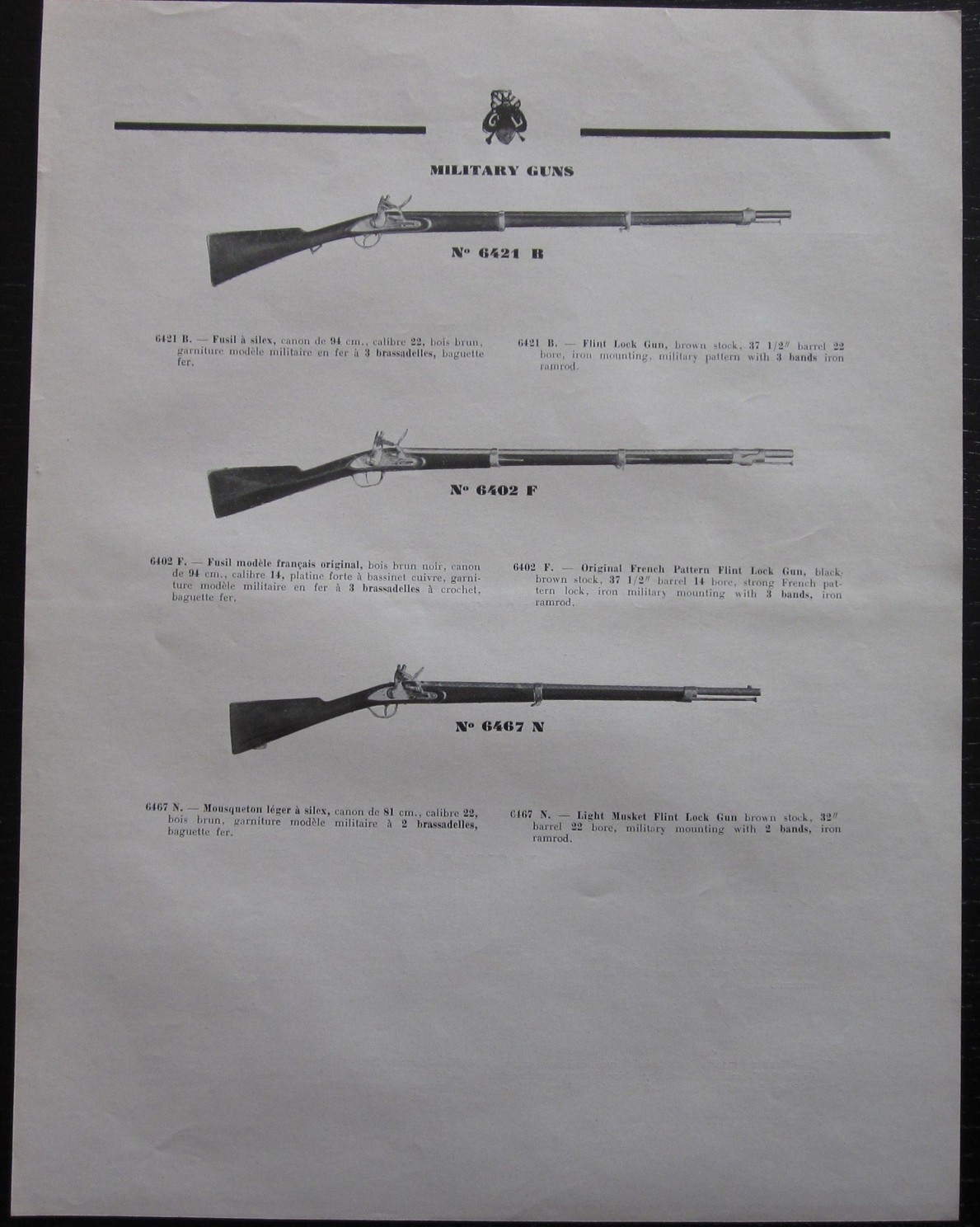
En conclusion, il s'agit probablement d'un fusil
(inspiré du 1777 français) fabriqué originellement en Prusse à Potsdam par
Splitgerber & Daum. Après récupération, il aurait été
reconditionné et ré-éprouvé à Liège par la firme Dresse-Laloux pour une
revente dans une contrée utilisant encore les armes à silex à la fin du 19ème
siècle.
Chris, HPH, PHL, Alain, Alberto
Identification 3952
Voici un beau fusil de chasse à chiens externes, avec clé de brisure « top lever », doté d’un crosse pistolet et de fabrication luxueuse avec ses parties métalliques gravées en rinceaux et ses deux canons juxtaposés en acier damas. Le calibre n’est pas précisé.
Marquages :
Nombre 242 : numéro de série.
Perron : poinçon de l’inspecteur du
B.E. (valable
du 16.06.1853 à nos jours).
T sous étoile : poinçon de contrôle à partir du 27 janvier 1877.
ELG sur étoile en ovale couronné : banc d’épreuve postérieur à 1893.
EL en cursives : épreuve provisoire depuis 1853 (canons fusils).
Choke 17,4 et 18,1.
NON POUR BALLE : canons lisses chokés, en usage de 1878 à 1897.
Un marquage donne un indice sur l’origine de ce fusil :
CH dans un cercle, marquage jusqu'ici attribué à l’armurier Charles Haacken (sous réserves néanmoins), voir sur le site :
https://www.littlegun.be/arme%20belge/artisans%20identifies%20h/a%20haaken%20charles%20fils%20fr.htm
Il s’agit de Charles HAAKEN Fils rue Jonfosse à LIEGE. L’intéressé a débuté en 1859 à la suite de son père Charles HAAKEN-PLOMDEUR, sous la dénomination CH. HAAKEN & CIE. En 1894 jusqu’en 1898, il est devenu CH. HAAKEN Fils avant de céder son entreprise à DEBRUS Louis.
En résumé, ce beau fusil de chasse à la finition
luxueuse a été fabriqué à Liège entre 1893 et 1897 selon l’interprétation
des marquages. Antérieur à 1922, il ne présente pas de lettre annale. Il
provient probablement de la production de Charles Haaken dont la période
d’activité correspond pleinement avec celle de la fabrication de l’arme.
Chris
Identification 3953
Il s’agit d’un fusil de chasse à percussion sur lequel le temps a imposé ses stigmates avec une forte corrosion des parties métalliques. Cependant on peut assumer que cette arme était d’un bon niveau de finition à l’origine, notamment en raison de sa crosse joliment sculptée, des parties quadrillées, et des restes de gravure discernables sur les chiens et la platine.
Le calibre de ses deux canons juxtaposés n’est pas indiqué. Il possède deux queues de détente et deux chiens externes, et a conservé sa baguette.
Marquages :
Nombre 9708, précédé des initiales VC : numéro de série.
ELG sur étoile en ovale, poinçon du banc d’épreuves du 8 septembre 1846 au 11 juillet 1893.
Perron : poinçon de l’inspecteur du
B.E. (valable
du 16.06.1853 à nos jours).
EL en cursives : épreuve provisoire depuis 1853 (canons fusils).
Choke 17,4 et 18,1.
M surmontée d’une couronne : poinçon du
contrôleur du 30 décembre 1853 au 26 janvier 1877.
Un marquage donne une piste solide quant à l’origine de ce fusil : le marquage VC désigne très vraisemblablement l’armurier bien connu Victor Collette, fabricant d’armes quai Saint Léonard, 60 à LIEGE qui fut inscrit au banc d’épreuves liégeois de 1857 à 1861. On sait néanmoins que sa période d’activité fut bien plus longue. Sa production est largement décrite sur le site, voir :
https://littlegun.be/arme%20belge/artisans%20identifies%20c/a%20coltte%20fr.htm
En résumé, cet élégant fusil de chasse a été
fabriqué à Liège entre 1853 et 1877 selon l’interprétation des marquages,
mais plutôt au début de cette fourchette de dates compte-tenu de son système
à percussion.
Antérieur à 1922, il ne présente pas de lettre
annale. Il provient très probablement de la production de Victor Collette
dont la période d’activité correspond pleinement avec celle de la
fabrication de l’arme.
Chris, HPH
Identification 3957
Fusil de chasse à percussion, deux canons juxtaposés, deux chiens externes, déverrouillage par clé sous le pontet. C’est une arme en calibre 16, ce qui est bien souligné par le poinçon correspondant. Comme indiqué par le propriétaire, l’arme porte les poinçons d’épreuve d’Eibar, à savoir l’étoile à 5 branches (épreuve provisoire poudre noire pour les canons à âme lisse) et PC sur croissant sous étoile (test définitif). La fourchette d’utilisation de ces poinçons est effectivement de 1910 et 1921.
Les canons portent la mention : Beristain et Cie à Eibar. Cette raison sociale correspond à une dynastie armurière du Pays Basque espagnol, ayant évolué de la production artisanale d’armes vers la distribution sur catalogue de produits divers, à l’instar de Manufrance. Un petit historique a été rapporté sur internet, dont voici quelques extraits traduits depuis l’espagnol :
« Tomàs Beristain avait un atelier à Eibar et figure sur le registre industriel de l’année 1870 en tant qu’armurier. Manuel Beristain apparaît comme propriétaire d’un atelier sur le registre industriel d’Eibar correspondant aux années 1908 avec 8 ouvriers et 1909 avec 4. En 1910 il passe à la raison sociale de ''Beristain et Cia'' réunissant ses enfants Manuel, Aurelia, et Eugenia Beristain Artamendi ainsi que son beau-frère Dionisio Artamendi Aresti qui a pris la direction de la compagnie. Beristain y Cia est devenue une entreprise commerciale qui, dans son établissement de Barcelone, offrait principalement des armes sportives et divers objets décorés. Dans le catalogue de 1926 elle offre quelques pistolets mais la plupart des produits sont des fusils de chasse avec des modèles économiques à moins de 100 pesetas. Dans le recensement de l’armurerie de 1929, la société figure toujours comme fabricant de pistolets et fusils dans son atelier d’Eibar. On perd sa trace au Banc d’essais d’Eibar en 1936. »
Source : https://www.armas.es/foros/viewtopic.php?t=973353&start=18
Il est aisé de trouver des catalogues ou des publicités de l’entreprise, voir par exemple :
https://www.abebooks.fr/Gran-Fabrica-Armas-Eibar-Guipuzcoa-Beristain/30588351987/bd
https://www.iberlibro.com/paper-collectibles/ANTIGUA-POSTAL-OLD-POST-CARD-BERISTAIN/22779538431/bd
Ces publicités précisent que le siège de la division commerciale était situé à Barcelone, pour une distribution de produits issus d’Eibar et de Tolède.
Chris
Identification 3959
Il s’agit d’un beau pistolet « single shot » d’un haut niveau de finition : plaquettes en ivoire ou en os, belles gravures de motifs floraux, canon octogonal basculant. Son numéro de série est 4493. Ses dimensions et ses organes de visée rudimentaires (mais cependant montés sur queue d’aronde et donc dérivables) ne le destinent pas vraiment au tir de grande précision, mais le classent dans la catégorie habituellement dénommée « pistolets de salon » (ou encore pistolets de jardin, parlor pistols, saloon pistols). Ce sont des armes conçues pour le tir récréatif à distance raisonnable et pour un petit calibre, en général 6 mm Flobert ou .22 court.
Celui-ci est une copie liégeoise du pistolet « single shot » de l’armurier l’anglais William Tranter (1816-1890), dont les armes de ce type portaient la mention : W TRANTER PATENT. Le brevet initial aurait été déposé en 1866 (british patent N° 2113). Plusieurs pistolets de ce type, accompagnés d’un historique, sont décrits sur le site, voir par exemple :
https://littlegun.be/arme%20belge/artisans%20identifies%20l/a%20liegeois%20auguste%20fr.htm
L’exemplaire examiné ici est issu de la production de Jean-Baptiste Rongé Fils, firme bien connue sur le site, voir :
L’extrait de catalogue présenté sur cette page montre d’ailleurs un pistolet très proche de celui-ci, étonnamment qualifié de « système américain » !
L’analyse des poinçons permet de définir une fourchette de dates pour la fabrication du pistolet : entre 26/1/1877 (poinçon contrôleur T surmonté d'une étoile) et 11/7/1893 (ELG dans un ovale NON couronné). Il n’est pas possible d’être plus précis en l’absence d’autres marquages ou poinçons spécifiques.
Chris, HPH
Identification 3960
Ce grand fusil de chasse possède un long canon octogonal, ce qui n’est pas si fréquent pour ce type d’armes. Le fusil se déverrouille grâce à un levier bien dimensionné (ouverture de type Lefaucheux) situé sous la longuesse. La crosse partiellement quadrillée est de type pistolet. C’est une arme sans ostentation, clairement conçue comme un outil dont on attend prioritairement son aptitude à remplir sa fonction.
Marquages :
Chiffre 3, probablement numéro de série et aide au montage.
Perron, poinçon de l’inspecteur du B.E. (valable du 16.06.1853 à nos jours).
ELG sur étoile en ovale couronné, banc d’épreuve postérieur à 1893.
q sous étoile, poinçon de contrôle à partir du 27 janvier 1877.
12 sur C dans losange vertical, calibre, utilisé entre 1898 et 1924.
Le fabricant de l’arme a déposé sa signature sur la platine, il s’agit de l’armurier liégeois Marcel Jamin, voir sur le site :
https://littlegun.be/arme%20belge/artisans%20identifies%20i%20j%20k/a%20jamin%20marcel%20fr.htm
En résumé, ce fusil en calibre 12 provient de la
production de Marcel Jamin à Liège. L’analyse des poinçons indique une
fabrication comprise entre 1898 et 1921 (en effet, l’absence de lettre
annale exclut que l’arme soit postérieure à 1922).
Identification 3968
Voici un beau fusil de chasse à deux canons juxtaposés en calibre 16. La platine est à chiens externes (actionnés par deux détentes), avec une clé top lever et une crosse de type pistolet. Les parties métalliques sont partiellement gravées en rinceaux, la crosse et la longuesse sont finement quadrillées. C’est à l’évidence une arme de qualité supérieure et bien conservée.
Marquages :
Le fusil présente toute la batterie de marquages et poinçons liégeois habituels.
Lettre annale i : 1930.
« Eprouvé aux poudres pyroxylées », bande des canons.
Chiffres et nombres : 7549, plusieurs endroits, numéro de série probablement.
15, 512, aides au montage.
Full Choke, canons.
Lion sur PV : épreuve à la poudre sans fumée, en usage depuis 1898.
CHOKE 16.9 : canon choké, en usage depuis 1924.
ELG sur étoile dans ovale couronné : acceptation, en usage depuis 1893.
1kg498 : poids du canon, en usage depuis 1924.
16-70 dans oméga couché : calibre nominal et longueur de l’étui, en usage depuis 1924.
AE accolés, M et S sous étoile : contremarques de contrôleurs, en usage depuis 1877.
EL en cursives : épreuve provisoire, en usage depuis 1852.
Perron : inspection depuis 1853.
Les canons portent un logo représentant un centaure ainsi que l’inscription « Le Centaure ». Cette marque a été déposée par La Fabrique d’Armes Unies de Liège (FAUL), rue Trappé, 22, inscrite au banc d’épreuves de Liège depuis 1920. Cette entreprise est bien connue et identifiée sur le site, voir :
En résumé, ce fusil de chasse en calibre 16 a été
produit en 1930 par La Fabrique d’Armes Unies de Liège (FAUL).
Chris, HPH
Identification 3969
Voici un exemplaire de pistolet conçu pour le tir récréatif à distance raisonnable. Cette catégorie d’armes à un coup, chambrées pour les munitions Flobert à percussion annulaire, a fait fureur à partir du milieu du 19ème siècle… jusqu’à nos jours puisque les munitions sont toujours produites actuellement. Des quantités immenses de variantes autour de ce design ont été produites, principalement à Liège par une myriade d’artisans, et sont généralement classées dans une famille dite des « pistolets de salon » ou « pistolets de jardin ». Les différents calibres de bosquettes Flobert ont été utilisées pour ces pistolets, celui-ci est chambré pour le 9 mm.
C’est un bel exemplaire, avec sa poignée de style renaissance, son pontet à repose-doigt et son canon octogonal.
Marquages :
Nombre 63, numéro de série, côté gauche canon.
E. Spirlet Bté à Liège, avec un logo représentant les initiales ES sous une couronne (face inférieure du canon arme démontée).
Un autre logo avec les initiales ESP dans un écu tenu par un lion cabré, côté gauche du canon.
Selon ces indications, le pistolet a été fabriqué par Edouard Spirlet, armurier à Liège (1850-1876), qui a déposé une série de brevets dont deux en 1864 se rapportant à des modifications et perfectionnements du système Flobert. Il est mentionné sur le site sous le lien suivant :
https://littlegun.be/collection%20privee/belgique/be%20pqrstuvwxyz/a%20be%20ronge%20spirlet%20fr.htm
On peut y lire le texte suivant (par GP, extraits) :
« Nous sommes donc sur la piste d'un membre de la dynastie Spirlet,
peut-être Edouard, mais s’agit-il d’Edouard tout court, ou d’Edouard Père
(BE 1847/1951) ? … Les deux Edouard Spirlet ont été actifs entre 1850 et
1876.... »
En conclusion, ce pistolet de salon en calibre 9 mm
Flobert est issu de la production d’un armurier liégeois nommé Edouard
Spirlet (avec une incertitude entre deux homonymes). On ne dispose pas de
marquage permettant de dater sa fabrication, mais la conception de l’arme et
la période d’activité des deux fabricants portant ce nom militent pour une
production dans les années 1865-1875.
Chris, HPH, Marcel
Identification 3971
Il s’agit ici d’un revolver réglementaire italien Glisenti modèle 1874/88, dans sa version avec canon de 11 cm, revolver qui sera abandonné l’année suivante par l’adoption du modèle Bodéo 1889. Système Chamelot Delvigne, capacité 6 coups à simple et double action en calibre 10,4mm.
L’arme possède une finition nickelée, ce qui a laissé supposer au propriétaire qu’il était destiné à la Marine. Le revolver a été éprouvé pour la poudre sans fumée en 1928 (poinçons PSF et date).
On trouve le descriptif correspondant à cette arme lors de sa vente sur un site d’enchère spécialisé :
https://www.naturabuy.fr/revolver-reglementaire-Italien-modele-1874-88-marine-item-13250059.html
Cette classe de revolvers réglementaires italiens, dans leur version avec canon long, est bien répertoriée sur le site, sous plusieurs liens :
https://www.littlegun.info/arme%20italienne/ancien%20artisan/a%20glisenti%20fr.htm
https://www.littlegun.be/arme%20belge/artisans%20identifies%20p/a%20pirlot%20freres%20fr.htm
Et pour un historique sur les armes de poing italiennes, on peut consulter :
https://fr.topwar.ru/198925-italjanskie-revolvery-i-pistolety-chuzhoe-svoe-i-osobennoe.html
Le membre de l’équipe spécialiste des armes italiennes apporte les informations suivantes :
1) Le revolver « court » de 1874 a été obtenu (1888) en raccourcissant le canon du modèle de cavalerie de 1874, afin de le rendre plus maniable, en attendant l'adoption en 1889 du modèle « Bodeo ». Il est vrai que peu d'exemplaires ont été fabriqués, mais ils ne sont pas très rares.
2) La marine italienne n'a jamais possédé ni le modèle long ni le modèle court 74 ; elle est passée directement du Lefaucheux 1860 au Mauser 1896/900 Flat size.
3) Le nickelage a été réalisé ultérieurement, en milieu civil, comme en témoigne le fait que le revolver a été frappé au banc d'épreuves de Gardone. Les poinçons sont ceux utilisés depuis 1923 et, sur le cartouche, il semble que l'année 1928 figure probablement. Le numéro de série MY75 correspond aux numéros de série militaires d'origine. Les trois poinçons imprimés sur le côté gauche du cadre recouvrent la marque d'origine du fabricant, vraisemblablement Glisenti-Brescia, ce qui est confirmé par le petit cartouche partie droite de la carcasse montrant les initiales GG sous couronne.
4) L'intérieur du poinçon de Gardone n'a jamais changé, mais entre 1920 et 1943, le banc d'épreuves de Brescia était également en activité, avec un lion dressé à l'intérieur du poinçon d'identification.
5) Du modèle 1874, 6 000 exemplaires ont été produits par Pirlot, 19 000 par Glisenti et 4 500 par Regia Fa. Armi.
Chris, Alberto, HPH
Identification 3972
Ce fusil muni de sa baïonnette et d’une hausse graduée (voir chiffres 5,4,3) est à l’évidence un montage réalisé à partir d’un fusil à silex sur lequel ont été adaptés un canon et une culasse pour des munitions à cartouche métallique. Le propriétaire de l’arme indique :
« Ce fusil a été monté en Belgique avec une monture française de 1777
an IX et un canon Enfield .577 Snider. Il a dû être attribué à un soldat de
l'armée du Nord durant la guerre franco-prussienne… fusil qui
semblerait être un système SAMAIN ».
On trouve des informations précises sur ce système sur un site spécialisé dont nous reproduisons le texte ci-dessous :
Source : http://www.armeetpassion.com/samain.html
« Le fusil Samain provient de la transformation d'anciens fusils à
silex. Sur ces armes, on a retiré la platine et la contre-platine avant de
boucher par un placage de bois les encastrements de la monture. Le canon,
lisse ou rayé est conservé avec ses garnitures. Il est coupé au niveau de la
chambre et reçoit la culasse dessinée par Pierre Samain. Grâce à son système
qui permet dans un même mouvement d'ouvrir la culasse et d'armer le
mécanisme de percussion, le Samain est supérieur au Mle
1866 et au Mle
1867. La qualité d'exécution était hélas moins bonne que
celle des armes réglementaires, le canon qui était souvent trop mince pour
être rayé ne permettait pas de profiter pleinement de la hausse du type 1867
qui y était brasé. Les garnitures sont en fer mais certaines armes ont été
montées avec des pièces en laiton.
Fabricant : essentiellement les ateliers de la Buire à Lyon. »
Les essais eurent lieu en octobre 1870. On estime à 80 000 le nombre de fusils de tous types transformés, mais ils ne furent pas utilisés au combat durant la guerre de 1870.
Marquages :
Perron : poinçon de l’inspecteur du
B.E. (valable du 16.06.1853 à
nos jours).
ELG sur étoile en ovale : banc d’épreuve du 8 septembre 1846 au 11 juillet 1893.
z sous étoile : poinçon de contrôle à partir du 27 janvier 1877.
EL en cursives : épreuve provisoire depuis 1853 (canons fusils).
J dans un cercle, LL dans un cercle, SV, N : marquages non identifiés.
« NORD » dans un ovale (crosse).
14.5 sur le canon : sans doute calibre en mm, ce qui est cohérent avec le calibre .577 Snider (0.577x25 = 14.42).
Il est cependant très difficile de dire si c'est bien un fusil résultant du système de transformation Samain. Plusieurs éléments ne vont pas dans ce sens :
1.
Ce fusil a été monté et éprouvé en Belgique.
2.
Il est chambré en .577 Snider et non pour les
cartouches Gevelot réglementaires.
3.
Le poinçon de contrôle est postérieur à la guerre
de 1870.
En conclusion, ce fusil monté en Belgique à partir
de pièces disparates appartient à une catégorie assez répandue d’armes dites
« de nécessité » fabriquées par de très nombreux artisans pour pallier le
manque d’armes réglementaires, notamment durant la guerre de 1870. L’arme a
été éprouvée entre 1877 et 1893.
Chris, HPH
Identification 3974
Voici un exemplaire d’un légendaire et célébrissime revolver issu de l’imagination du Colonel Le Mat. Cette arme, sous diverses variantes, est connue pour avoir équipé des officiers confédérés lors de la Guerre Civile Américaine. Imposant et massif, le revolver Le Mat est néanmoins pourvu d’une certaine élégance, voire de charme, qui lui vaut une réputation internationale auprès des passionnés. Sa particularité est liée à ses deux canons, l’un réservé à aux 9 munitions garnissant la couronne externe du barillet, l’autre, central, qui est également l'axe du barillet, étant destiné à une charge de chevrotines (ou de gravier ou déchets de métal). Il ne peut d'ailleurs être chargé que par la bouche, tout comme les chambres du barillet (à percussion à l'époque).
Un autre problème des premières séries était le calibre, qui ne correspondait pas aux .36 et .44 de l'armée. Les utilisateurs devaient donc couler leurs balles eux-mêmes. Plus tard, Alexandre Le Mat (aidé du flamboyant colonel confédéré Pierre Gustave Toutant Beauregard) a remédié à ce problème et a ramené le gros calibre 18 du canon central au calibre 28, plus adapté.
La genèse, l’histoire et les variantes du revolver Le Mat sont pleinement explicitées sur le site par l’expert du groupe spécialiste des armes américaines, et il ne semble pas utile de paraphraser les études exhaustives qu’il a publiées sur le sujet, le lecteur est invité à visiter :
D’autres modèles et variantes sont également présentés sur le site, voir :
https://www.littlegun.info/arme%20francaise/artisans%20k%20l/a%20lemat%20fr.htm
Pour son passé riche d’histoire, sa rareté et son allure disons… respectable, pour ne pas dire redoutable, le revolver Le Mat est devenu un objet particulièrement désirable sur le marché de la collection.
Cet exemplaire à percussion est décoré de gravures sur le barillet (motifs floraux). Il ne présente (selon les photos soumises) que des numéros de série et de montage, à savoir 47 sur toutes les pièces et 10877 sur la carcasse, ainsi que la mention « Col. LeMat. » sur le canon. Faute de données supplémentaires, il est impossible de déterminer l’identité de son fabricant ni sa date exacte de production. On notera cependant qu’un exemplaire identique et portant la même gravure sur le canon est visible dans l’étude publiée sur le site. Avec l’analyse suivante : « Cette arme est signée "Col Le Mat" (sans les lettres S.G.D.G) dans une bannière sur le canon, du même style que les autres marquages de la production française… Le n° de série est le 687. Tout comme le propriétaire, je pense que l'arme fait partie du lot fabriqué en France. L'absence des lettres S.G.D.G pourrait suggérer qu'elle a été fabriquée après que Le Mat ait obtenu les documents de patente définitifs, ce qui rend ces quatre lettres superflues. D'autre part, le n° de série s'insère parfaitement dans un lot de +/- 2.500 pièces. »
Anecdotes : le Revolver Le Mat dans la Culture Populaire :
Grâce à son aspect « viril » et musclé, ce revolver intervient dans plusieurs films, séries télévisées et jeux-vidéo. On citera notamment son apparition dans l’excellente série d’anticipation « Westworld » de Jonathan Nolan et Lisa Joy, où il accompagne le remarquable acteur Ed Harris tout au long des épisodes. Pour mémoire, cette série futuriste est un hommage au film éponyme où Yul Brynner creva l’écran dans le rôle d’un androïde peu conciliant avec les humains (réalisateur : Michael Crichton, 1973).
Pour les Geeks, jeunes ou moins jeunes, il est l’une des armes fétiches des jeux-vidéo « Dead Red Redemption » et « Call of Duty », entre autres.
Pour répondre à la demande des passionnés face à la rareté et au prix des modèles authentiques, la firme italienne Pietta en a produit une réplique à poudre noire, très recherchée, et l’espagnole Denix une réplique inerte bon marché.
Chris, Marcel, HPH
Identification 3975
Voici un fusil de chasse du plus haut standing témoignant du remarquable niveau de qualité atteint par son fabricant. Avec ses deux canons juxtaposés en acier damas, ses superbes gravures représentant divers gibiers, son pontet à volute et ses deux chiens travaillés, ce fusil impressionne par un luxe ostentatoire. Il dispose de son coffret muni de tous ses accessoires, l’ensemble (fusil, coffret et accessoires) étant dans un parfait état de conservation.
Marquages :
Nombre 26554, numéro de série.
ELG sur étoile en ovale, poinçon du banc d’épreuves du 8 septembre 1846 au 11 juillet 1893.
Perron : poinçon de l’inspecteur du
B.E. (valable
du 16.06.1853 à nos jours).
EL en cursives : épreuve provisoire depuis 1853 (canons fusils).
Choke 17,6.
Y surmonté d’une couronne : poinçon du
contrôleur du 30 décembre 1853 au 26 janvier 1877.
Deux marquages donnent des indications sur
l’origine de l’arme :
1.
C. Dandoy
à Liège (platine)
2.
Armand
Bté (sous les canons)
Ces deux signatures évoquent une collaboration franco-belge. Le fabricant serait alors le liégeois Charles Dandoy, répertorié sur le site sous le lien suivant :
https://www.littlegun.be/arme%20belge/artisans%20identifies%20d/a%20dandoy%20fr.htm
NB : En annexe figure une mise au point sur l’identité de cet artisan.
Le nom d’Armand peut correspondre à la maison « Armand à Paris », également connue sur le site et ayant produit de beaux fusils de chasse, voir :
https://www.littlegun.info/arme%20francaise/artisans%20a%20b/a%20armand%20fr.htm
En résumé, ce superbe fusil de chasse a été produit
à Liège entre 1853 et 1877 selon l’analyse des poinçons. Il est issu des
ateliers de Charles Dandoy, avec la complicité probable de la maison Armand
à Paris, ou pour le moins l’utilisation d’une invention de cette entreprise.
Chris, HPH
Annexe :
L’initiale C précédant le nom de Dandoy sur de nombreuses productions a souvent été attribuée au prénom « Célestin ». Une étude fouillée d’un des membres de l’équipe (HPH) a démontré qu’il s’agissait d’une confusion et qu’elle correspond en fait au prénom « Charles ». On ne trouve aucune trace d’un Célestin Dandoy dans la littérature et les ouvrages de référence (Jarlier, article de C. Gaier dans la revue du MAL, Qui est qui, etc…).
Dès 1851, Charles DANDOY travaille en association avec les armuriers MAILLARD et LUCQ pour importer des revolvers ADAMS. Il fabrique ensuite cette arme sous licence et des copies également sous licence du revolver BEAUMONT-ADAMS. Cette arme de construction solide porte la marque CD de l’armurier. Il est inscrit au banc d’épreuve liégeois de 1846 à 1865 puis de 1865 à 1867 sous la dénomination C. DANDOY & Cie.
Identification 3977
Ce beau fusil de chasse à chiens internes (hammerless) à deux canons juxtaposés et clé d’ouverture « top lever » semble être une pièce de bon standing. Avec ses platines joliment gravées de représentations de gibiers et motifs floraux, sa crosse et sa longuesse en bois de qualité (selon les photos fournies), il présente une belle allure générale.
Cependant, l’analyse des poinçons soulève de nombreuses questions sur son origine réelle, voir la discussion plus loin.
Marquages :
NPE
3946.24
Logo évoquant la silhouette d’un fusil d’assaut
LPJF (sous réserve) sous la longuesse
Choke 16.2 et 16.8
16.4 et 16.2
11979.17. Remarque : le dernier chiffre 9 semble frappé postérieurement aux autres et évoque plutôt une lettre g !
Initiales LC dans un cercle couronné
10573, bande des canons
A. Kruppscher Gewehrlauf Stahl, canons (gewehrlauf = canon de fusil ; stahl = acier) = fabricant des canons.
Commentaires :
Ce beau fusil pose question(s) quant à son origine, ses marquages, son lieu et son époque de fabrication. Les éléments troublants et sources de confusion sont rassemblés ci-dessous :
1.
Le marquage NPE est à l'évidence très proche des classiques poinçons
d'épreuve autrichiens NPV et NPF, le V signifiant Vienne et le F signifiant
Ferlach. Si on suit cette logique, cela signifierait que l'Autriche aurait
disposé d'un banc d'épreuve dans une ville dont le nom débute par un E.
Aucune source ne permet de le penser. De plus, les proportions et la frappe
des lettres N et P sont légèrement différentes de celles des poinçons
autrichiens authentiques.
2.
En Autriche, 3946.24 veut dire qu'il s'agit du no. 3946 des épreuves de
l'année 1924. L'autre marquage sur les canons date donc de 1917. L’arme
aurait donc été reconstituée à partir d’éléments ayant été éprouvés
respectivement en 1917 et 1924. Bien qu’inhabituelle, cette situation est
possible. En revanche une anomalie réside en la frappe du dernier 9 sur le
canon qui ressemble beaucoup plus à la lettre g. Cette curieuse anomalie
interroge sur l’authenticité de l’épreuve…
En conclusion, l’observation de ce fusil de chasse
pose davantage de questions qu’elle n’apporte de réponses. C’est
incontestablement une belle arme, qui semble avoir été construite à partir
l’éléments distincts : un ensemble-canons en acier Kruppscher éprouvé en
1917 (peut-être… car le doute subsiste en raison de la frappe d’un g au lieu
d’un 9), et le reste ayant été éprouvé en 1924… Tout ceci si l’on admet que
l’épreuve ait été réalisée en Autriche, ce qui est loin d’être certain à
cause du marquage NPE suspect ! Les autres marquages (LPJF, LC dans un
cercle couronné) n’ont pas pu être attribués. Par ailleurs rien n’indique
son origine géographique, il n’y a par exemple aucun marquage liégeois.
Chris, HPH, GP, Alberto, Alain
Avec nos remerciements au Dr. Dirk Ziesing pour ses précieux éclaircissements
Identification 3980
Voici un fusil de chasse « hammerless » à deux canons juxtaposés, très classique avec sa double détente et son système d’ouverture par clé de brisure « top lever », disposant d’un poussoir de sûreté. C’est à l’évidence un bel exemplaire entièrement enjolivé de fines gravures en rinceaux.
Les marquages montrent qu’il s’agit bien évidemment de la production de Lebeau-Courally, célèbre firme bien documentée sur le site, voir :
https://www.littlegun.be/arme%20belge/artisans%20identifies%20l/a%20lebeau%20courally%20fr.htm
Marquages :
Perron, poinçon de l’inspecteur du B.E. (valable du 16.06.1853 à nos jours).
ELG sur étoile en ovale couronné, banc d’épreuve postérieur à 1893.
V sous étoile, poinçon de contrôle à partir du 27 janvier 1877.
20 sur C dans losange vertical, calibre, utilisé entre 1898 et 1924.
EL en cursives : épreuve provisoire depuis 1853 (canons fusils).
Choke 15.3 et 15.2.
PV sous lion dressé, épreuve à la poudre sans fumée (poudre vive) depuis 1898.
1 kg 108, poids du canon pouvant tirer des poudres sans fumée (armes lisses).
5180 sous les canons.
Acier comprimé DE WAHLREYNE (à l'étain) marque d'origine, indique le type d'acier ayant servi à la fabrication des canons.
Aug. Lebeau Fabt à Liège.
EJECT. COURALLY 1163 BREVETÉ.
FABT DES COURS IMPLES DE RUSSIE ET D’ALLEMAGNE, arguments publicitaires antérieurs à 1914.
Le numéro de série 36503 renvoie à la fourchette suivante : numéros 35493 à 37872 de 1907 à 1910.
La marque de fabrique frappée entre les deux percuteurs a été déposée le 4 février 1902.
L’absence de lettre annale indique une fabrication antérieure à 1922.
En résumé, ce beau fusil de chasse juxtaposé, issu
de la production de la prestigieuse firme Lebeau-Courally, a été fabriqué
entre 1907 et 1910. Cette fourchette est compatible avec l’ensemble des
marquages disponibles et est attestée par le numéro de série.
Chris, HPH, PHL
Identification 3988
This is a small .22
caliber rifle reminiscent of a FN model, to which it is quite closely
related. Note that the stock was modified by a previous owner. It is a
simple weapon, with basic sights, intended for recreational shooting and the
eradication of small pests.
Markings:
11226: A serial
number, but for the weapon or just the barrel?
R crowned:
Verification mark since 1897 for shotguns and rifles above 8 mm – since 1924
for all rifled barrels.
C under star:
Inspection mark from January 27, 1877.
Perron: Mark of the
inspector of the B.E. valid from June 16, 1853 to the present day.
22L: Indication of the
caliber: .22 long.
ELG on a star in a
crowned oval: proof house after 1893.
In addition to these
classic Liège hallmarks, there are two specific markings:
Initials LLH:
signature of the firm of Laurent Lochet Habran, well known on the site, see:
https://littlegun.be/arme%20belge/artisans%20identifies%20l/a%20lochet%20habran%20laurent%20gb.htm
This artisan was a
manufacturer of weapons and rifle barrels in Jupille-les-Liège, having filed
patents from 1884 to 1897. This company apparently operated under several
names until the 1950s. Many weapons from various craftsmen have benefited
from his rifle or carbine barrels. There is no indication to date that
Laurent Lochet Habran's firm produced complete weapons. More enigmatic is
the mention -MELIOR-MADE IN BELGIUM- stamped on the top of the barrel. The
name Melior (an adjective meaning "best" in Latin) is associated with the
small semi-automatic pistols produced by the Robar firm. These weapons,
produced from the early 20th century to the 1970s, are described on the
website via the following links:
https://littlegun.be/collection%20privee/belgique/be%20pqrstuvwxyz/a%20be%20robar%20gb.htm
https://littlegun.be/arme%20belge/artisans%20identifies%20q%20r/a%20robar%20melior%20gb.htm
https://littlegun.be/arme%20belge/artisans%20identifies%20q%20r/a%20robar%20gb.htm
Nevertheless, it seems
unlikely that the rifle examined here was produced by the Robar company. In
any case, there is no evidence to support this claim.
In summary, this small
.22 long caliber rifle was proof-marked in Liège beginning in 1924 according
to the crowned R hallmark. The barrel manufacturer is undoubtedly the firm
of Laurent Lochet Habran (LLH), which may be the author of the entire
weapon, although this cannot be verified. The Melior name on the weapon
cannot reasonably be attributed to the Robar firm, given the current state
of knowledge.
Chris, HPH,
Alain
Identification 3990
Cette
carabine de petit calibre au système Warnant est dans un état qui la
rapproche de l’épave. En particulier ses parties métalliques fortement
corrodées compliquent l’identification en rendant certains marquages
spécifiques pratiquement indéchiffrables. On distingue néanmoins des restes
de gravure sur la culasse.
Marquages :
Chiffre 3,
nombre 96 : numéros de série, aides au montage ?
FL.22.C :
indication du calibre 22 court Flobert.
Y sous
étoile : poinçons du contrôleur, à partir du 27 janvier 1877.
Perron : poinçon de l’inspecteur du
B.E.
valable du
16.06.1853 à nos jours.
Ovale ELG
couronné, très effacé : banc d’épreuve postérieur à 1893.
5.3 : rappel
du calibre, cette fois en mm ?
Initiales NB,
peut-être celles d’un fabricant non identifié à ce jour.
On trouve sur
le site d’autres exemples de carabines de salon conçues avec le système
Warnant, voir par exemple :
https://www.littlegun.be/arme%20belge/artisans%20identifies%20t%20w/a%20warnant%20rene%20fr.htm
Le marquage
le plus spécifique qui aurait pu orienter l’identification se présente sous
forme d’un logo dans un ovale couché. L’état de la surface métallique le
rend malheureusement illisible.
En conclusion,
il s’agit d’une carabine de salon en calibre .22 court, dotée du système
Warnant, et éprouvée à Liège postérieurement à 1893. Dans l’impossibilité
actuelle de déchiffrer le logo porté par l’arme, il est impossible d’être
plus complet.
Chris,
Alain, HPH
Identification 3994
Voici un
revolver au système « top break ». Ce concept novateur pour l’époque est dû
à la firme Smith & Wesson au début des années 1870 et a constitué un progrès
majeur pour le chargement puis le déchargement simultané des étuis vides.
Les S&W « top
break » sont très bien documentés, on trouvera par exemple une étude en
français sous le lien suivant :
https://www.armes-ufa.com/spip.php?article2113
Pour
plusieurs exemples de ces revolvers sur le site, voir :
Ces
excellents revolvers américains furent bien entendu copiés et interprétés
par les concurrents européens, principalement en Espagne (Eibar) et en
Belgique à Liège. L’objet examiné ici en est un exemple. Malgré son état de
surface piqué et corrodé, on devine que l’arme a été fabriquée avec un bon
niveau de finition, voire de luxe : barillet de 5 chambres munies de
drageoirs, anneau de calotte, carcasse et barillet gravés, plaquettes en
nacre.
Fonctionnant
en simple et double action, il serait chambré en calibre 7,65 selon son
propriétaire… Ce qui semble pour le moins invraisemblable puisque le 7.65
est une munition conçue pour les pistolets semi-automatiques et que son
chargement à la poudre sans fumée ne donnerait guère de chances de survie à
ce revolver, sans parler des risques pris par l’utilisateur… Il ne peut
s’agir que d’un calibre 32 ou 320 poudre noire, ce qui correspond à 8 mm.
Marquages :
5736 :
probablement numéro de série.
B sous
étoile : poinçon de contrôleur à partir du 27 janvier 1877.
R couronné :
marque de vérification des armes de poing à canons rayés, du 30 janvier 1894
au 26 février 1968.
ELG sur étoile en ovale couronné : poinçon du banc d’épreuve postérieur
à 1893.
C couronné (arrière du barillet) : probablement la marque d’une des deux
forges/fonderies pour les barillets à la demande.
33 (arrière
du barillet) : numéro de série du barillet selon la fonderie citée
ci-dessus ?
Bande du
canon : GENERAL ARMS MANUFACTORY AUTOMATIC EXTRACTOR REVOLVER PATENT 1887.
Faute d’informations nouvelles, cette mention paraît assez fantaisiste.
Initiales AF
sous couronne : marquage de la célèbre firme liégeoise d’Auguste Francotte.
Très réputée, cette entreprise a produit un nombre considérable d’armes de
tous types, dont on peut retrouver l’essentiel sur le site :
https://www.littlegun.be/arme%20belge/artisans%20identifies%20francotte/a%20francotte%20fr.htm
Ainsi que
dans un ouvrage dédié, voir :
https://www.littlegun.be/livres/a%20a%20livre%20alain%20francotte.htm
Les
catalogues d’époque d’Auguste Francotte décrivent son abondante production.
On y trouve notamment la description de revolvers du type examiné ici, avec
la mention « Revolvers à extracteur. Modèles imitation Smith & Wesson, à feu
central ». Les calibres proposés sont les classiques .450, .380 et .320
européens à poudre noire, ce qui confirme l’affirmation précédente sur le
calibre du revolver.
Photo 1
En conclusion,
ce revolver « top break » en calibre .320, et inspiré des Smith & Wesson a
été fabriqué à Liège par la firme d’Auguste Francotte. Les marquages
indiquent une production postérieure à 1894.
Chris, HPH,
Alain
Identification 4000
Note : Le début de cette identification vient de notre expert Italien, il faut être indulgent à propos de l'orthographe et de la syntaxe, si je pouvais écrire en Italien aussi bien que lui en français, ce serait un miracle !!
Alain Daubresse
Ayant repéré que les marquages de ce fusil sont italiens (banc d'épreuve
de Brescia), j'ai consulté Alberto pour avoir son expertise. Ci-dessous
voici en italiques son analyse, grazie mille Alberto :
"
Exactement ! Les timbres proviennent de Gardone Val Trompia (Brescia) et
datent de 1989. Je connais les initiales du fabricant, +SGF+.
Il figure parmi les producteurs italiens..... Sabatti Giuseppe.
Giovanni Sabatti dit «Fièl» (Magno, 12 septembre 1897 - 1er février 1980)
Il travaillait à Magno (Prés de Gardone Valtrompia - Brescia) Nouvelle
inscription enregistrée auprès du banc d'essai depuis 1959.
La production s'est poursuivie sous le nom de f.lli Sabatti - FIAS

Le poinçon: Edgard Grimard - Liege, sur le canon, a été imprimé à une
époque postérieure à la construction de l'arme.... mystère!
P.S. : La Photo des poinçons èst reservée pas de droit de reproduction
(proprieté du Banc d'épreuve...)
alb=
"
Conclusion :
Fusil daté de 1989 comme l'a dit Alberto, ce qui est attesté par les
lettres AU encadrées sous les canons. C'est donc sous la direction d'Antonio
et/ou de ses neveux selon le site de Sabatti lui-même :
"The sons of Antonio Sabatti would establish a new company in 1960, in
the aftermath of thie split; the company has since grown to gain a paramount
role in the international sporting arms market.
Emanuele, Antonio and Marco – Antonio Sabatti nephews – today continue
to manufacture hunting and sport shooting rifles that are always improved to
meet the expectations of customers from all around the world."
Chris
Voici un fusil de chasse « hammerless » à deux
canons juxtaposés, d’architecture classique avec sa double détente et sa clé
de brisure « top lever ». Ses parties métalliques sont gravées et sa crosse
anglaise partiellement quadrillée. La particularité de l’arme réside en la
cohabitation de marquages italiens (banc d’épreuve postérieur à 1951) et
d’une entreprise liégeoise.
Marquages :
Poinçon d’épreuve de Gardone Val Trompia (Brescia).
139036 : numéro de série.
18.4 et 18.3 : choke.
KG 1.460 : poids du canon.
PSF sous deux étoiles, FINITO sous étoile :
épreuves supérieures à la poudre sans fumée pour une arme finie et
assemblée.
Lettres AU encadrées : lettres annales de 1989.
+SGF+ : initiales identifiées par l’expert en armes
italiennes de l’équipe comme celles de Sabatti Giuseppe. L’arme est donc
issue de la production de la firme italienne Sabatti, fondée en 1675. Il
s’agit d’une dynastie dont l’activité se poursuit de nos jours, et qui
dirige l’entreprise familialement près de Gardone Valtrompia - Brescia.
Nouvelle inscription enregistrée auprès du banc d'essai depuis 1959. Le site
internet de Sabatti, incluant un bref historique, est disponible sous le
lien suivant :
https://www.sabatti.it/en/company
Edgard Grimard - Liege, sur le canon, a
probablement été inscrit à une époque postérieure à la construction de
l'arme. Ce fabricant et importateur est bien identifié sur le site, voir :
https://www.littlegun.be/arme%20belge/artisans%20identifies%20g/a%20grimard%20edgar%20fr.htm
Un membre de l’équipe (PHL) a pu établir
l’historique de cette firme fondée en 1906 et connue entre autres pour avoir
repris l’usine Nagant en 1930 (voir le lien précédent). L’entreprise est
toujours en activité à Alleur, où elle importe des armes de divers
fournisseurs… dont Sabatti encore de nos jours, voir :
https://www.europages.fr/E-GRIMARD/BEL003047-00101.html
Pour
conclure, ce fusil de chasse a été produit par la firme italienne Sabatti et
éprouvé en 1989 pour la poudre vive. Il a été importé en Belgique par la
société Edgard Grimard, qui a alors apposé son marquage sur le canon.
Chris,
Alberto